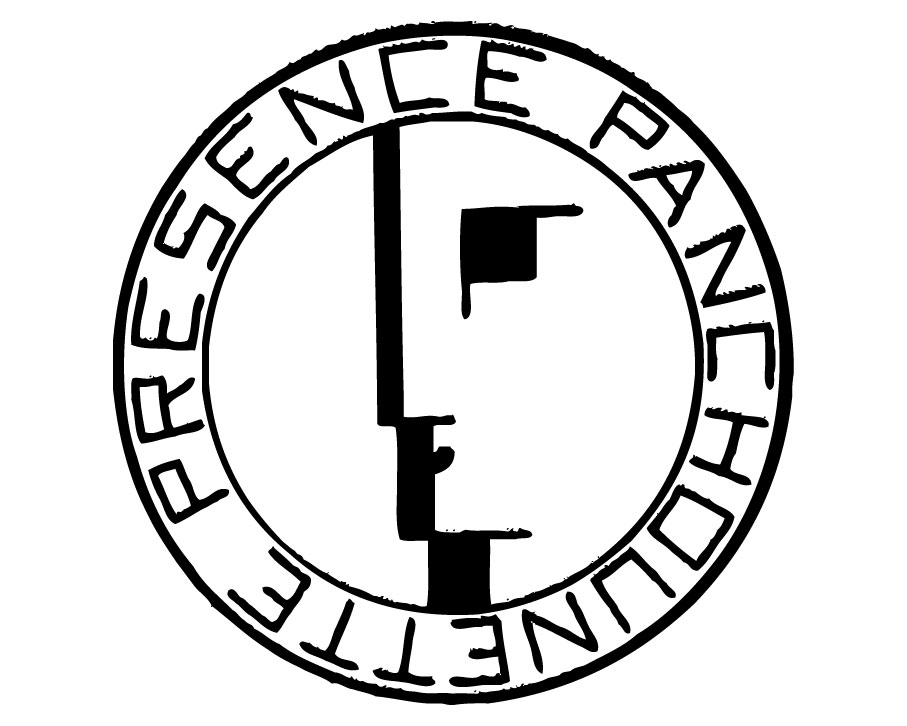To learn more about available works, please provide your contact information
“The works presented at Présence Panchounette - Section Africaine are the result of experimentation, trips, affinities and collaborations experienced by various members of the collective on the African continent, which went as far as the creation of the Gabonese Section of Présence Panchounette in 1974. Senegal, Cameroon, Nigeria and Benin were also visited in this spirit of creative migration. This overturning of the colonial/western vision of art, in favor of collaboration and encounters with artists, craftsmen and creators (without any hierarchical distinction) is viewed in a better light today, with our understanding of the globalized world and the contribution of post-colonial studies.”
Morad Montazami
“Whether in a knowingly modified painting from a studio in Conakry (the Portrait Devise series), a statuette-collage made up of radical juxtapositions and improbable assemblies, involving elements created by different artists thus brought to the fore by the Bordeaux collective, we always find this friction, the undermining of meanings and origins and the same delight in catch-all gestures.
At the time they were produced, during the seventies up until the mid-eighties, these works discharged a rare and sometimes unwelcome energy that is still intact today, but which was prophetic back then.”
Morad Montazami
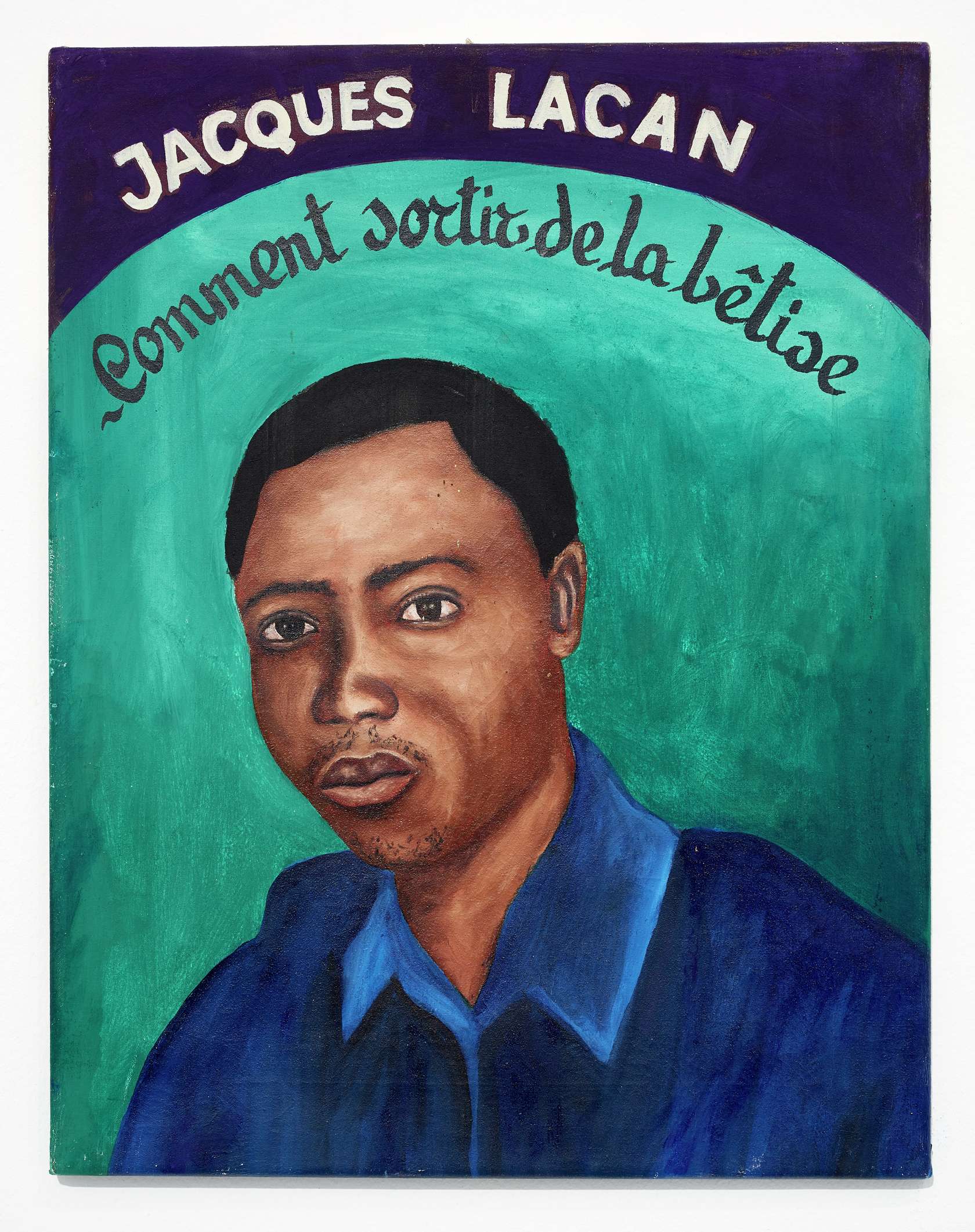
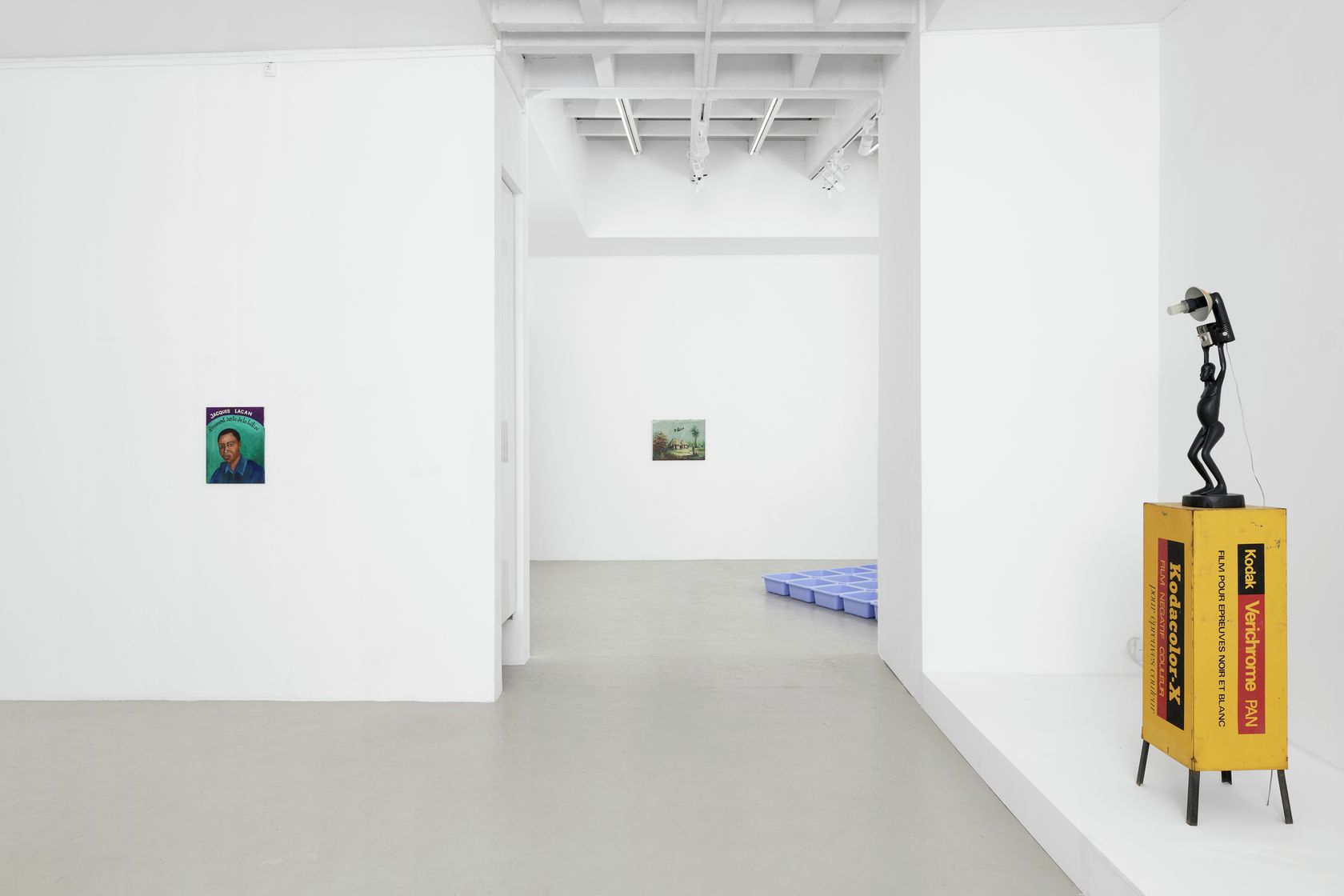
- Présence Panchounette
- Portrait devise Lacan , 1985
- Glycero paint and acrylic on canvas mounted on frame
-
- 45 ×
- 35 × cm
- 17 6/8 ×
- 13 6/8 × inches
-
Description | Description:
Ces portraits font partie de la série des “Portraits devise” de Présence Panchounette. Ce sont à l’origine des sortes de ready-mades car ils sont composés de portraits trouvés qui ont simplement subi une transformation. C’est particulièrement vrai pour Portrait devise Lacan, tableau d'un inconnu qui n'a pas honoré sa commande, trouvé dans un atelier de peinture en Guinée. Dans le même esprit, d’autres portraits, comme celui de F. Picabia et J. Kosuth, ont été commandés à l’artiste Sow Besse à Dakar (Sénégal). Les patronymes d’artistes et philosophes figurent dans un cartouche peint au-dessus du portrait, accompagnés de citations prononcées par leurs auteurs.
These (three) portraits are part of Présence Panchounette’s “Portraits devise” series. They are essentially ready-mades, made up of found portraits that have undergone simple transformations. This is particularly true of Portrait devise Lacan, a painting featuring an unknown person who hadn’t paid for the portrait he had ordered, which was later found in a painter’s studio in Guinea. Other portraits in the same style, such as those of “F. Picabia” and “J. Kosuth,” were commissioned from the Senegalese painter Sow Besse in Dakar. The names of various philosophers and artists appear above the portraits alongside statements made by those named.
Expositions | Exhibitions:
• Section Africaine, Semiose, Paris, exhibition from November 20, 2021 to January 1, 2022
• Présence Panchounette is not dead, CIAM La Fabrique, Toulouse, exhibition from May 9 to June 26, 2019
• Banlieues Sud - Expressions d’Afrique, CRAC Midi-Pyrénées, Labège-Innopole, Castanet-Tolosan, exhibition from December 13, 1986 to January 30, 1987
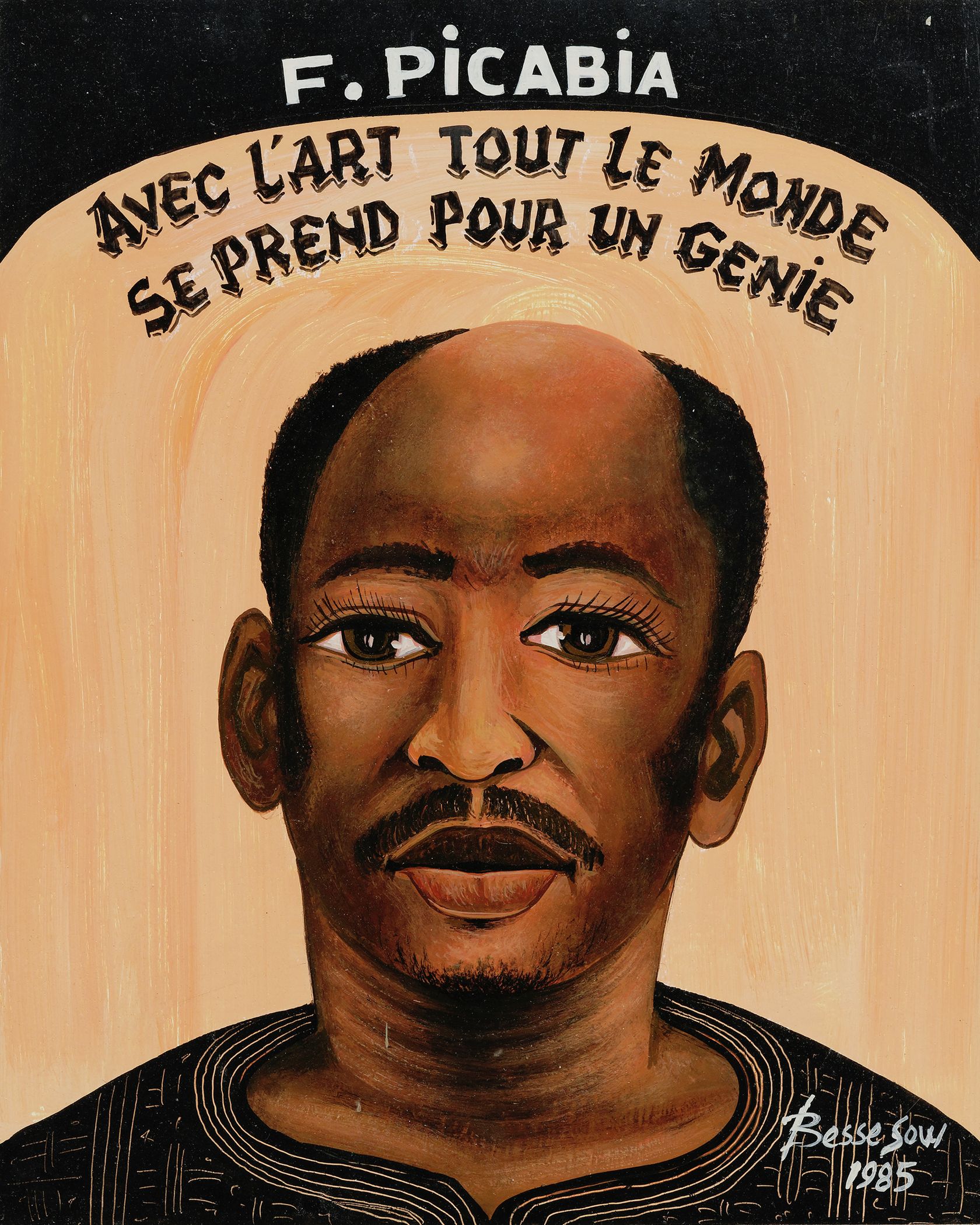
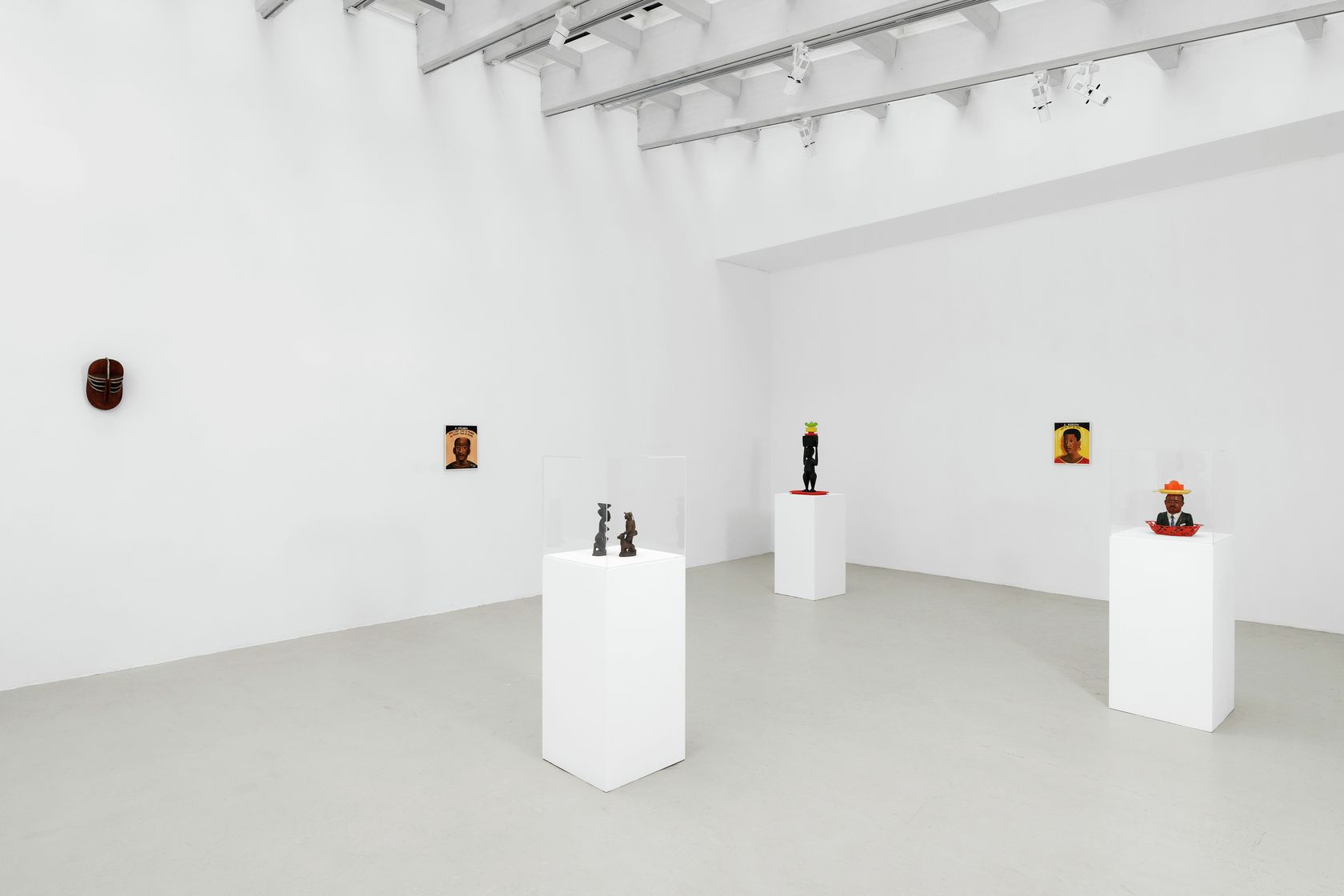
- Présence Panchounette
- Portrait devise F. Picabia , 1985
- Glycero paint on plywood
-
- 42 ×
- 34 × cm
- 16 1/2 ×
- 13 3/8 × inches
-
Expositions | Exhibitions:
• Section Africaine, Semiose, Paris, exhibition from November 20, 2021 to January 1, 2022
• Présence Panchounette is not dead, CIAM La Fabrique, Toulouse, exhibition from May 9 to June 26, 2019
Description | Description:
Ces portraits font partie de la série des “Portraits devise” de Présence Panchounette. Ce sont à l’origine des sortes de ready-mades car ils sont composés de portraits trouvés qui ont simplement subi une transformation. C’est particulièrement vrai pour Portrait devise Lacan, tableau d'un inconnu qui n'a pas honoré sa commande, trouvé dans un atelier de peinture en Guinée. Dans le même esprit, d’autres portraits, comme celui de F. Picabia et J. Kosuth, ont été commandés à l’artiste Sow Besse à Dakar (Sénégal). Les patronymes d’artistes et philosophes figurent dans un cartouche peint au-dessus du portrait, accompagnés de citations prononcées par leurs auteurs.
These (three) portraits are part of Présence Panchounette’s “Portraits devise” series. They are essentially ready-mades, made up of found portraits that have undergone simple transformations. This is particularly true of Portrait devise Lacan, a painting featuring an unknown person who hadn’t paid for the portrait he had ordered, which was later found in a painter’s studio in Guinea. Other portraits in the same style, such as those of “F. Picabia” and “J. Kosuth,” were commissioned from the Senegalese painter Sow Besse in Dakar. The names of various philosophers and artists appear above the portraits alongside statements made by those named.
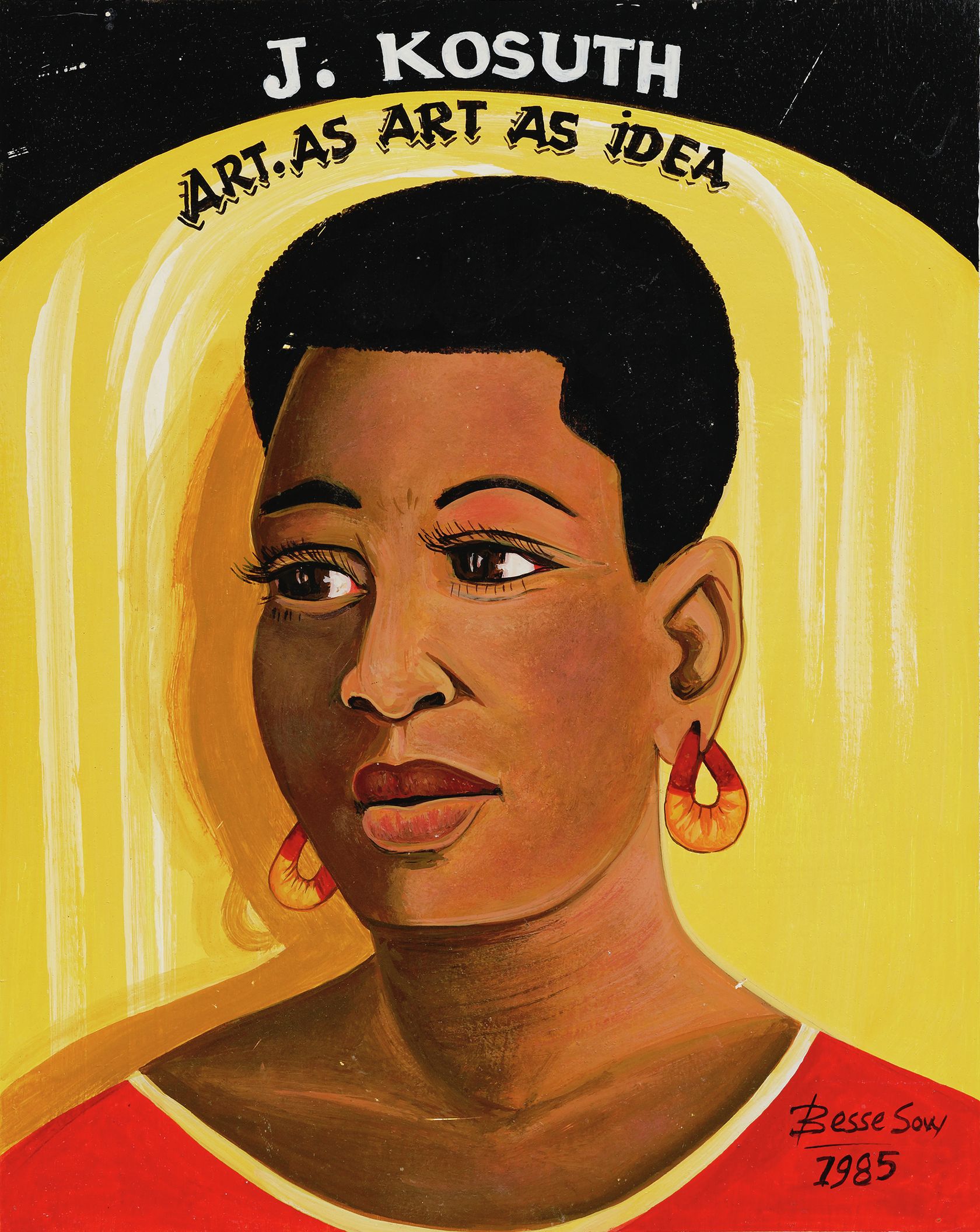
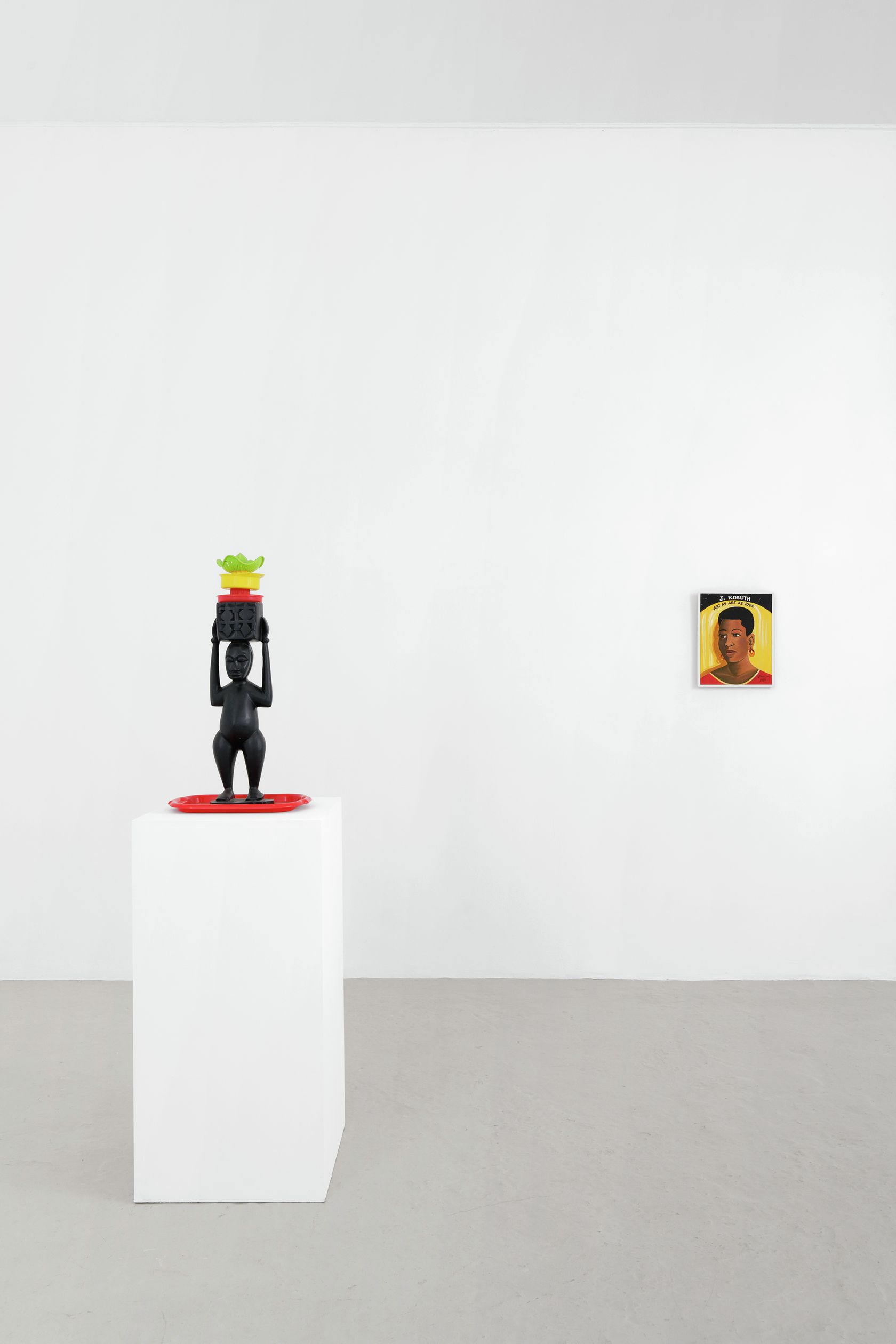
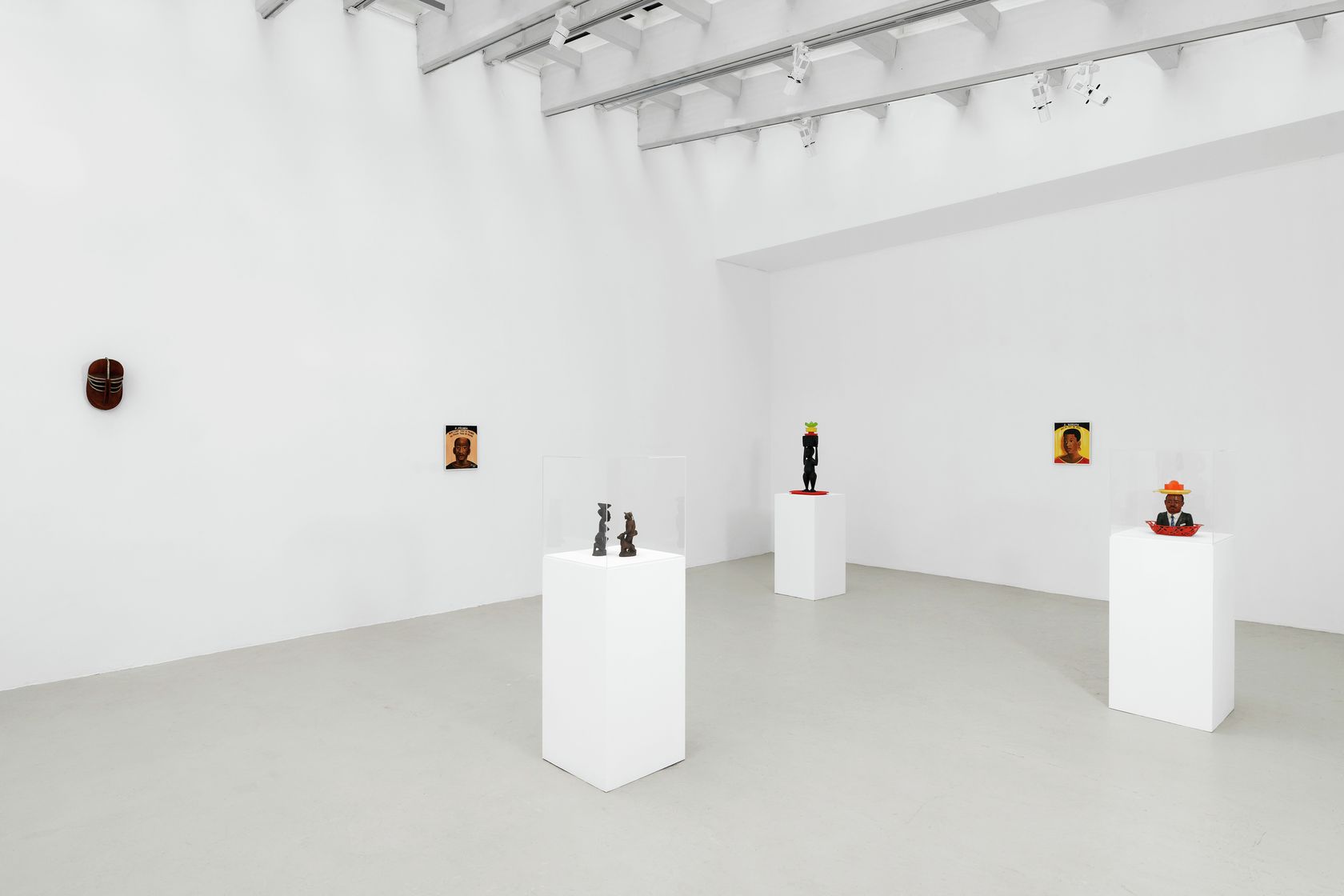
- Présence Panchounette
- Portrait devise J. Kosuth , 1985
- Glycero paint on plywood
-
- 42 ×
- 34 × cm
- 16 1/2 ×
- 13 3/8 × inches
-
Description | Description:
Ces portraits font partie de la série des “Portraits devise” de Présence Panchounette. Ce sont à l’origine des sortes de ready-mades car ils sont composés de portraits trouvés qui ont simplement subi une transformation. C’est particulièrement vrai pour Portrait devise Lacan, tableau d'un inconnu qui n'a pas honoré sa commande, trouvé dans un atelier de peinture en Guinée. Dans le même esprit, d’autres portraits, comme celui de F. Picabia et J. Kosuth, ont été commandés à l’artiste Sow Besse à Dakar (Sénégal). Les patronymes d’artistes et philosophes figurent dans un cartouche peint au-dessus du portrait, accompagnés de citations prononcées par leurs auteurs.
These (three) portraits are part of Présence Panchounette’s “Portraits devise” series. They are essentially ready-mades, made up of found portraits that have undergone simple transformations. This is particularly true of Portrait devise Lacan, a painting featuring an unknown person who hadn’t paid for the portrait he had ordered, which was later found in a painter’s studio in Guinea. Other portraits in the same style, such as those of “F. Picabia” and “J. Kosuth,” were commissioned from the Senegalese painter Sow Besse in Dakar. The names of various philosophers and artists appear above the portraits alongside statements made by those named.
Expositions | Exhibitions:
• Section Africaine, Semiose, Paris, exhibition from November 20, 2021 to January 1, 2022
• Présence Panchounette is not dead, CIAM La Fabrique, Toulouse, exhibition from May 9 to June 26, 2019
The sculpture La Villa des Ancêtres is an important work for several reasons. Firstly, due to its large format; secondly, because its main element, a coffin, was commissioned from the Ghanaian artist Kane Kwei (1922-1992), who was famous for sculpting “fantasy” coffins, personalized according to the tastes of the deceased (taking the shape of cars, fish, etc.); thirdly, due to the fact that the coffin contains painted wooden, anthropomorphic figures of various origins (Benin, Ivory Coast, Togo, Sierra Leone, Ghana), representing fetishes, ancestors and colonists, all brought together under the scathing and polemical title: La Villa des Ancêtres.
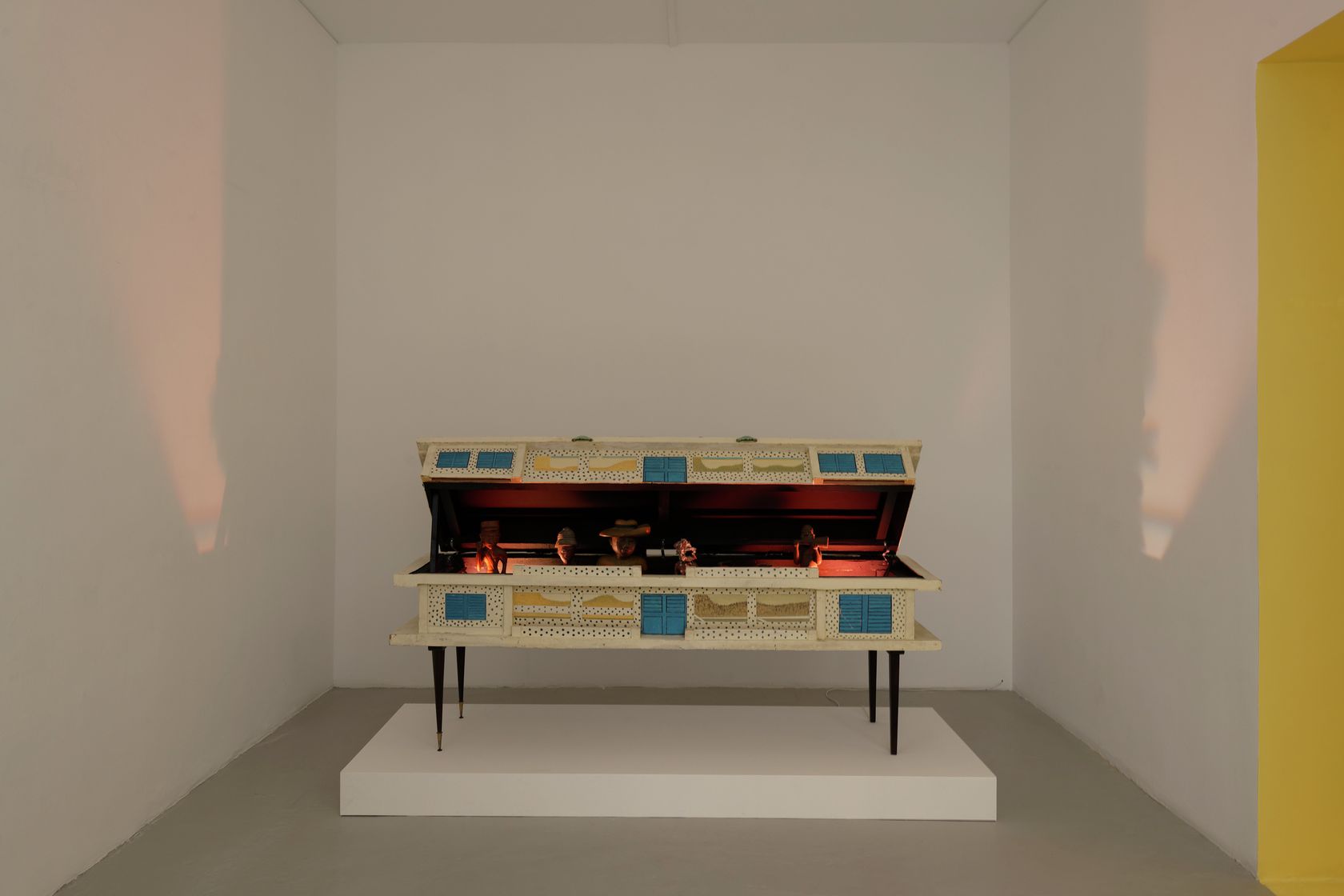
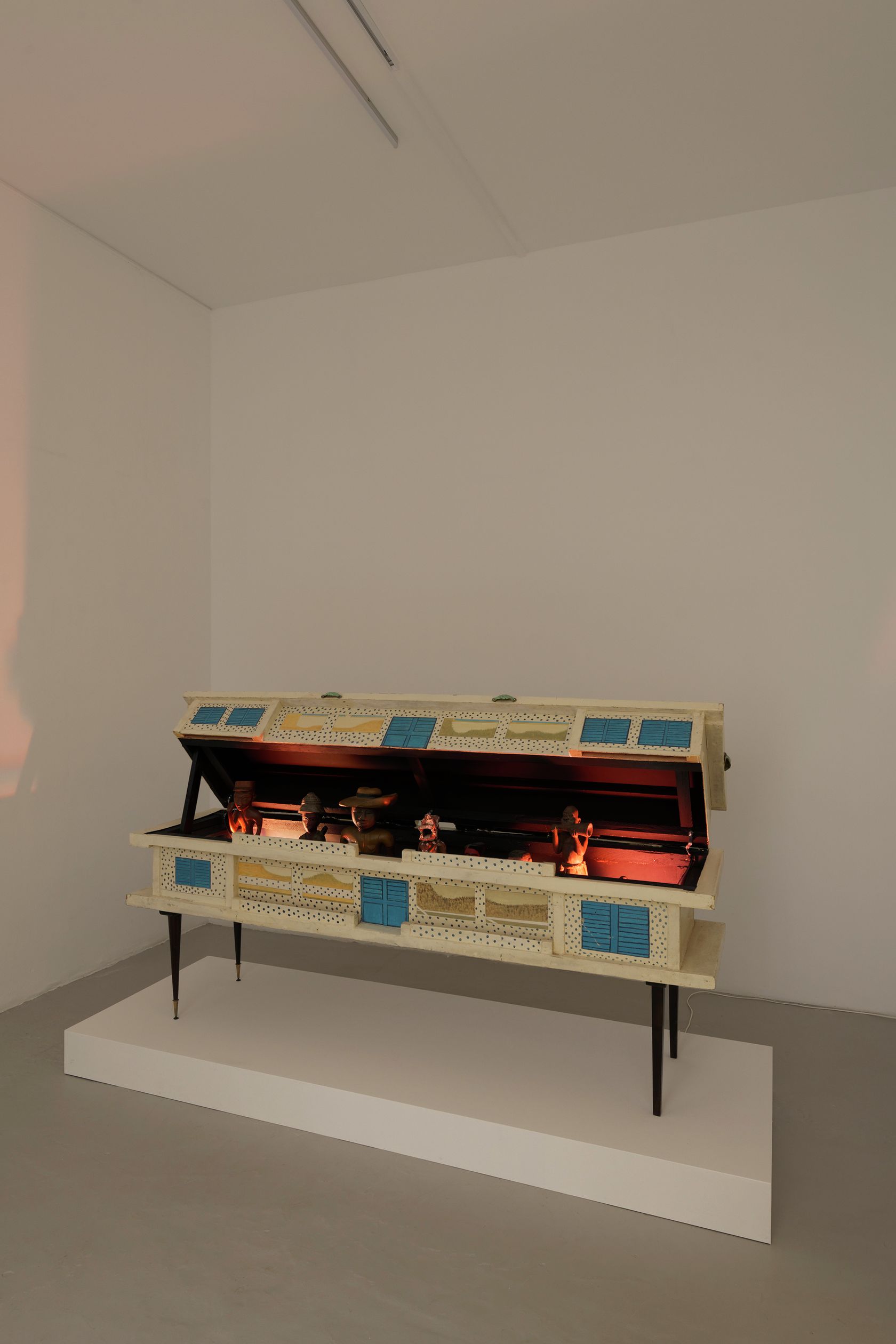
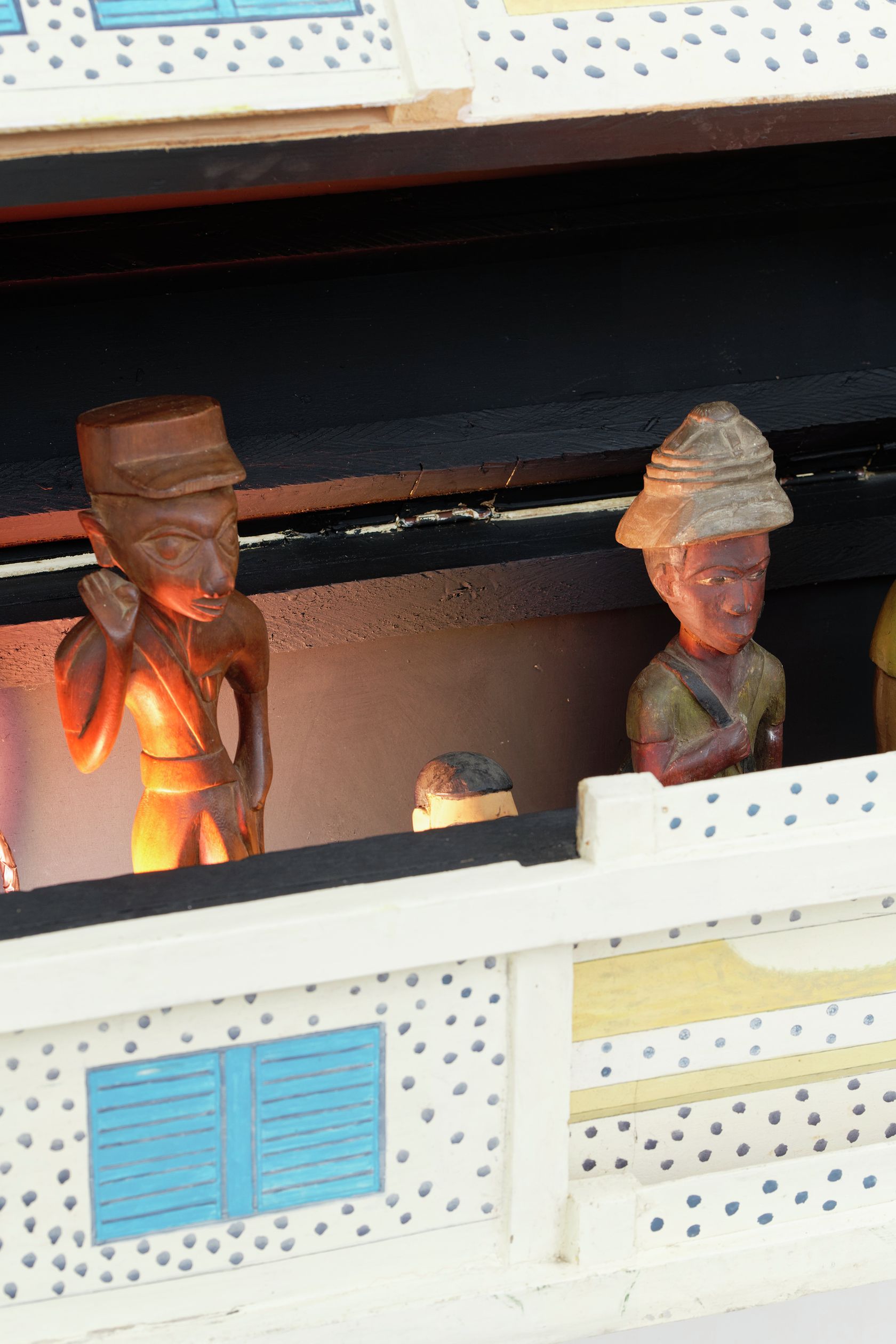
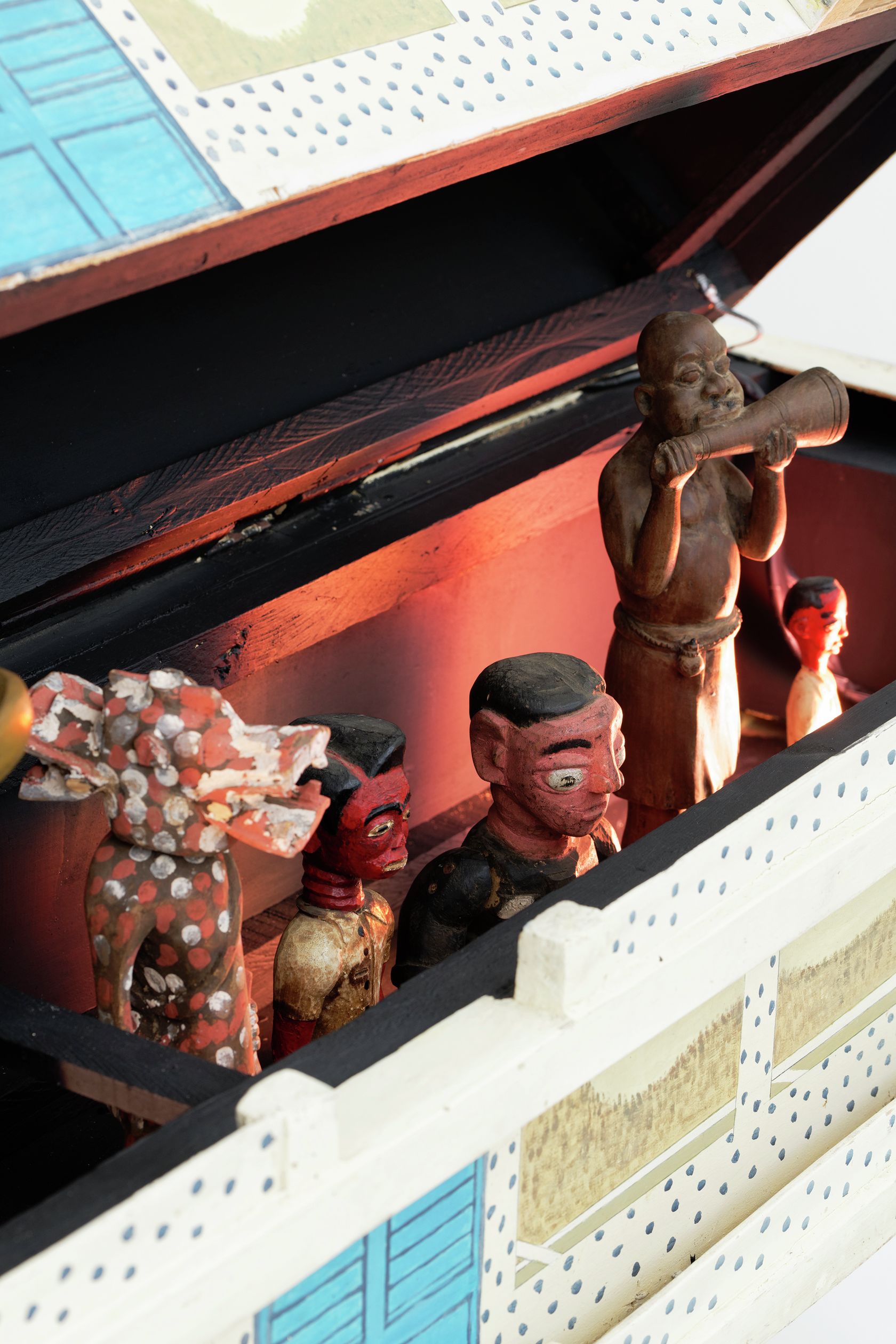
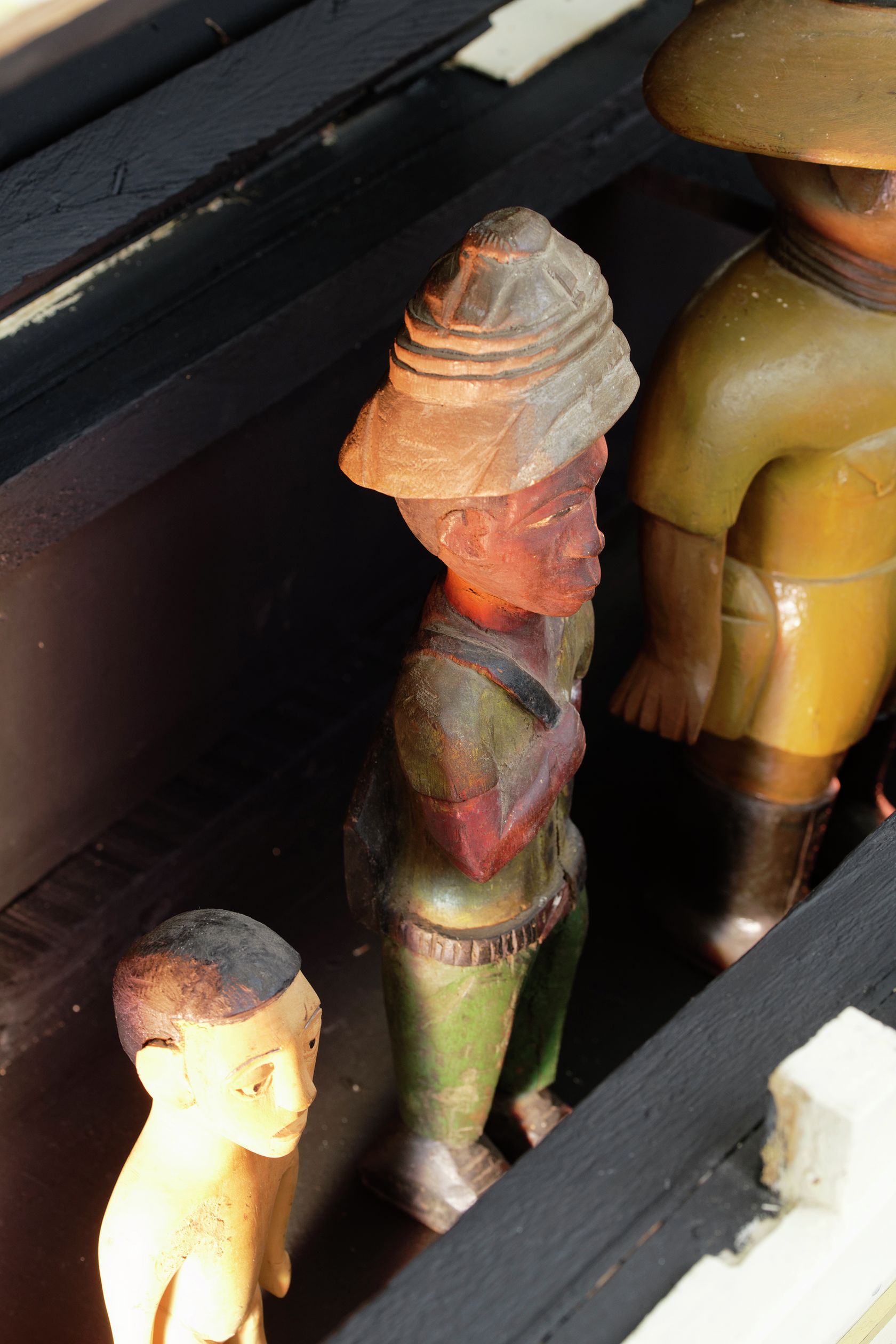
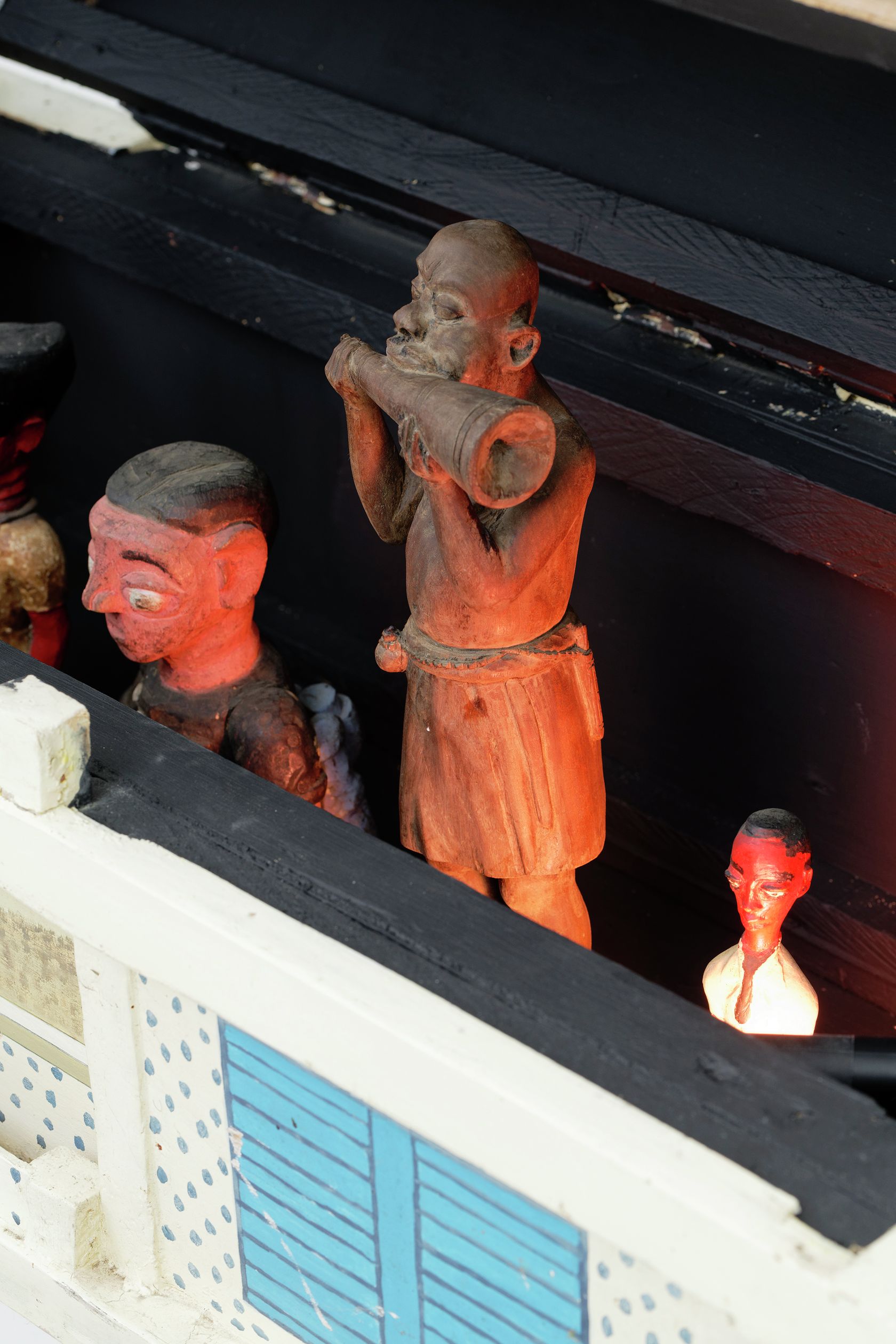
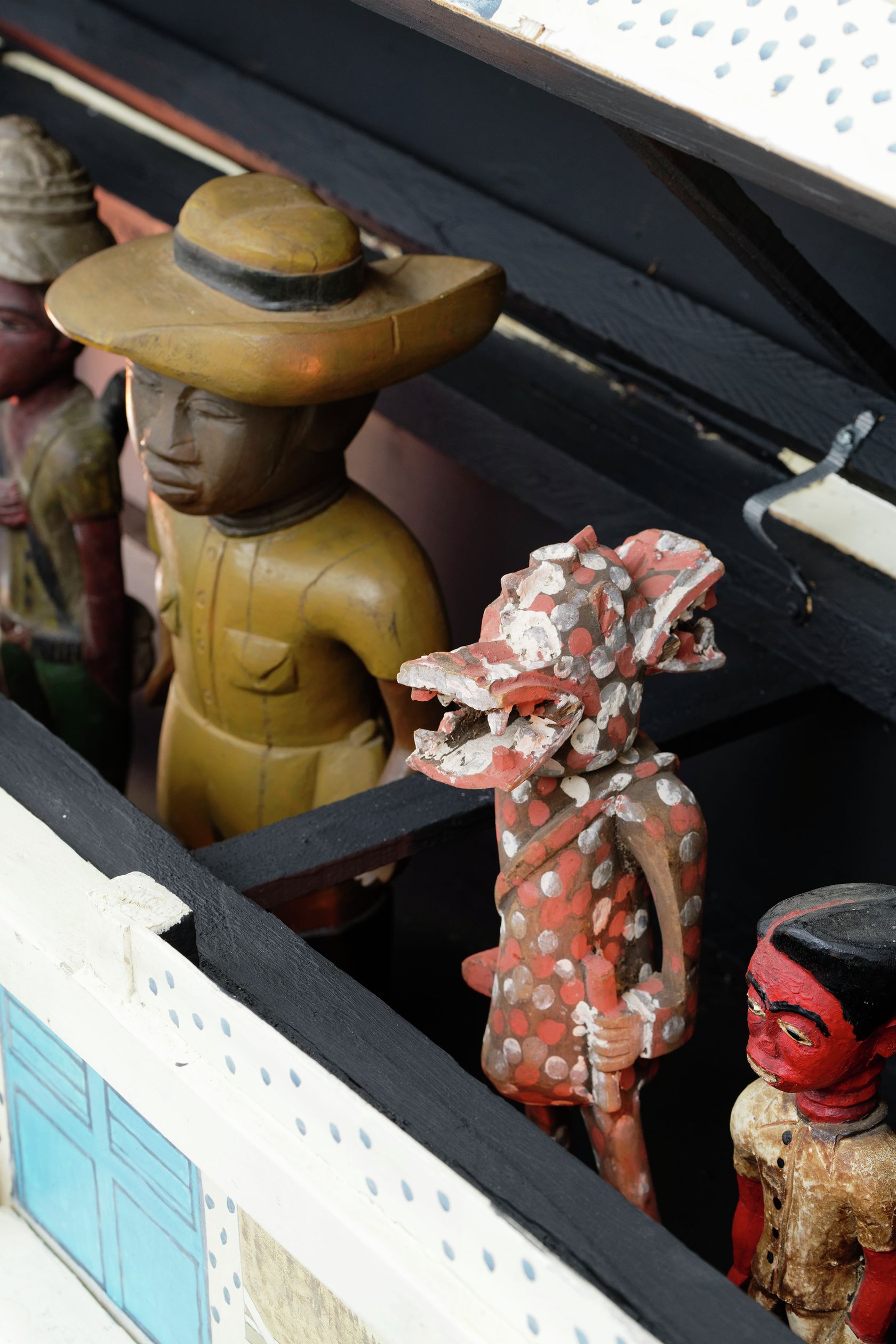
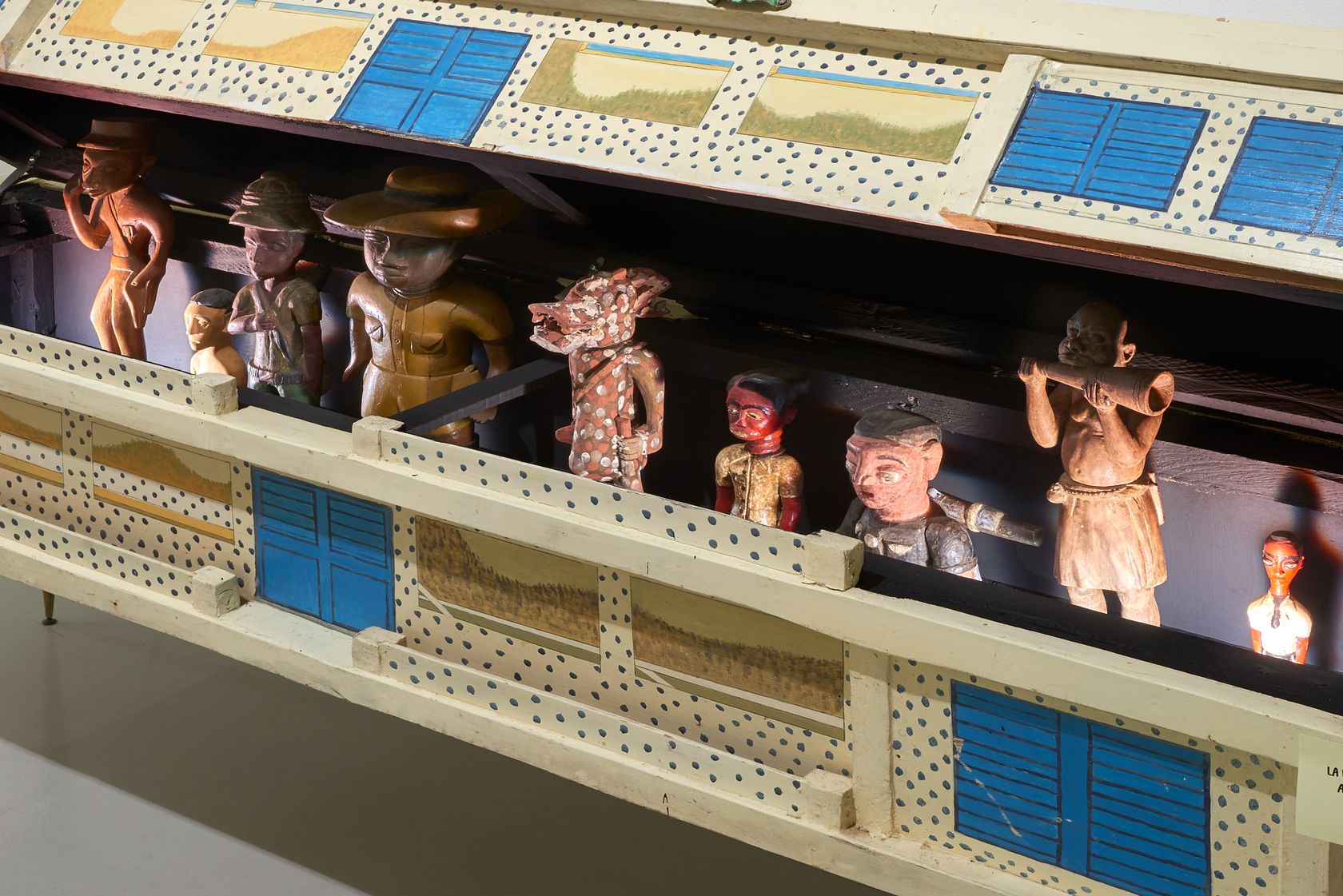
- Présence Panchounette
- La Villa des ancêtres , 1985-1986
- Wooden villa-shaped coffin by Kane Kwei (Ghana), painted wooden statues (Colonist gendarme Fon, Benin - Ewe ancester statue, Togo - Baoulé colonist, Côte d'Ivoire - Mende colonist, Sierra Leone - Sénoufo fetish, Côte d'Ivoire - Agni ancester statue, Côte d'Ivoire - Ewe ancester statue, Ghana - Akan flutist, Ghana - Agni ancester statue, Côte d'Ivoire) and mobile lighting
-
- 52 ×
- 202 ×
- 50 × cm
- 20 1/2 ×
- 79 1/2 ×
- 19 11/16 × inches
-
Description | Description:
La sculpture La Villa des ancêtres est importante à plusieurs titres. D’abord par ses grandes dimensions ; ensuite parce que l’élément principal, le cercueil, a été commandé à l’artiste ghanéen Kane Kwei (1922-1992), célèbre par son innovation à sculpter des cercueils “fantaisie” dans des formes personnalisées en fonction du défunt (voitures, poissons, etc.) ; enfin parce que le cercueil contient des statuettes anthropomorphes en bois peintes de différentes origines (Bénin, Côte d'Ivoire, Togo, Sierra Leone, Ghana), représentant tantôt des fétiches, tantôt des ancêtres, tantôt des colons, réunis sous un titre aussi grinçant que polémique : La Villa des ancêtres.
The sculpture La Villa des Ancêtres is an important work for several reasons. Firstly, due to its large format; secondly, because its main element, a coffin, was commissioned from the Ghanaian artist Kane Kwei (1922-1992), who was famous for sculpting “fantasy” coffins, personalized according to the tastes of the deceased (taking the shape of cars, fish, etc.); thirdly, due to the fact that the coffin contains painted wooden, anthropomorphic figures of various origins (Benin, Ivory Coast, Togo, Sierra Leone, Ghana), representing fetishes, ancestors and colonists, all brought together under the scathing and polemical title: La Villa des Ancêtres.
Expositions | Exhibitions:
• Section Africaine, Semiose, Paris, exhibition from November 20, 2021 to January 1, 2022
• Présence Panchounette is not dead, CIAM La Fabrique, Toulouse, exhibition from May 9 to June 26, 2019
• Aquitaine Afriques contact zones, Iwalewahaus, Bayreuth, exhibition from April 26 to September 2, 2012
• Less is Less More is More, that's all !, CAPC, Bordeaux, exhibition from May 30 to September 14, 2008
• Banlieues Sud - Expressions d’Afrique, CRAC Midi-Pyrénées, Labège-Innopole, Castanet-Tolosan, exhibition from December 13, 1986 to January 30, 1987
With the installation Disco Boy, Présence Panchounette created a sort of “trashy Africa”, illustrated with hyper-realistic sculptures in wood and African popular music. The collective's association with Africa goes back to 1974, when the Gabonese branch of Présence Panchounette was founded and continued when one of its members travelled to West Africa. This research culminated in joint projects with local artists, in particular Nicolas Damas (1947-2001, Ivory Coast), a sculptor of life-size figures for various rituals in his community. For Présence Panchounette, he constructed a collection of objects and figures consisting of Disco Boy, Pépouze, and Traffic various other secondary characters, a jungle and Kilimandjaro. Three years before Jean-Hubert Martin's Magiciens de la Terre exhibition at the Pompidou Center in Paris, this installation illustrated this back-and-forth exchange of ideas as well as the reality of the relationship between colonists and those colonized. With this in mind, Disco Boy can be considered as the sculpture of a certain archetype, an African sculptor might imagine to be seen by a European. Viewed as post-colonial art, the African offshoot of Présence Panchounette flourished on the familiar terrain of misappropriation and misrepresentation-hijacking, as Jacques Soulillou put it—and in the crevices that prejudice and exotic fantasies inhabit.
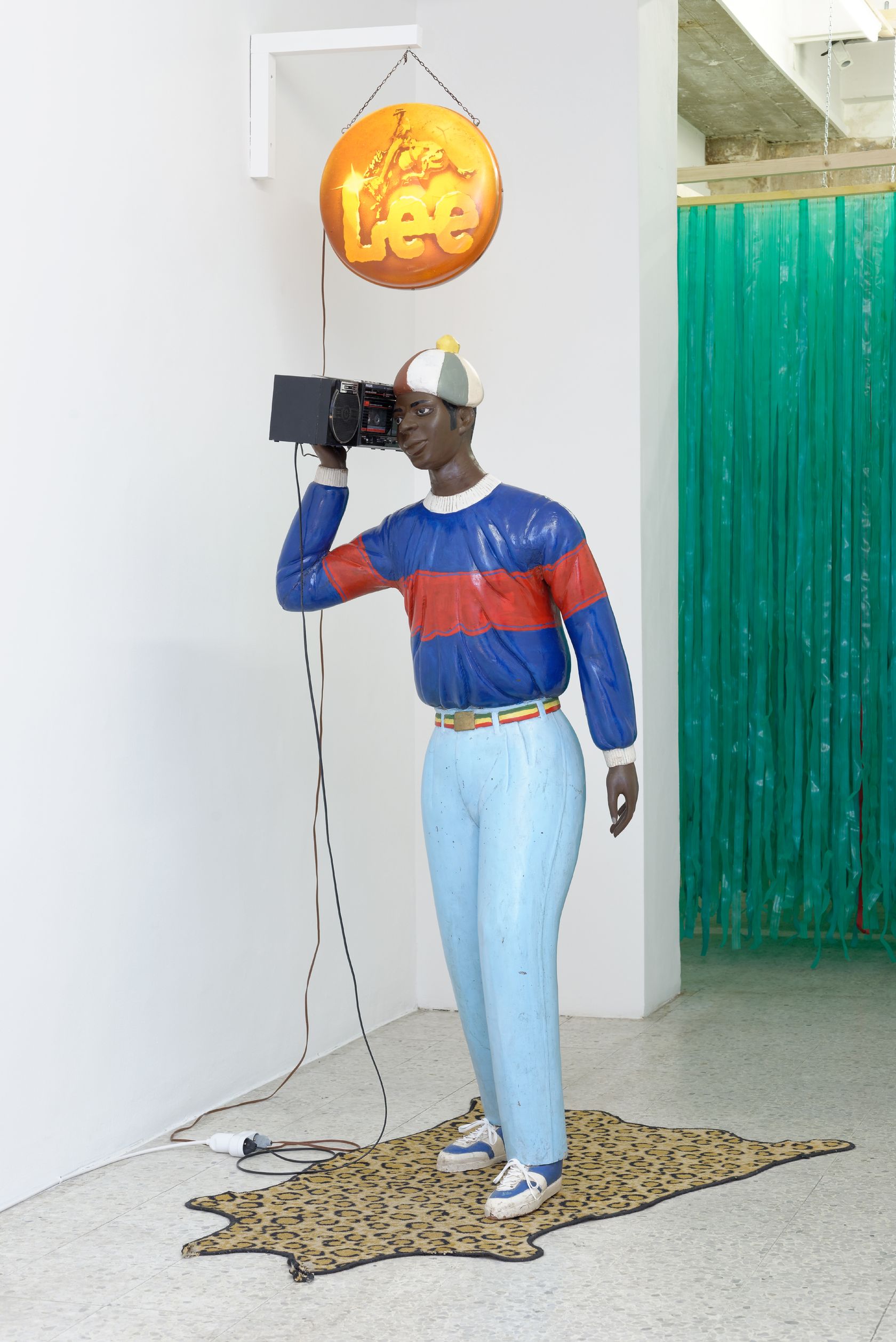
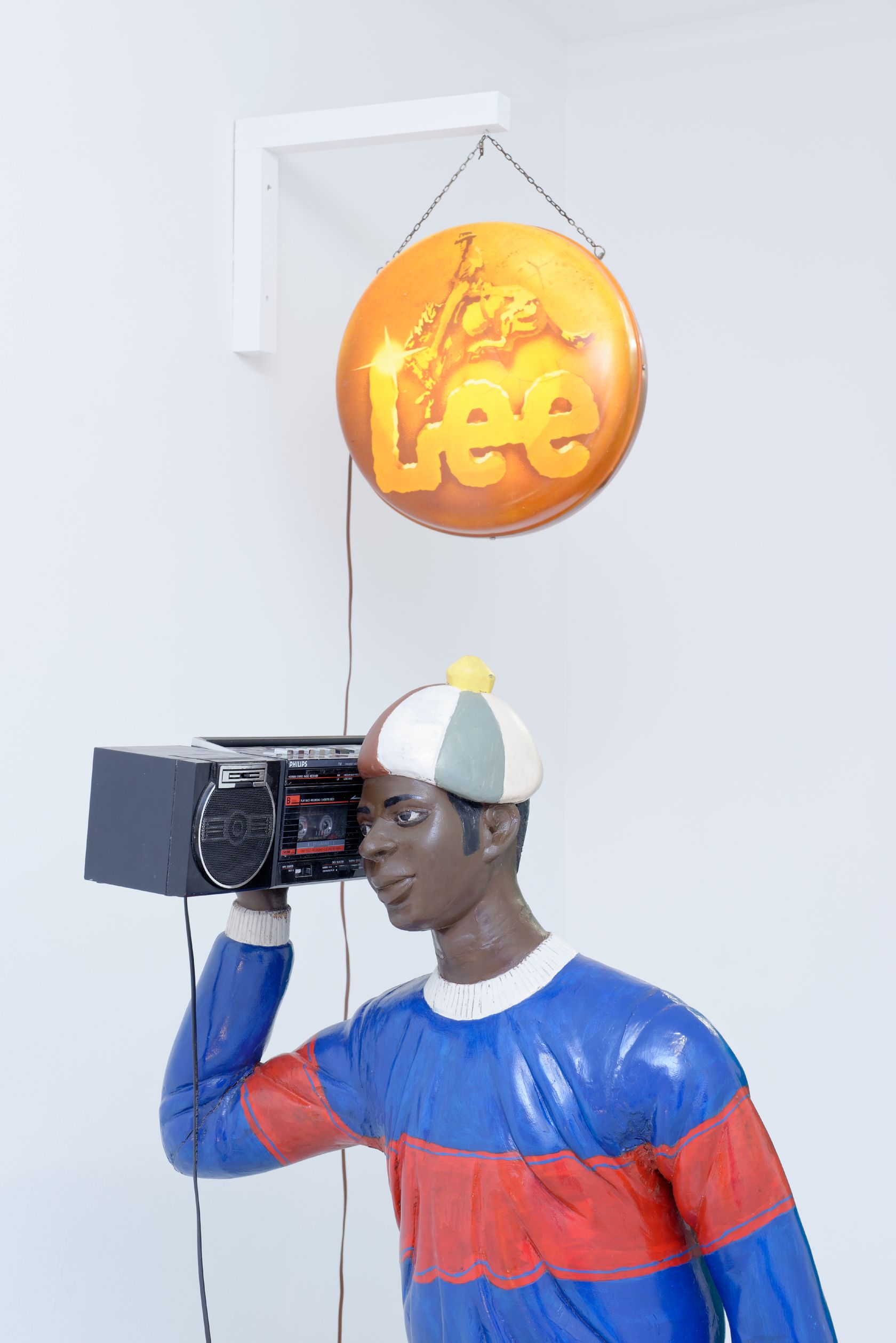
- Présence Panchounette
- Disco Boy , 1985
- Painted wood sculpture (executed by Nicolas Damas), ghetto blaster and audio tape, carpet and neon sign
-
- 174 ×
- 68 × cm
- 68 1/2 ×
- 26 6/8 × inches
-
Expositions | Exhibitions:
• Section Africaine, Semiose, Paris, exhibition from November 20, 2021 to January 1, 2022
• Présence Panchounette, Semiose, Paris, exhibition from September 3 to October 8, 2016
• Festival Sam'Africa, Samatan, exhibition from September 2 to 4, 2016
• Less is Less More is More, that's all !, CAPC, Bordeaux, exhibition from May 30 to September 14, 2008
• Banlieues Sud - Expressions d’Afrique, Musée des beaux-arts de Calais, Calais, exhibition from July 2 to September 29, 1987
• Banlieues Sud - Expressions d’Afrique, CRAC Midi-Pyrénées, exhibition from December 13, 1986 to January 30, 1987
Bibliographie | Bibliography:
• MILLET, Catherine, SOULILLOU, Jacques, “Présence Panchounette”, Pleased to meet you, n°7, Paris, Semiose éditions, 2019, Repr. p. 65.
• VIDAL, Pauline, “Art Brussels maintient le cap”, Le Journal des Arts, n°478, April 28th, 2017, Repr. p. 32.
• CASTERÁN, Dominique, DANESI, Fabien, FABRE, Eric, LAUBARD, Charlotte, MARCCADÉ, Bernard, OSTERWOLD, Tilman, et al., Présence Panchounette, CAPC Bordeaux / Les Presses du Réel, Dijon, 2011.
Description | Description:
Avec l’installation Disco Boy, Présence Panchounette crée une “Afrique de pacotille” servie par des sculptures réalistes sur bois et une musique populaire africaine. Les accointances du collectif avec le continent africain remontent à 1974, lorsqu'est fondée la section gabonaise Présence Panchounette, puis à 1983, lors du voyage de l'un de ses membres en Afrique de l'Ouest, parti étudier “les influences urbaines sur l'art africain”. Cela aboutit sur des collaborations avec des artistes locaux, en particulier Nicolas Damas (1947-2001, Côte d'Ivoire), sculpteur de figures à taille réelle pour les besoins rituels de sa communauté, et auteur pour Présence Panchounette de l'ensemble composé du Disco Boy, de la Pépouze, de Traffic et d'ambianceurs, complété d'une jungle et du Kilimandjaro. Trois ans avant l'exposition Magiciens de la Terre au Centre Pompidou – à laquelle le collectif n’a pas participé – cet ensemble révèle les mouvements de navette des relations colon-colonisé, entre projections et réalités. À ce titre, Disco Boy peut se concevoir comme la sculpture d'un archétype tel que le sculpteur africain l'imagine vu par un Européen. Qualifiée d'art post-colonial, la veine africaine de Présence Panchounette s'épanouit sur son terrain familier des détournements et récupérations – ce que Jacques Soulillou nommait le ravissement – et dans les écarts où se logent les préjugés et les fantasmes d'exotisme.
With the installation Disco Boy, Présence Panchounette created a sort of “trashy Africa”, illustrated with hyper-realistic sculptures in wood and African popular music. The collective's association with Africa goes back to 1974, when the Gabonese branch of Présence Panchounette was founded and continued when one of its members travelled to West Africa to study “urban influence on African art.” This research culminated in joint projects with local artists, in particular Nicolas Damas (1947-2001, Ivory Coast), a sculptor of life-sized figures for various rituals in his community. For Présence Panchounette, he constructed a collection of objects and figures consisting of Disco Boy, Pépouze, and Traffic, various other secondary characters, a jungle and Kilimandjaro. Three years before Jean-Hubert Martin's Magiciens de la Terre exhibition at the Pompidou Center in Paris—to which the collective was not invited—this installation illustrated this back-and-forth exchange of ideas as well as the reality of the relationship between colonists and those colonized. With this in mind, Disco Boy can be considered as the sculpture of a certain archetype, an African sculptor might imagine to be seen by a European. Viewed as post-colonial art, the African offshoot of Présence Panchounette flourished on the familiar terrain of misappropriation and misrepresentation—hijacking, as Jacques Soulillou put it—and in the crevices that prejudice and exotic fantasies inhabit.
The title Magicienne de l’eau alludes to the exhibition “Les Magiciens de la Terre” (1987), which was at the time being prepared for the Pompidou Center by Jean-Hubert Martin. Martin had solicited the help of Présence Panchounette in contacting various African artists, whilst neglecting to invite the collective to participate in the exhibition. The work demonstrates Présence Panchounette’s profound interest in and respect for the symbolism inherent in African cultures. They commissioned the Togolese Vodun sculptor Agbagli Kossi to produce a statue of Mami Wata, the Vodun spirit of water, particularly revered in West Africa (Togo, Benin and Nigeria). This spirit is often described as being half woman, half fish, and is accompanied by a snake, a symbol of wisdom. The recurrent representation of the female snake spirit in Africa first appeared at the end of the 19th century, inspired by images of Hindu goddesses distributed by Indian traders. The statue’s headdress evokes the silhouette of an Indian temple. In this work, the spirit has been “modernized” by Présence Panchounette, updated with objects used on a daily basis on the African continent as well as by being exposed to the relatively recent ritual of throwing coins into water. Magicienne de l’eau was first shown in the exhibition “Banlieues Sud – Expressions d’Afrique” at the Center for Contemporay Art (CAC) in Labège in 1986, which was a kind of antithesis of the exhibitions of contemporary African art organized at the time, which were judged to be naïve and condescending.
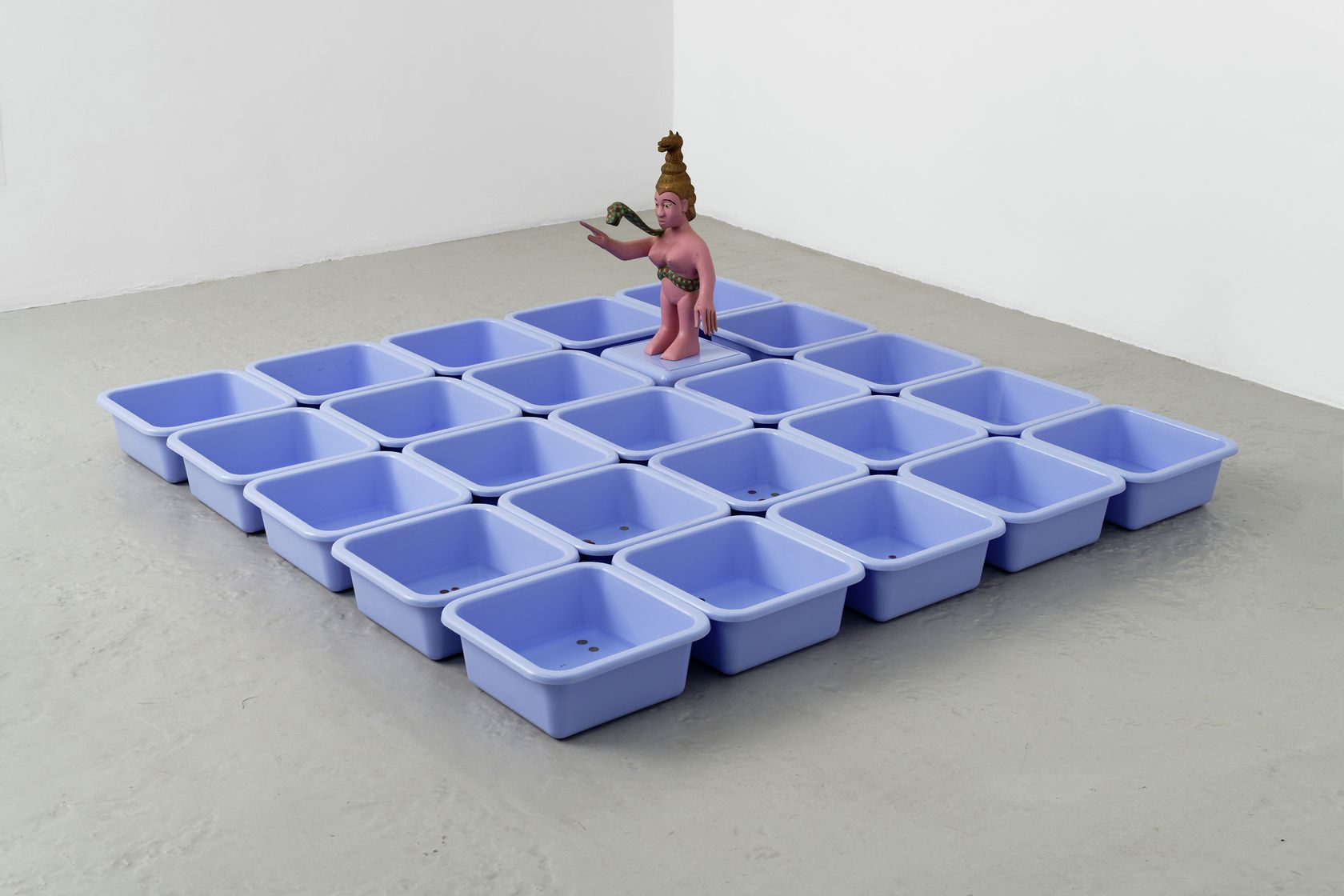
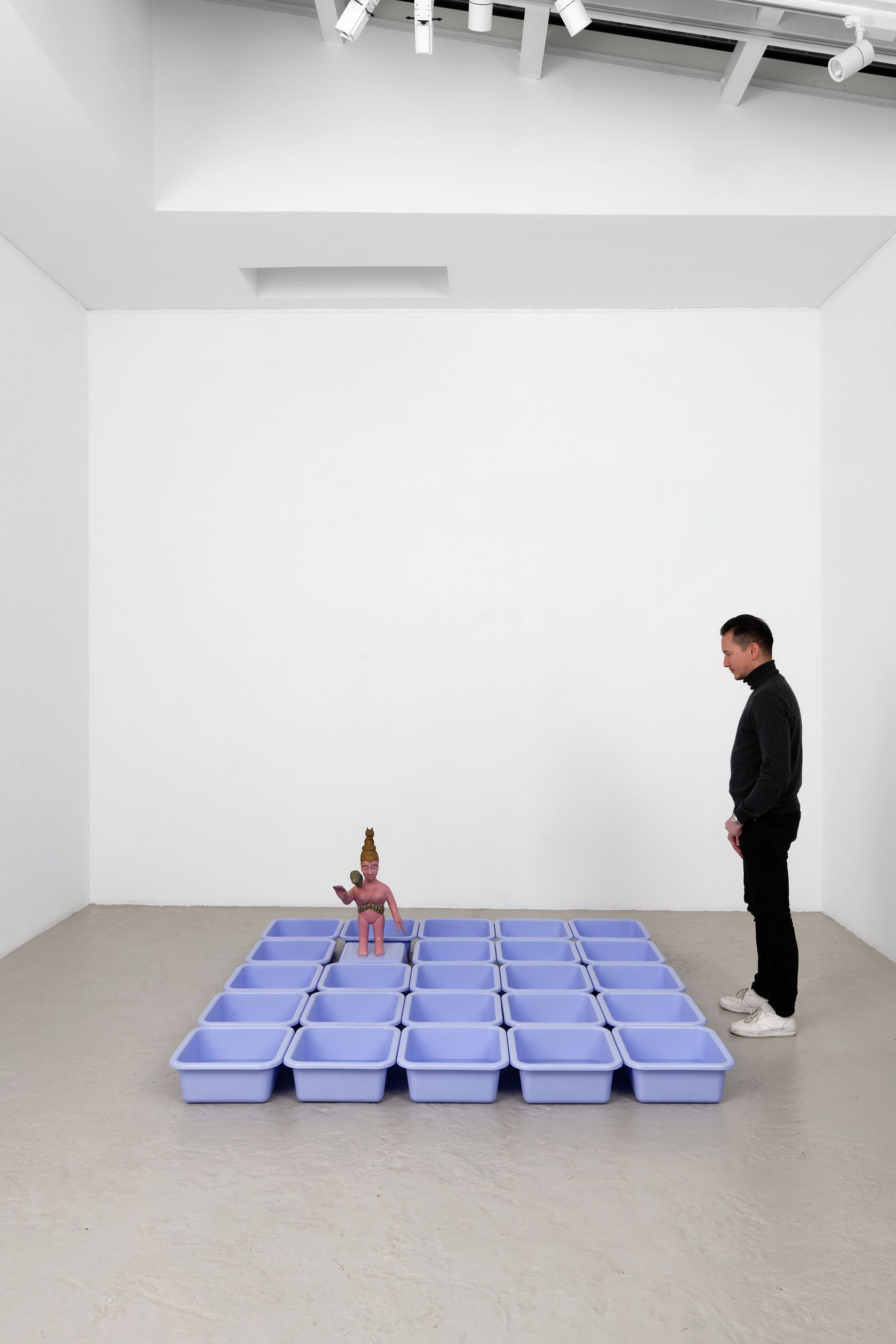
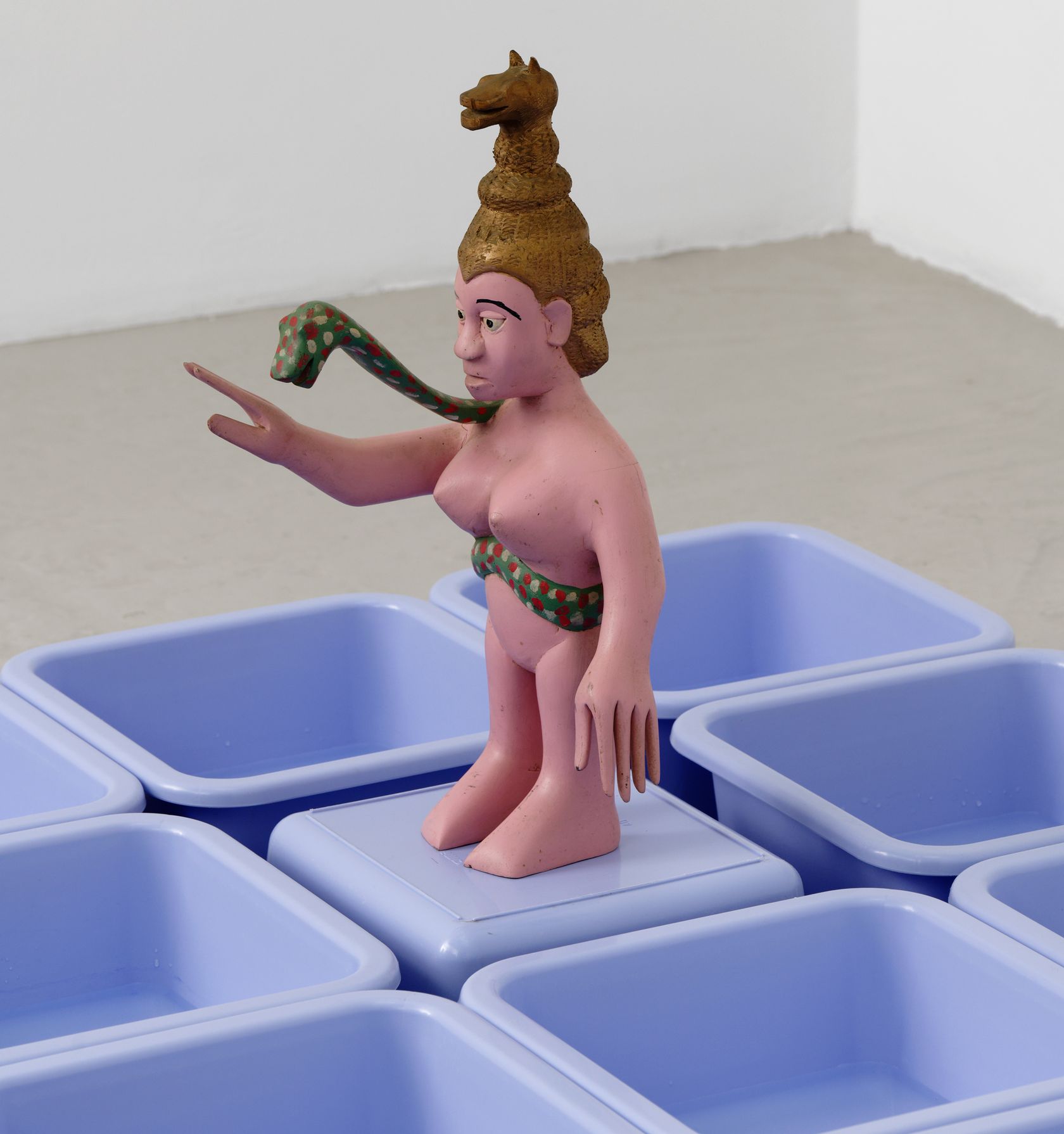
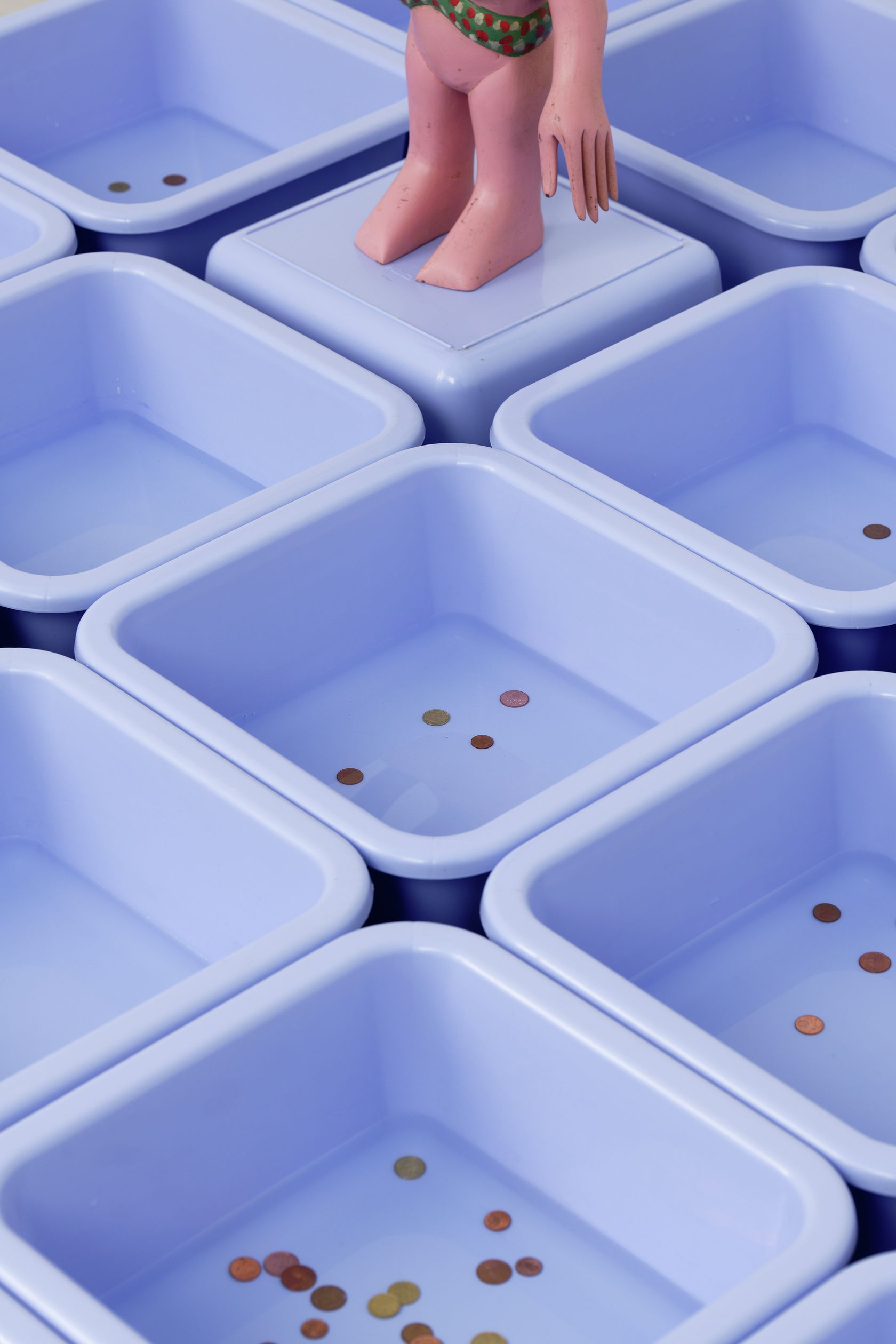
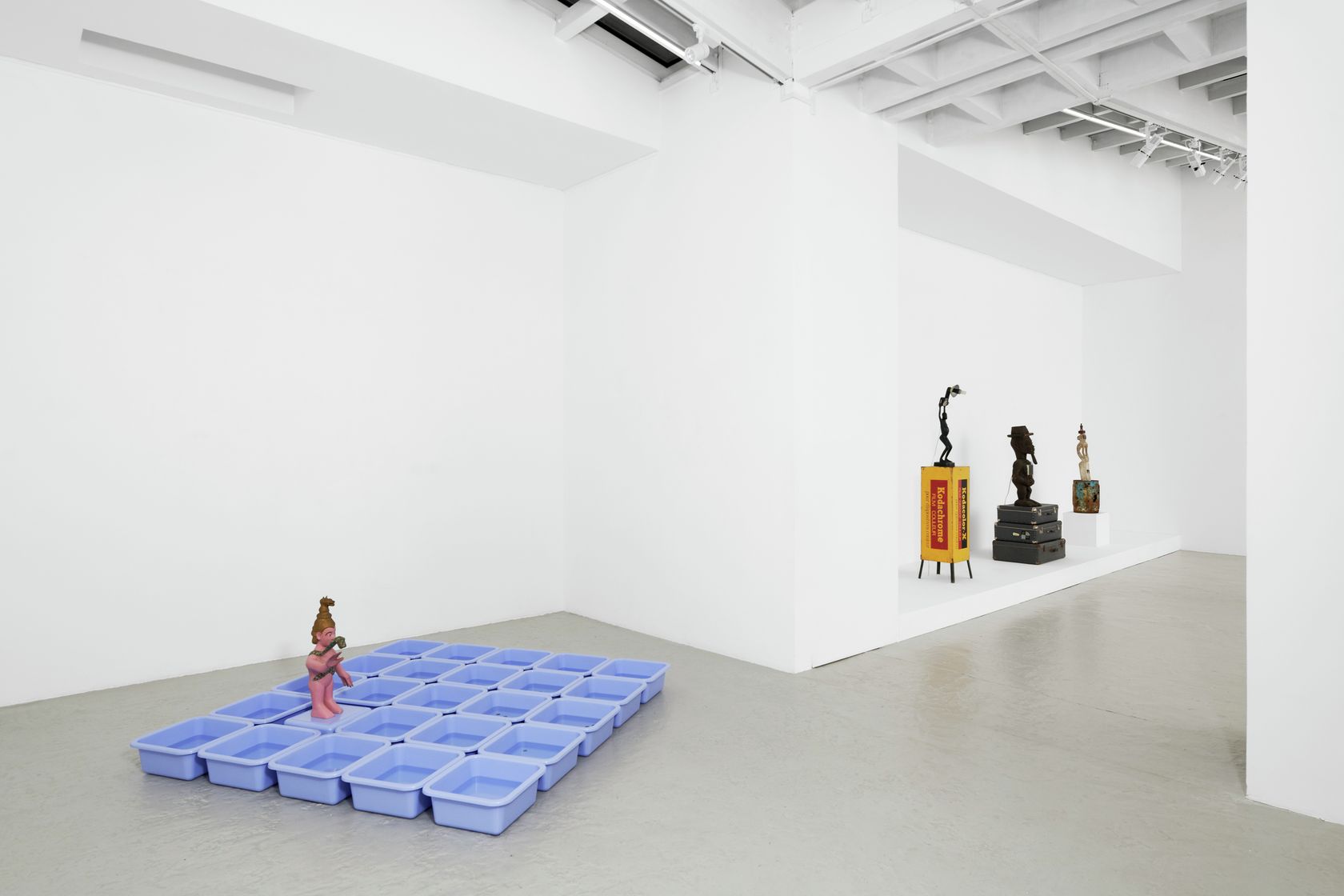
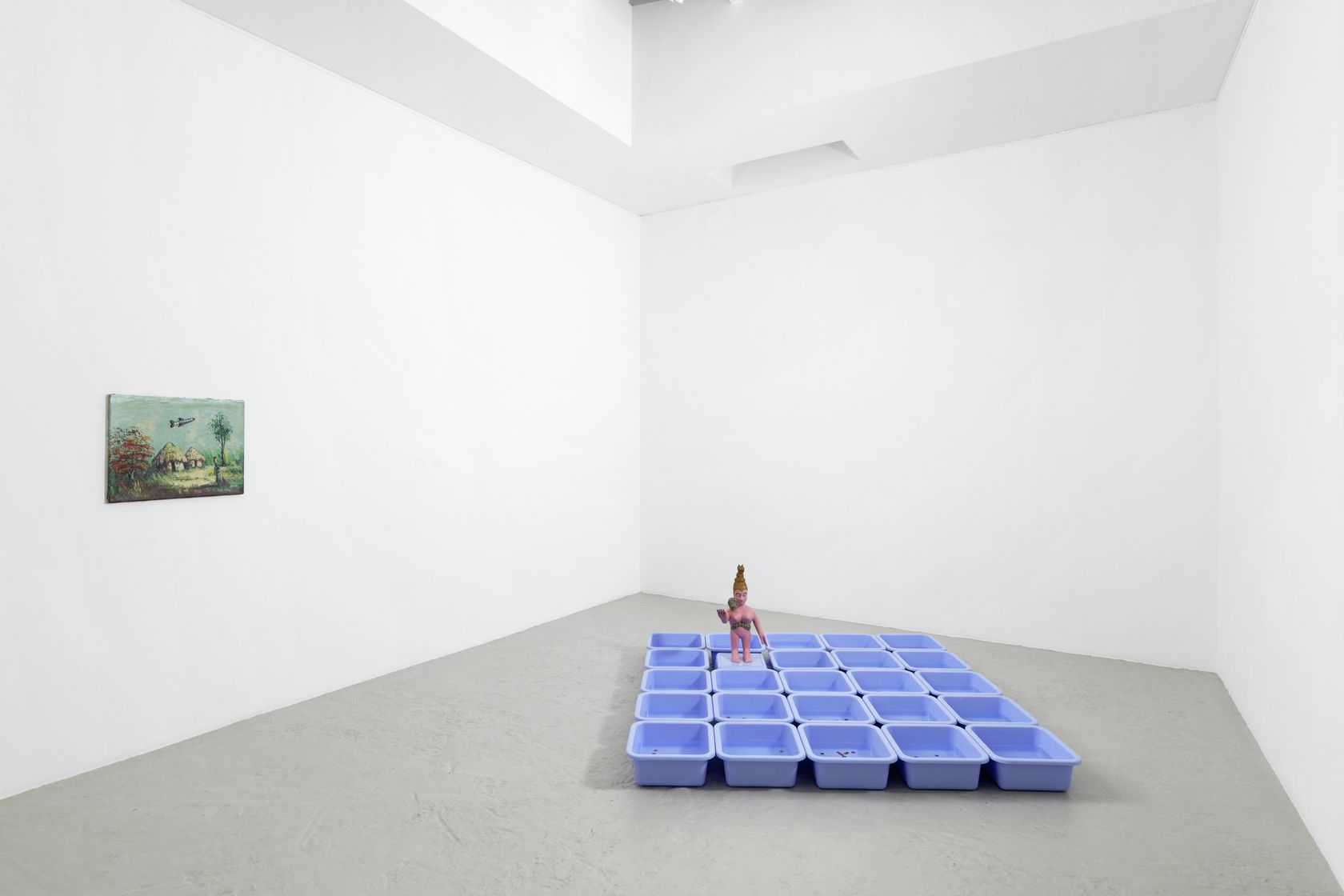
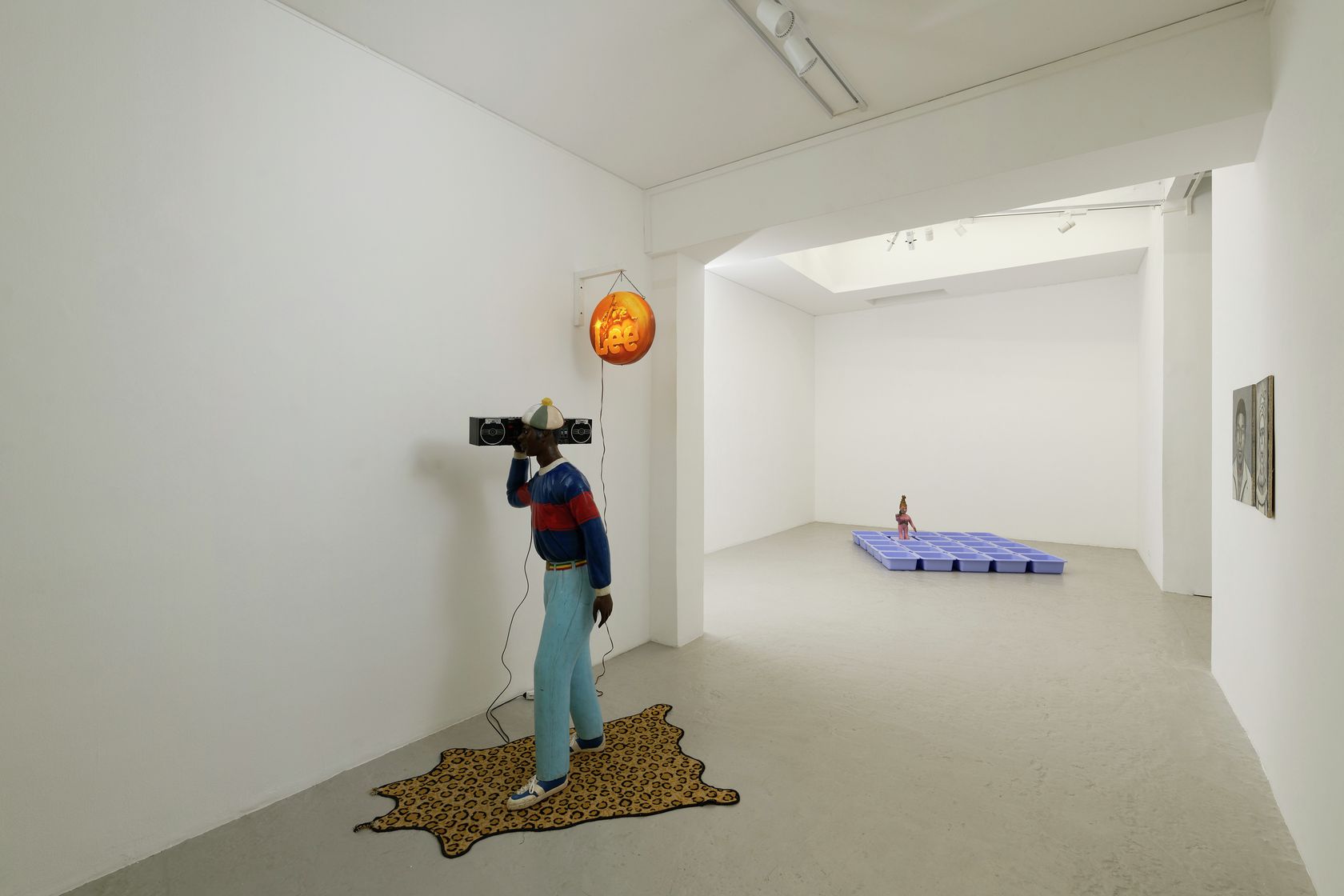
- Présence Panchounette
- Magicienne de l'eau , 1985
- Voodoo statue in painted wood (by Agbagli Kossi in Lomé, Togo) and 25 plastic basins
-
-
Description | Description:
Le titre Magicienne de l’eau est une allusion à l’exposition “Les Magiciens de la Terre”, (1989) alors en préparation pour le Centre Pompidou par Jean-Hubert Martin – qui sollicite à l’époque Présence Panchounette pour recueillir des contacts d’artistes africains, sans pour autant inviter le collectif dans l'exposition. Cette œuvre démontre l’intérêt profond et le respect des membres de Présence Panchounette pour le système symbolique des cultures africaines. Ils passent commande au sculpteur togolais vaudou Agbagli Kossi (1935-1991) d’une statue représentant Mami Wata, la déesse vaudou de l’eau dont le culte est particulièrement présent en Afrique de l’Ouest (Togo, Bénin et Nigéria). Cette divinité est souvent décrite comme mi femme, mi poisson, et est accompagnée ici d’un serpent, symbole de sagesse. L’iconographie récurrente en Afrique de la déesse-serpent apparait à la fin du XIXe siècle, inspirée par les déesses hindoues dont les images sont diffusées par les colporteurs indiens. Le couvre-chef de la déesse évoque d’ailleurs la silhouette d'un temple indien.
Ici, la divinité subit une simple “modernisation” par Présence Panchounette, une réactualisation avec des objets quotidiennement employés sur le continent africain, autant qu’elle est exposée à un nouveau rituel, celui de jeter des pièces dans l’eau. Exposée pour la première fois dans l’exposition “Banlieues Sud – Expressions d’Afrique” au CAC Labège en 1986, elle constitue une sorte d’anti-thèse aux expositions d’art contemporain africain organisées alors en Europe, jugée naïves et condescendantes.
The title Magicienne de l’eau alludes to the exhibition “Les Magiciens de la Terre” (1987), which was at the time being prepared for the Pompidou Center by Jean-Hubert Martin. Martin had solicited the help of Présence Panchounette in contacting various African artists, whilst neglecting to invite the collective to participate in the exhibition. The work demonstrates Présence Panchounette’s profound interest in and respect for the symbolism inherent in African cultures. They commissioned the Togolese Vodun sculptor Agbagli Kossi to produce a statue of Mami Wata, the Vodun spirit of water, particularly revered in West Africa (Togo, Benin and Nigeria). This spirit is often described as being half woman, half fish, and is accompanied by a snake, a symbol of wisdom. The recurrent representation of the female snake spirit in Africa first appeared at the end of the 19th century, inspired by images of Hindu goddesses distributed by Indian traders. The statue’s headdress evokes the silhouette of an Indian temple. In this work, the spirit has been “modernized” by Présence Panchounette, updated with objects used on a daily basis on the African continent as well as by being exposed to the relatively recent ritual of throwing coins into water. Magicienne de l’eau was first shown in the exhibition “Banlieues Sud – Expressions d’Afrique” at the Center for Contemporay Art (CAC) in Labège in 1986, which was a kind of antithesis of the exhibitions of contemporary African art organized at the time, which were judged to be naïve and condescending.
Expositions | Exhibitions:
• Section Africaine, Semiose, Paris, exhibition from November 20, 2021 to January 1, 2022
• Less is Less More is More, that's all !, CAPC, Bordeaux, exhibition from May 30 to September 14, 2008
• Gandy Gallery, Prague, 1993
• Banlieues Sud - Expressions d’Afrique, Musée des beaux-arts de Calais, Calais, exhibition from July 2 to September 29, 1987
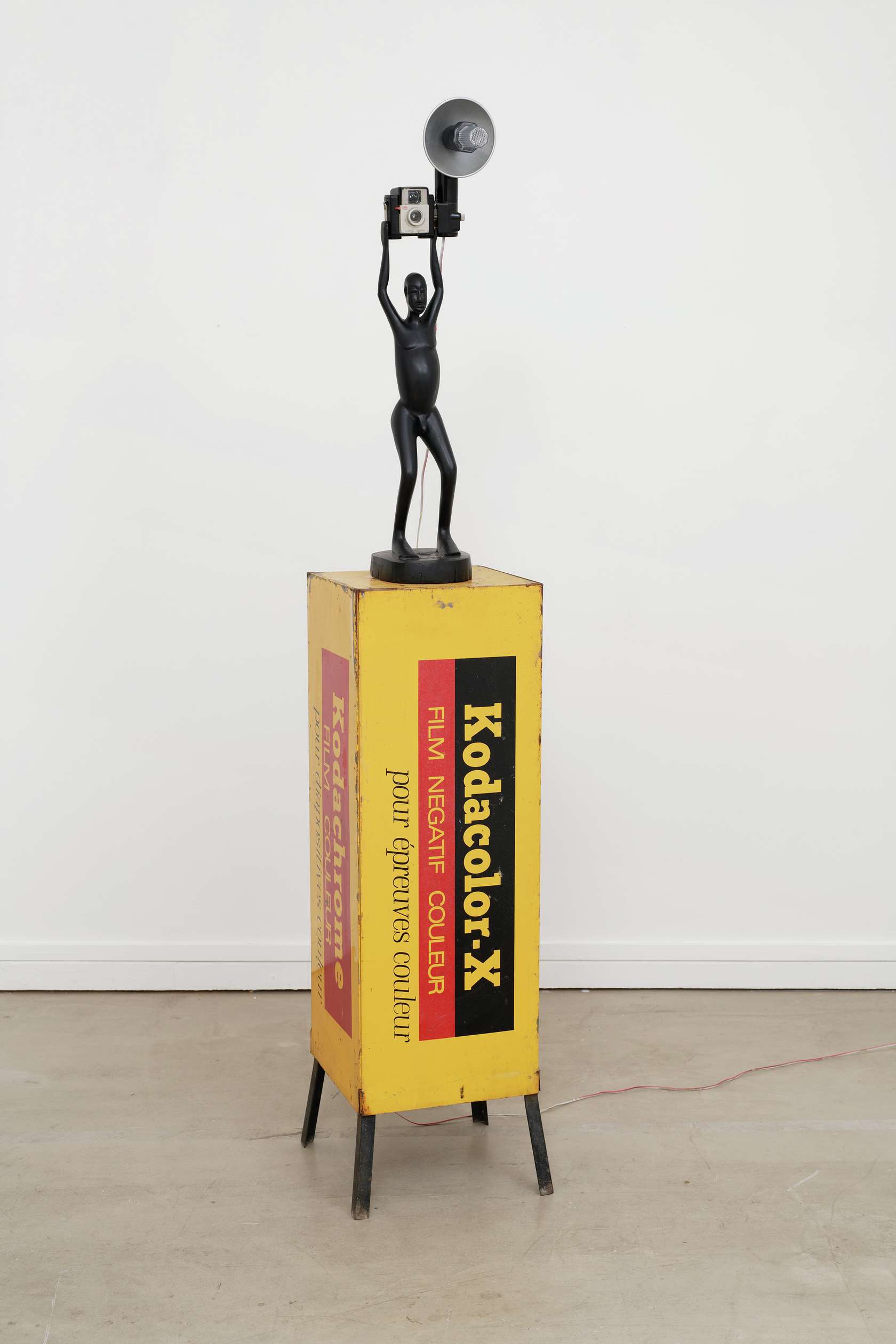
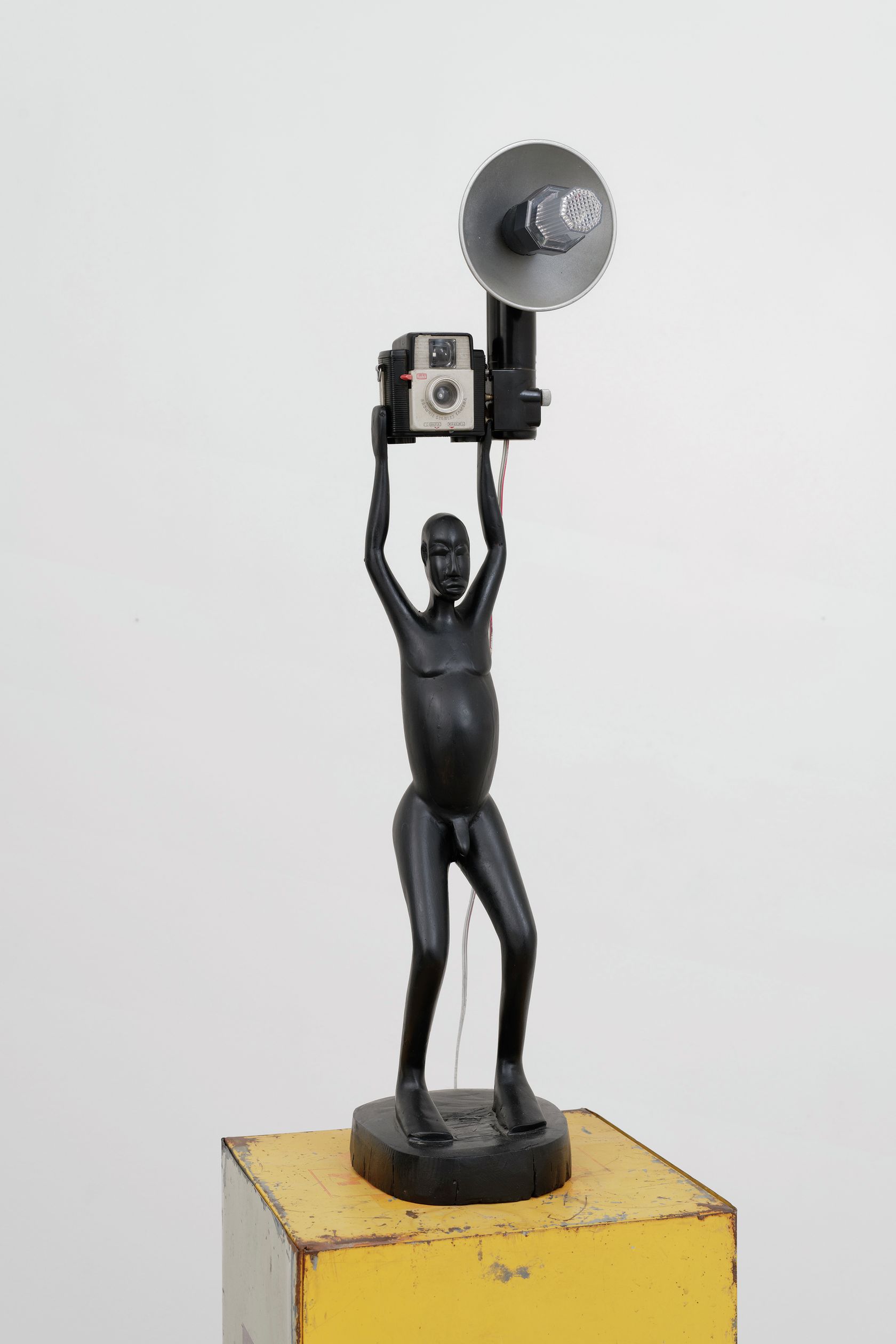
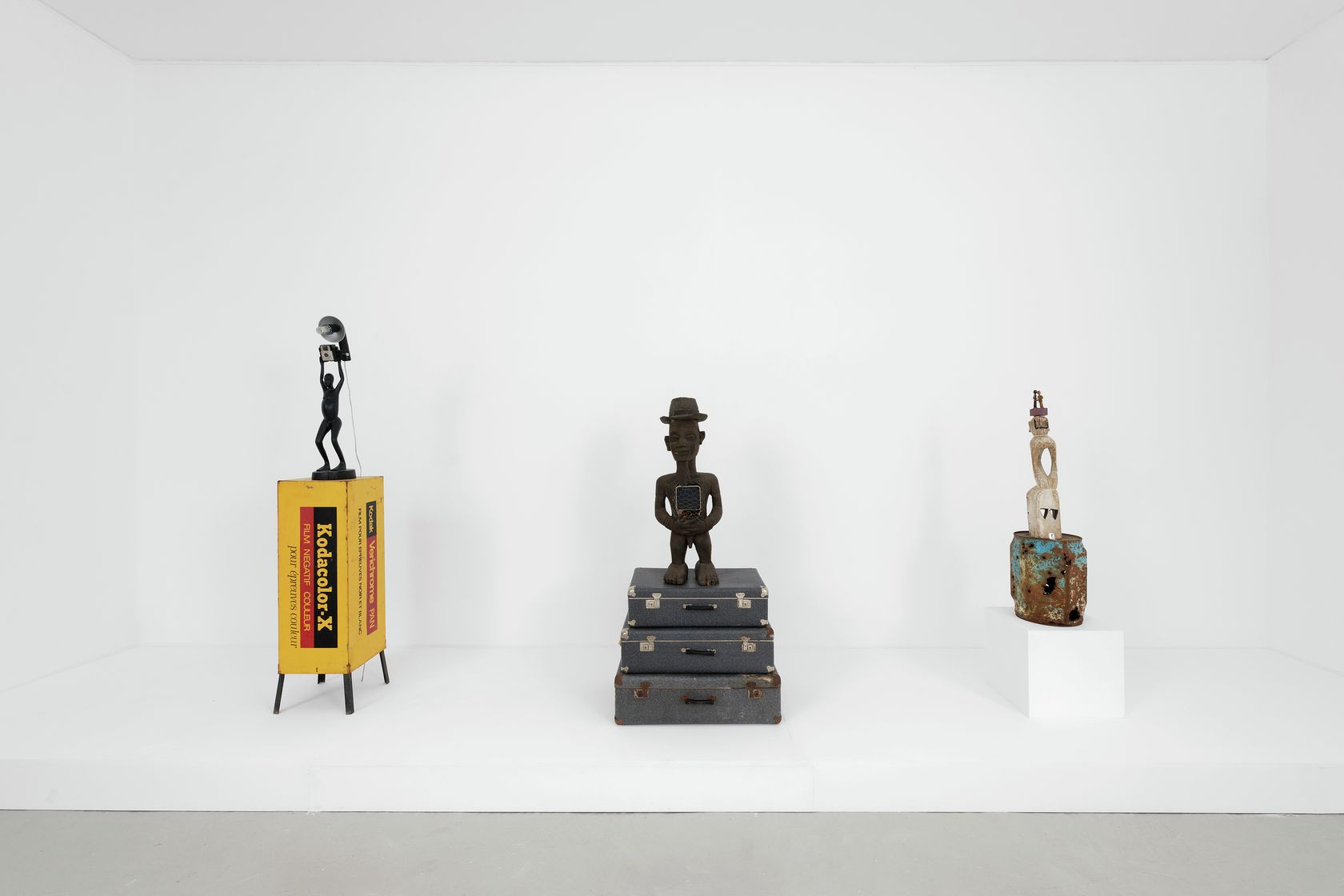
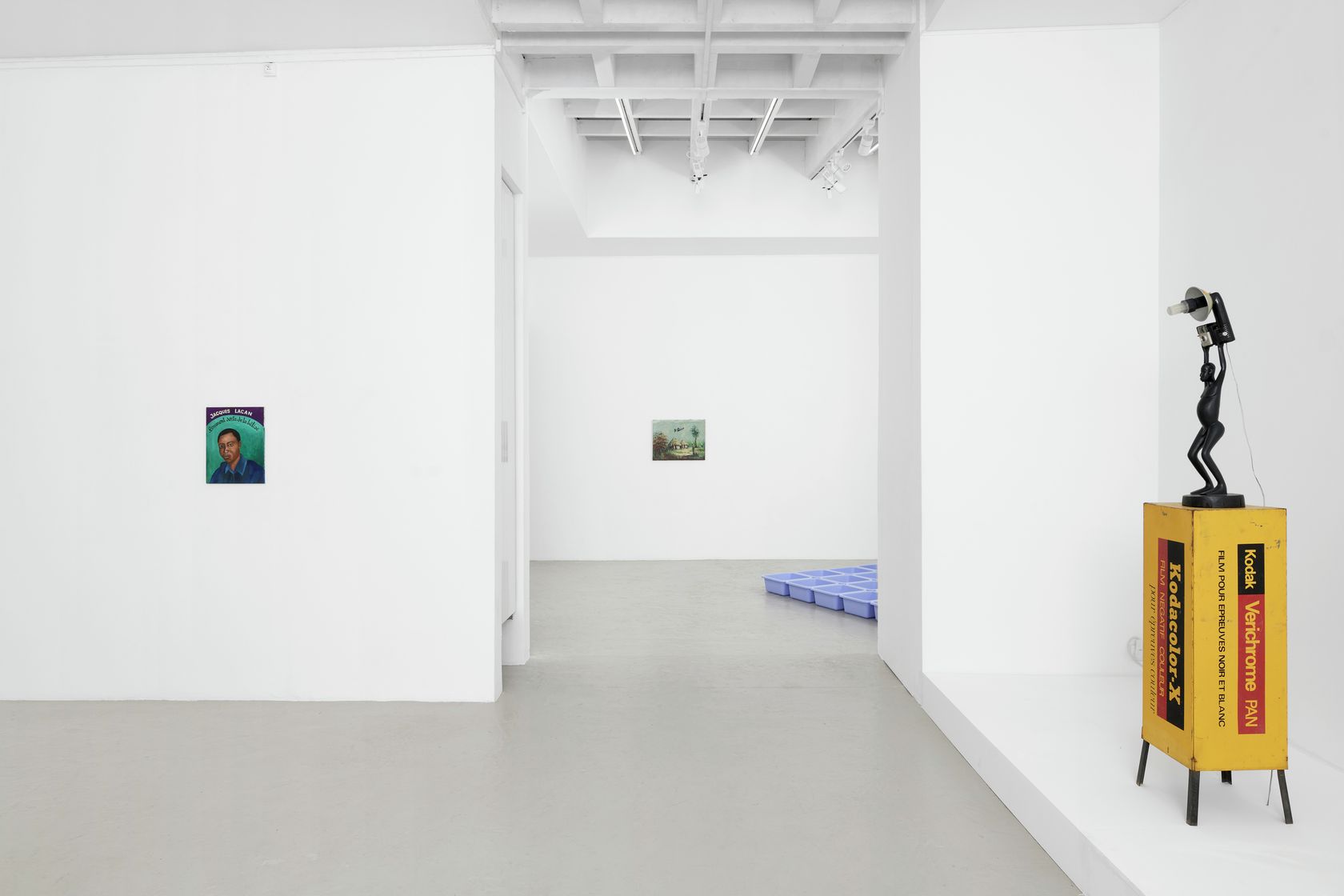
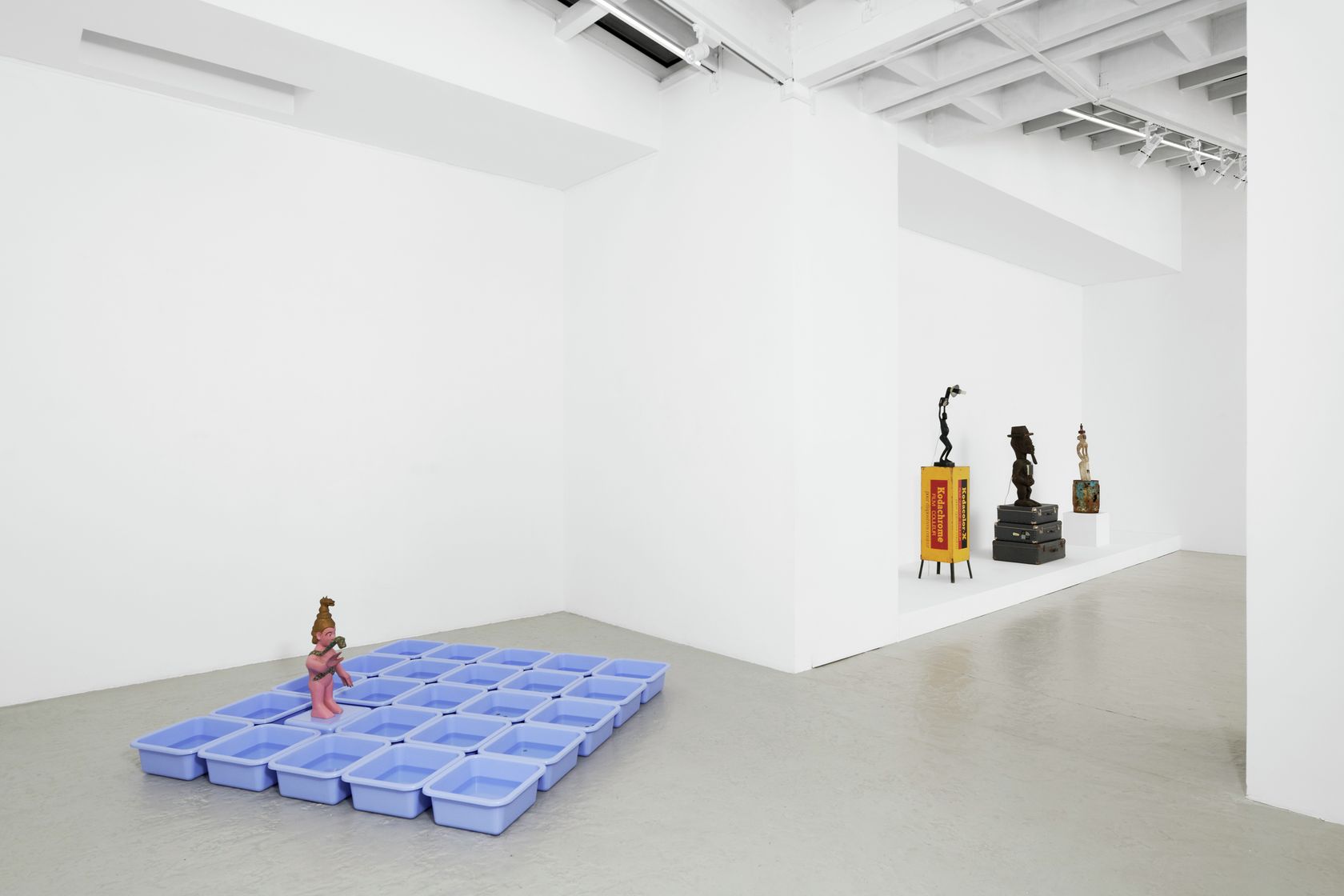
- Présence Panchounette
- Brownie Flash , 1986
- Metal advertising pedestal, wooden sculpture, Brownie Flash Kodak camera and stroboscopic bulb
-
- 183 ×
- 36 ×
- 36 × cm
- 72 ×
- 14 1/8 ×
- 14 1/8 × inches
-
Description | Description:
Brownie Flash est la superposition sous la forme d’un totem d’un socle publicitaire en métal à la gloire des pellicules Kodak, d’une statuette en bois les bras levés et d’un appareil photo Brownie Kodak dont le flash a été remplacé par une ampoule stroboscopique. Le tout forme un clin d’œil à l’engouement du continent africain pour la photographie, au point de supplanter les autres mediums traditionnels – peinture et sculpture – et de propulser des artistes photographes sur le devant de la scène (Malick Sidibé, Seydou Keïta, etc.). Cette œuvre a été exposée pour la première fois à Saint-Brieuc en 1985 dans le cadre de la manifestation « Lèche vitrines » qui prenait place dans les vitrines des commerçants.
Brownie Flash sees the superposition in the form of a totem of a metal rectangular stand, advertising the merits of Kodak film, a wooden statue with raised arms and a Kodak Brownie camera, whose flash has been replaced with a stroboscopic bulb. The whole is a nod to the African continent’s obsession for photography, which goes as far as supplanting more traditional mediums—painting and sculpture—and propelling photographic artists (Malick Sidibé, Seydou Keïta, etc.) to the forefront of contemporary art. This work was first exhibited in Saint-Brieuc in 1985, as part of the “Lèche-Vitrines” (Window Shopping) event that was displayed in shop windows.
Expositions | Exhibitions:
• Section Africaine, Semiose, Paris, exhibition from November 20, 2021 to January 1, 2022
• Recyclage-Surcyclage, Fondation Villa Datris, L'Isle-sur-la-Sorgue, exhibition from June 20 to November 1, 2020
• Les nains aussi ont commencé petits, Semiose, Paris, exhibition from May 18 to June 15, 2019
• GONTIERAMA 2018 - Présence Panchounette, Musée d’Art et d’Histoire du Pays de Château-Gontier, Château-Gontier exhibition from May 26 to June 26, 2018
• Lèche-vitrine, Centre d'art contemporain, Saint-Brieuc, exhibition in 1985
Bibliographie | Bibliography:
• KAPEL-MARCOVICI, Danièle, DE MAULMIN, Valérie, Re-cyclage/Sur-cyclage, cat. exp. (Fondation Villa Datris, l'Isle-sur-la-Sorgue, 2020), Fondation Villa Datris éditions, l'Isle-sur-la-Sorgue, 2020, Repr. p. 163.
• “Les nains aussi ont commencé petits”, Parisart, May 20th, 2019, online.
• MILLET, Catherine, SOULILLOU, Jacques, “Présence Panchounette”, Pleased to meet you, n°7, Paris, Semiose éditions, 2019, Repr. p. 75.
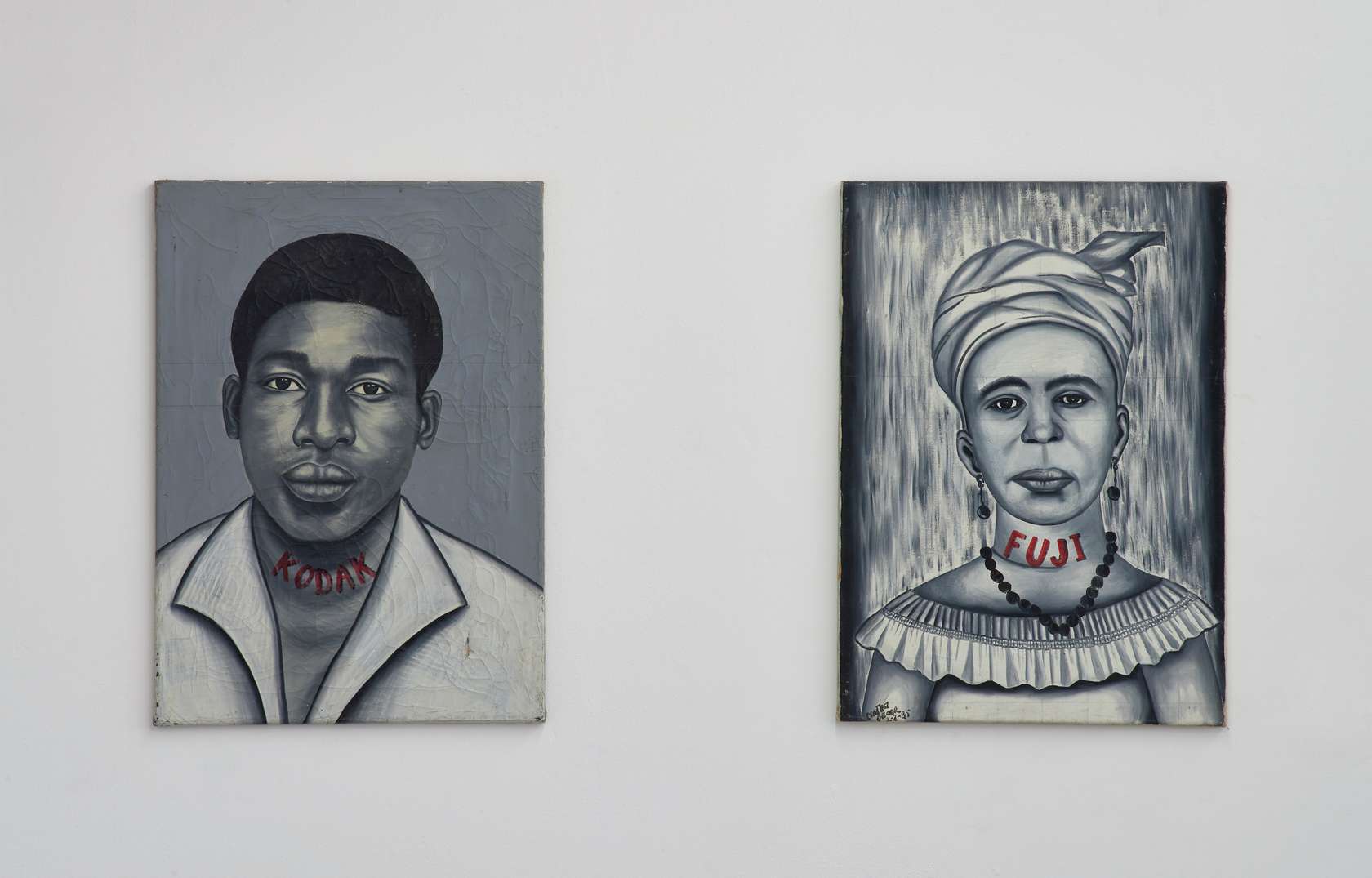
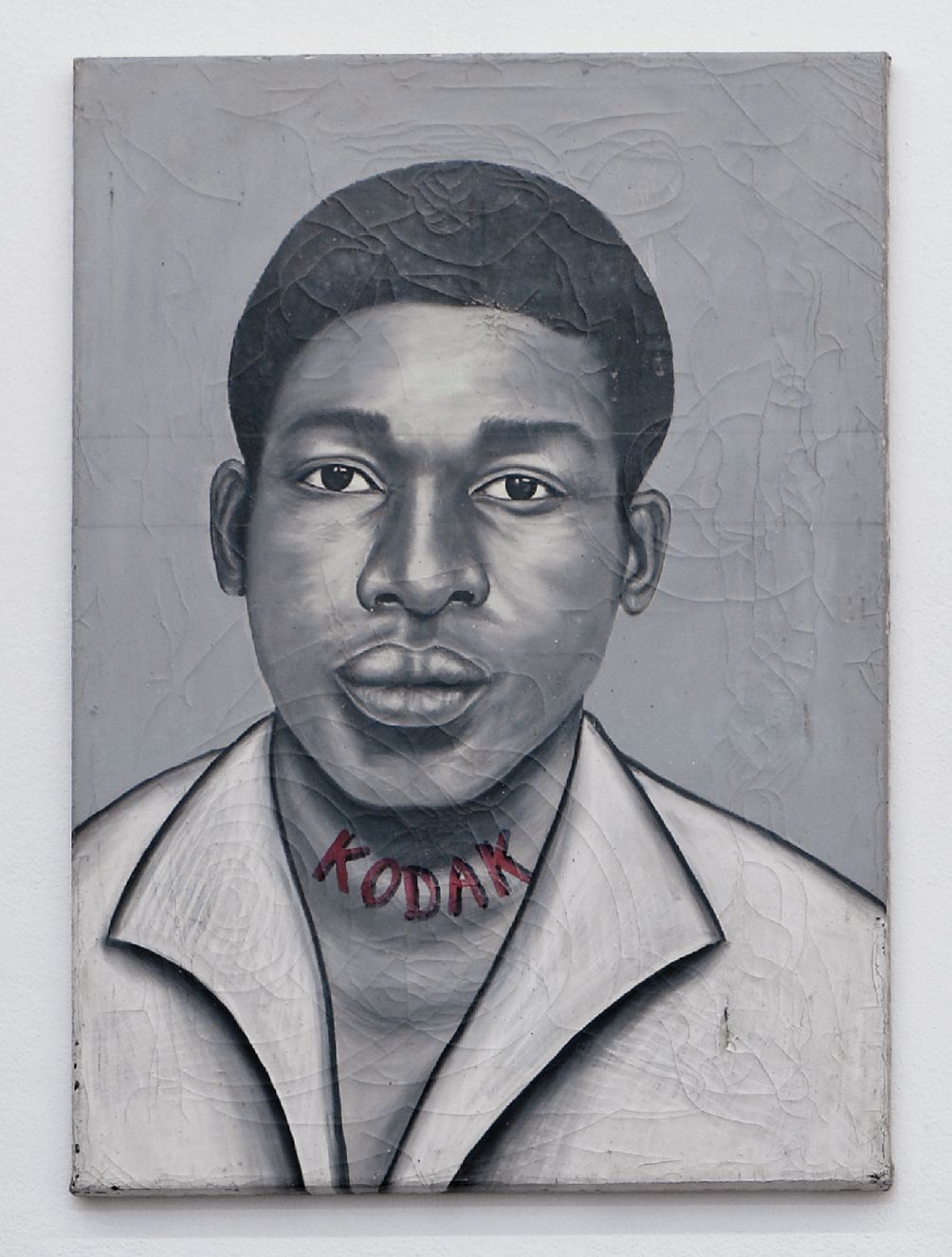
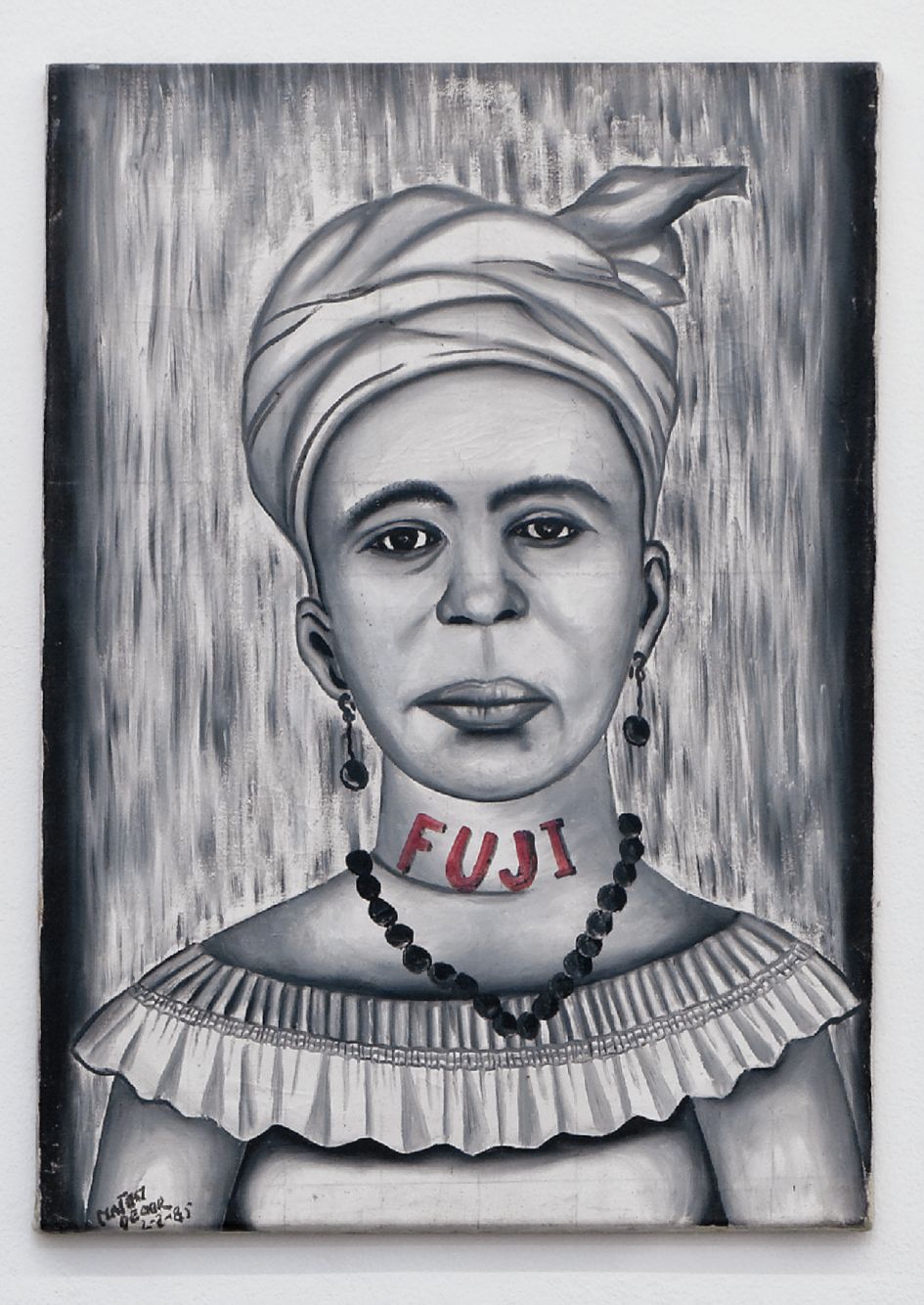
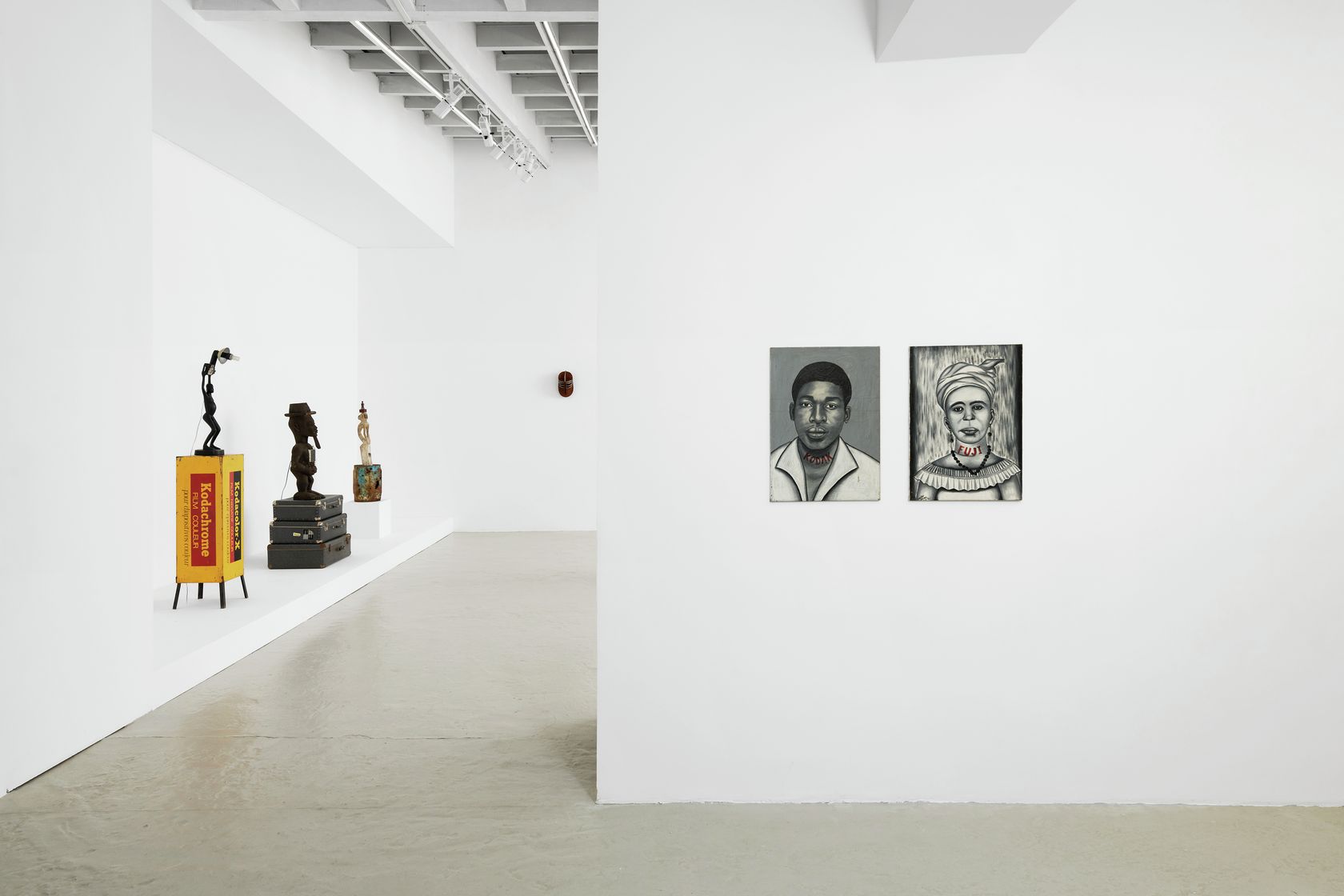
- Présence Panchounette
- Portraits Kodak - Fuji , 1985
- Acrylic on canvas
-
- 60 ×
- 42.5 × cm
- 23 5/8 ×
- 16 6/8 × inches
- each
-
Expositions | Exhibitions:
• Section Africaine, Semiose, Paris, exhibition from November 20, 2021 to January 1, 2022
• Présence Panchounette is not dead, Lieu Commun, Toulouse, exhibition from May 17 to July 6, 2019
• PPP (Présence Panchounette Photographies), Semiose, Paris, exhibition from October 18 to November 22, 2014
• Less is Less More is More, that's all !, CAPC, Bordeaux, exhibition from May 30 to September 14, 2008
• The Last, Galerie de Paris, Paris, exhibition in 1990
• Présence Panchounette, Württembergischer, Kunstverein, Stuttgart, exhibition in 1987
• Banlieues Sud - Expressions d’Afrique, CRAC Midi-Pyrénées, Labège-Innopole, Castanet-Tolosan, exhibition from December 13, 1986 to January 30, 1986
Bibliographie | Bibliography:
• MILLET, Catherine, SOULILLOU, Jacques, “Présence Panchounette”, Pleased to meet you, n°7, Paris, Semiose éditions, 2019, Repr. p. 74.
• DUCAT, Philippe, “Présence Panchounette”, Artpress, n°418, January, 2015, Repr. p. 30.
Description | Description:
Comme la série des “Portraits devise”, ces deux tableaux ont été trouvé dans un atelier de Guinée, laissés par des commanditaires indélicats qui n’ont pas honoré leur commande. Présence Panchounette transforme ces portraits par l’ajout des noms des marques Kodak et Fuji en guise de collier, sorte d’annonce prémonitoire de la fin à venir des ateliers de peinture au profit des studios de photographie. Fuji m’a tué !
As with the Portraits devise series, these two paintings were found in a studio in Guinea, abandoned by unfaithful customers who did not pay for their orders. Présence Panchounette transformed these portraits by adding necklaces with the brand-names Kodak and Fuji in a sort of premonitory announcement of the impending decline of painting studios faced with photographic portrait makers. Kodak killed me off!
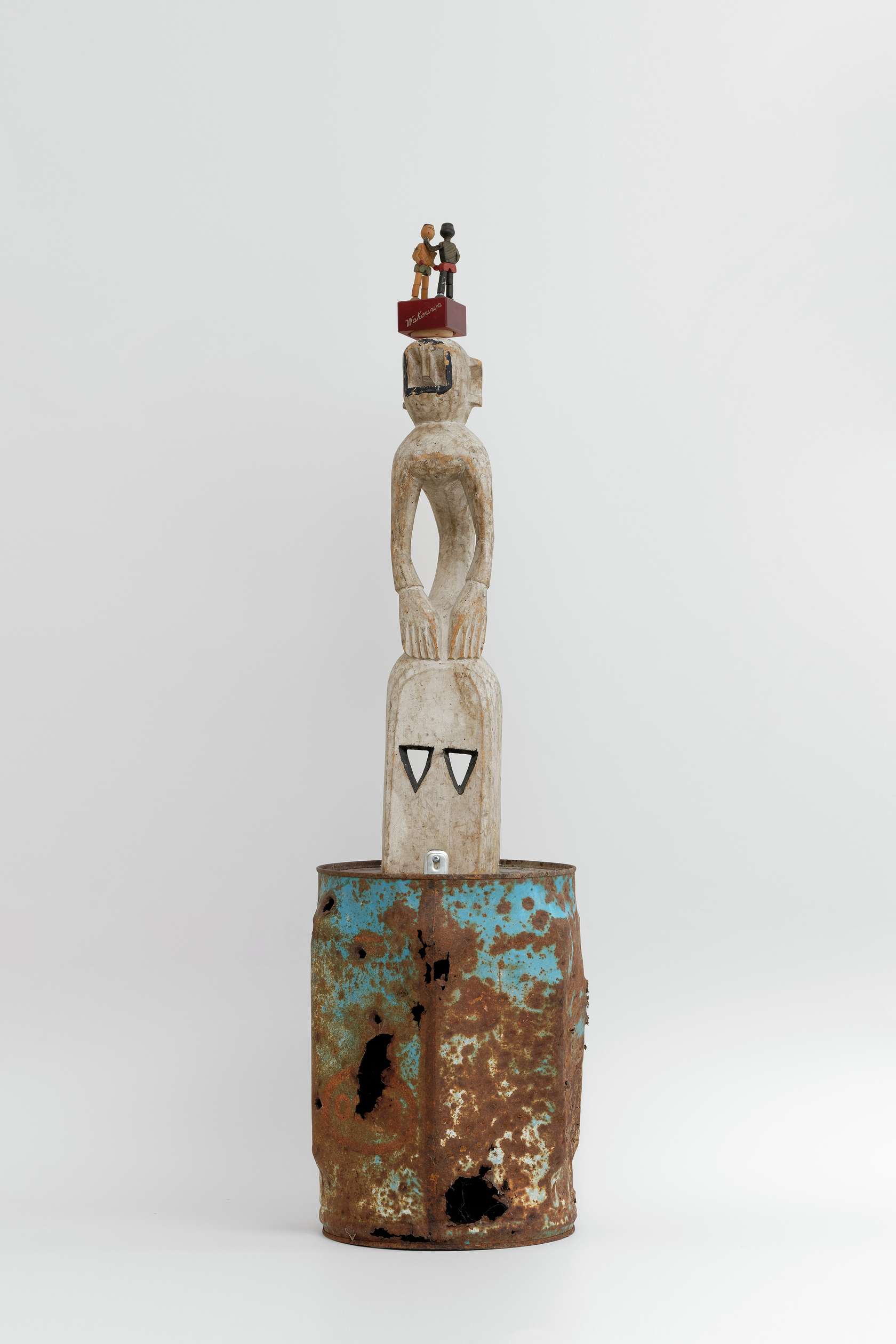
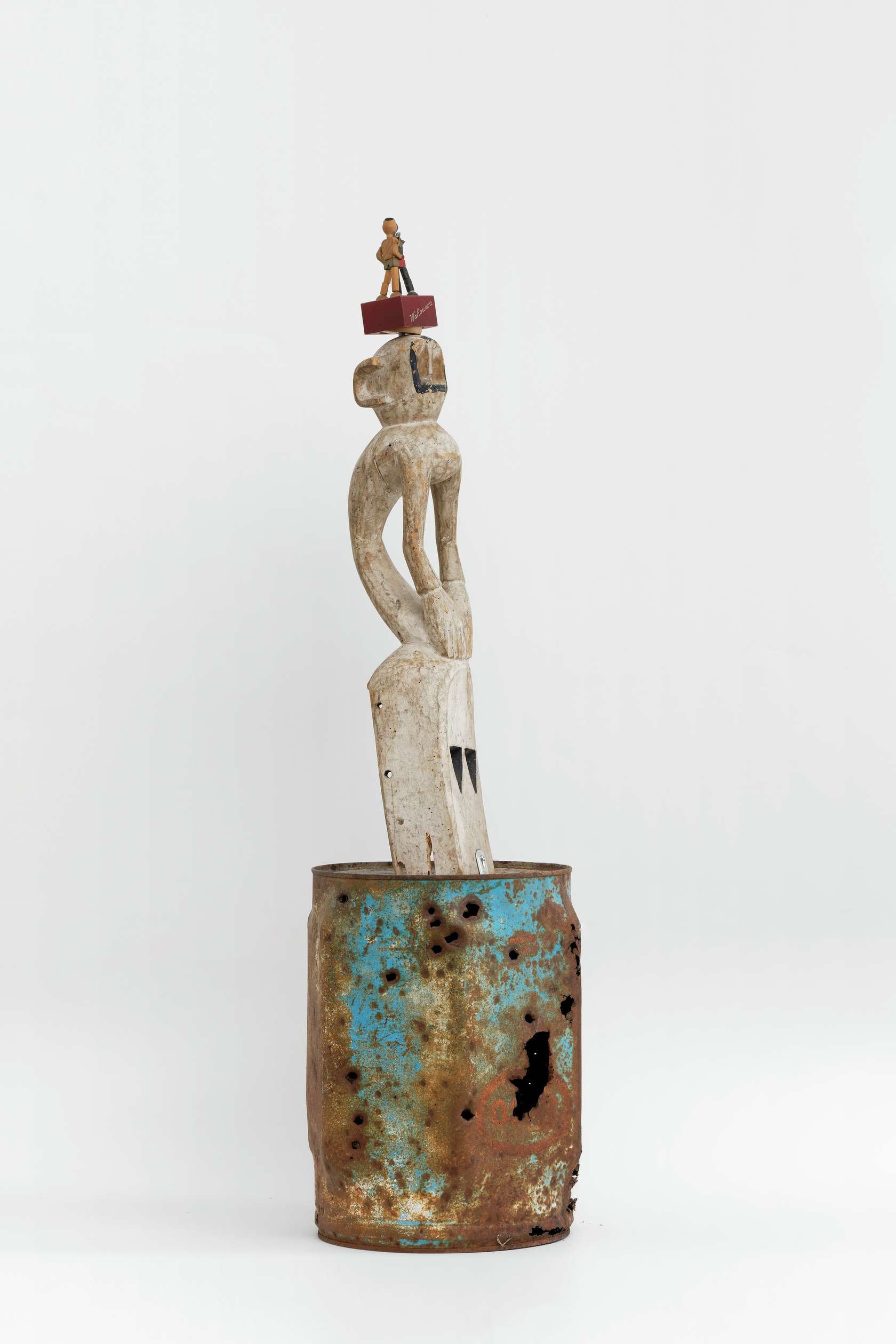
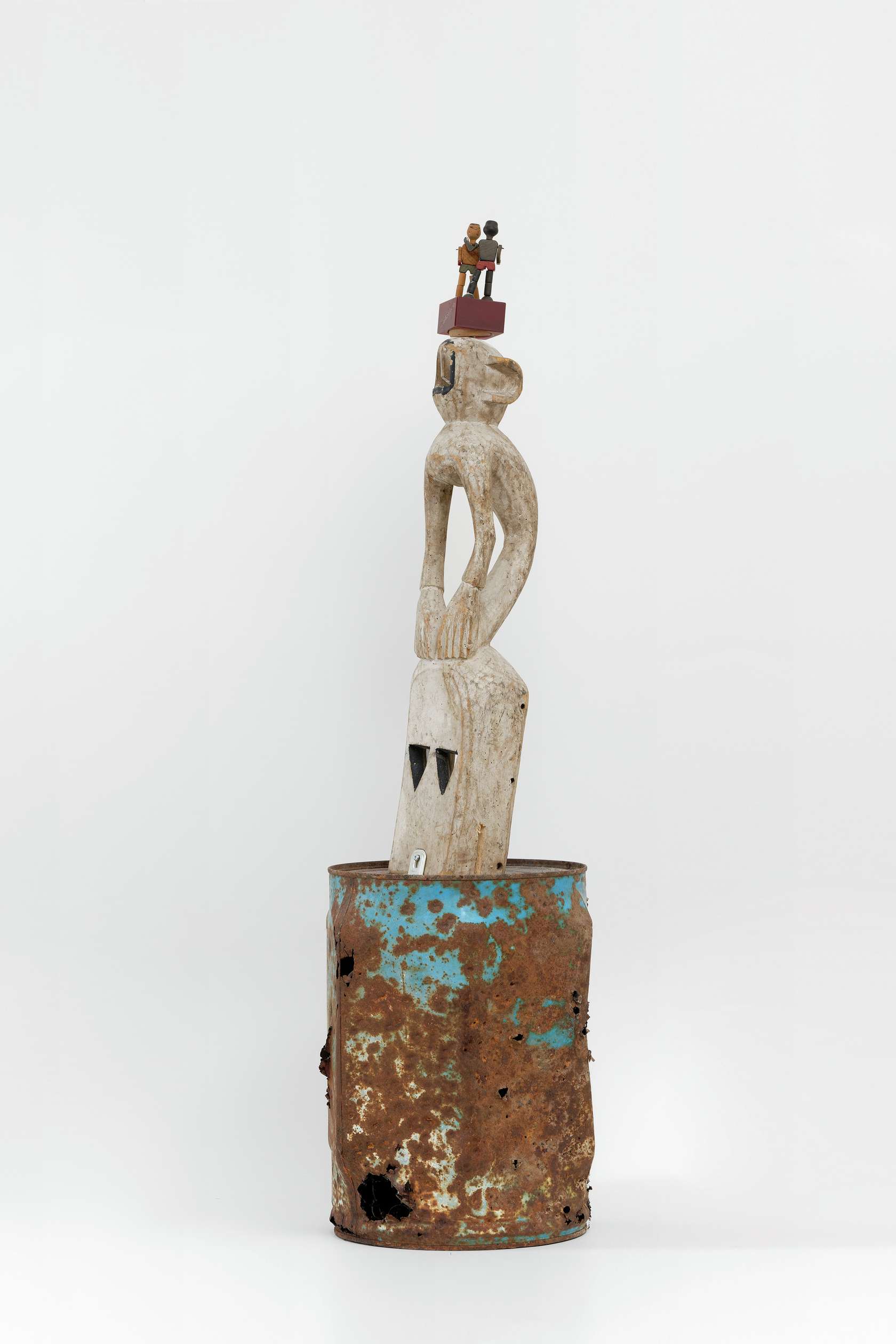
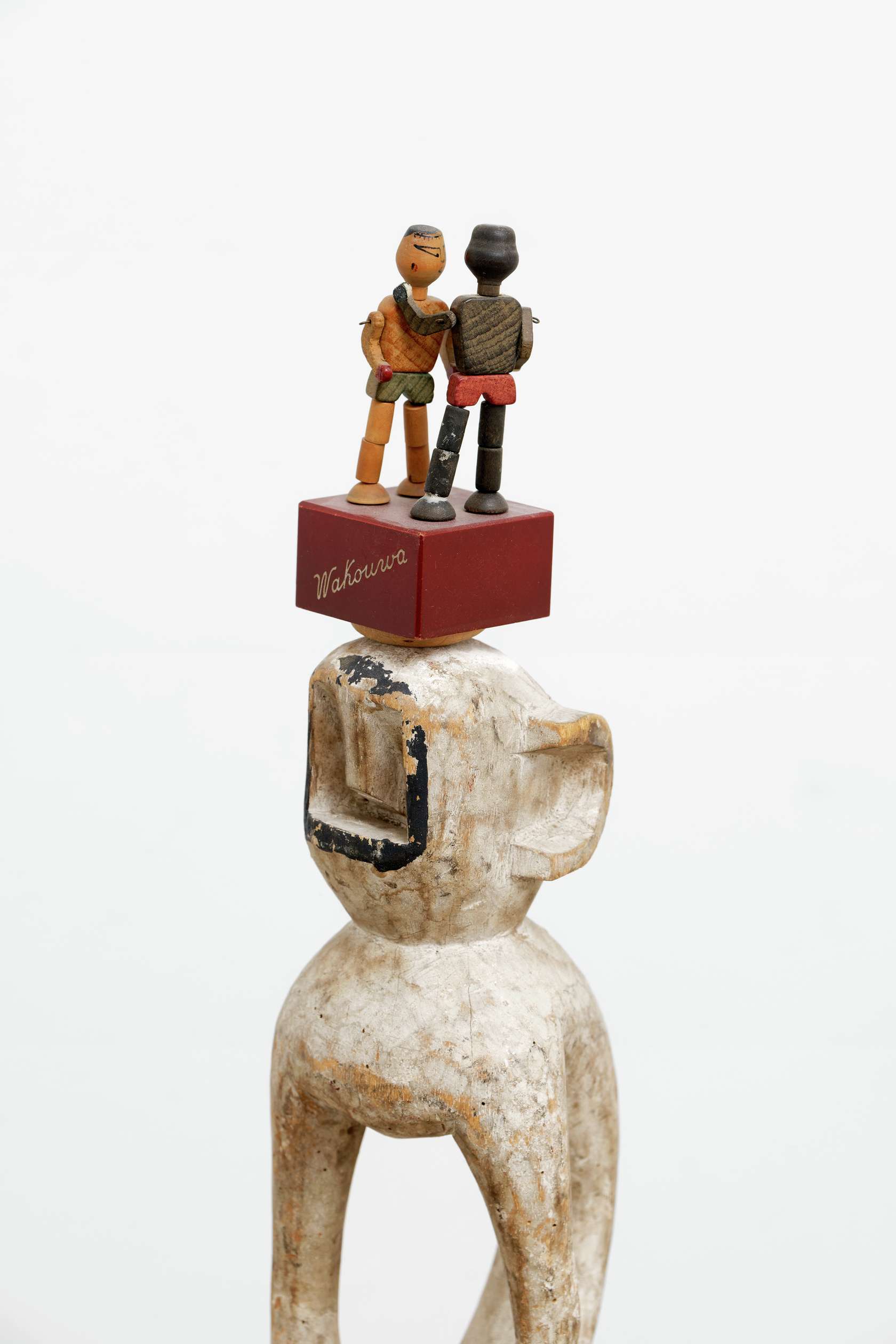
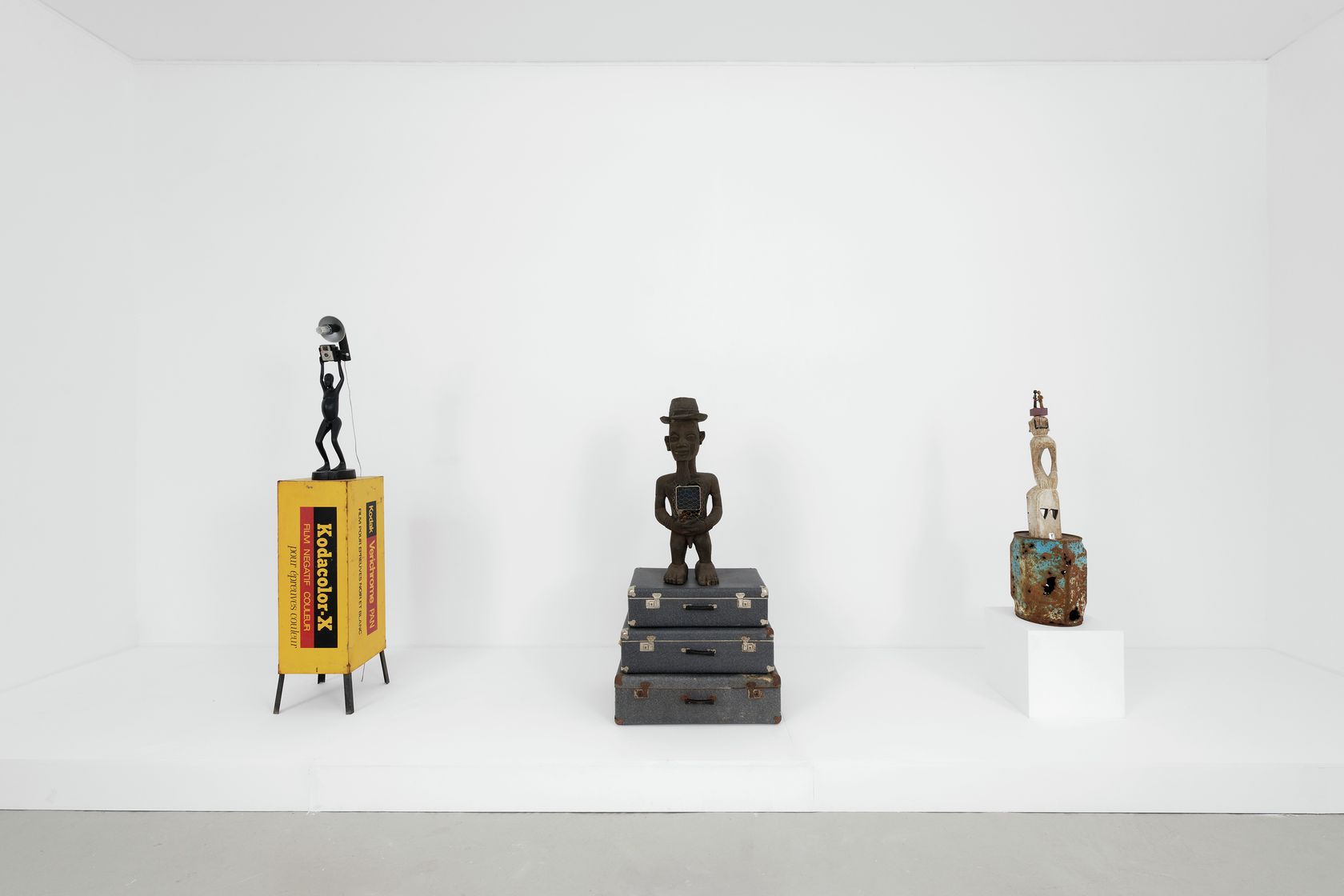
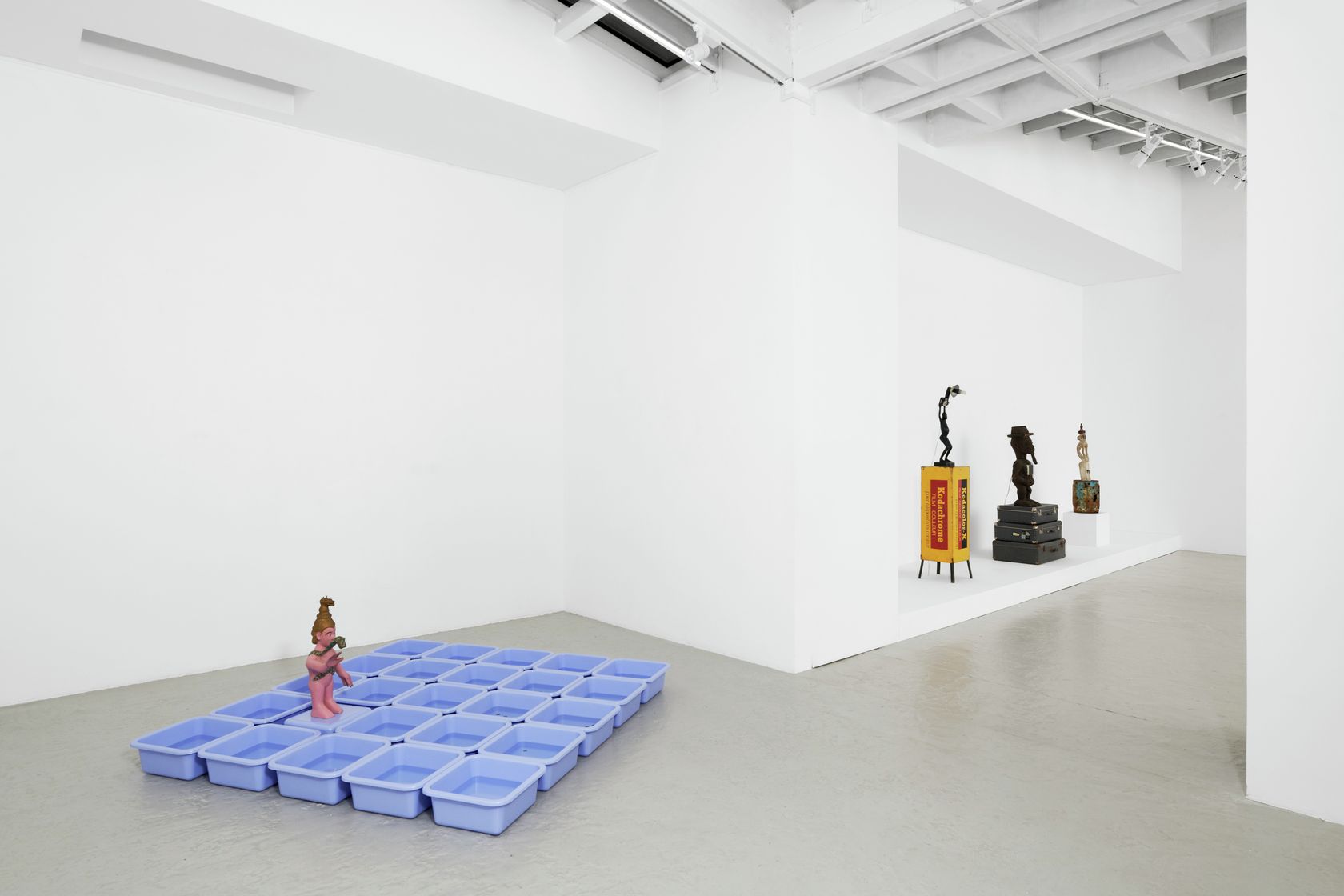
- Présence Panchounette
- Kinshasa Boxing Club , 1983
- African wooden mask, kaolin, "wakouwa" wooden toy and painted rusty metal can
-
- 113 ×
- 30 × cm
- 44 1/2 ×
- 11 6/8 × inches
-
Expositions | Exhibitions:
• Section Africaine, Semiose, Paris, exhibition from November 20, 2021 to January 1, 2022
• Présence Panchounette is not dead, CIAM La Fabrique, Toulouse, exhibition from May 9 to June 26, 2019
Description | Description:
Assemblage de trois artefacts rares ou usagés, Kinshasa Boxing Club fait référence au célèbre combat de boxe de Mohammed Ali en 1974 à Kinshasa (Zaïre). La sculpture est composée en verticalité, comme un totem, et superpose un bidon en métal rouillé, un masque africain en bois développé en hauteur et couvert de kaolin, et un jouet "wakouwa", petit objet en bois articulé, représentant les deux boxeurs, Mohammed Ali et son malheureux adversaire, George Foreman.
Kinshasa Boxing Club is an assembly of three rare or discarded objects and refers to Muhammed Ali’s famous boxing match that took place in Kinshasa, Zaire in 1974. The sculpture is composed in a vertical manner like a totem and employs the superposition of a rusty metal can, a long wooden African mask, covered in white kaolin and a “wakouwa” push puppet toy, representing two boxers: Muhammed Ali and his unfortunate opponent, George Foreman.
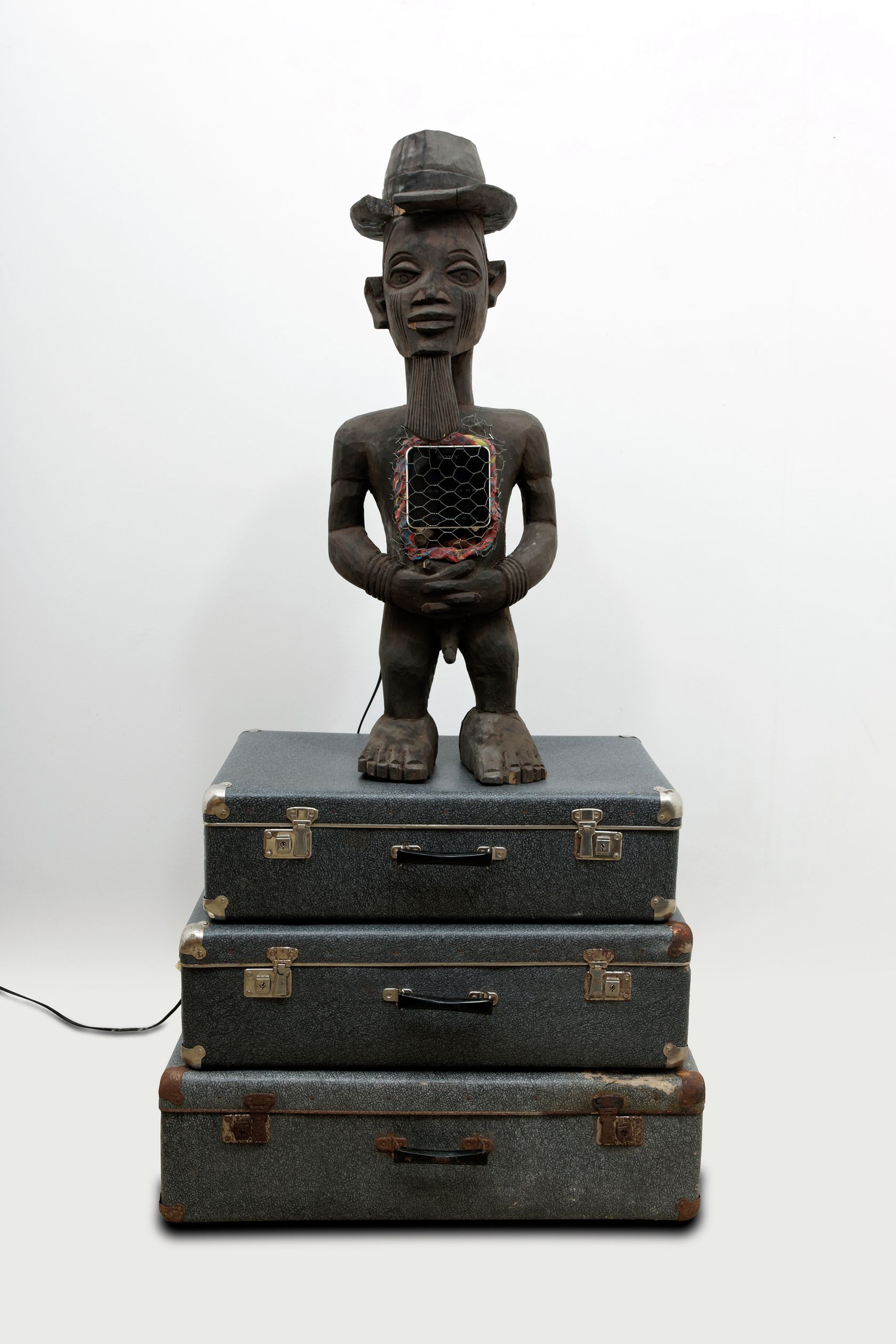
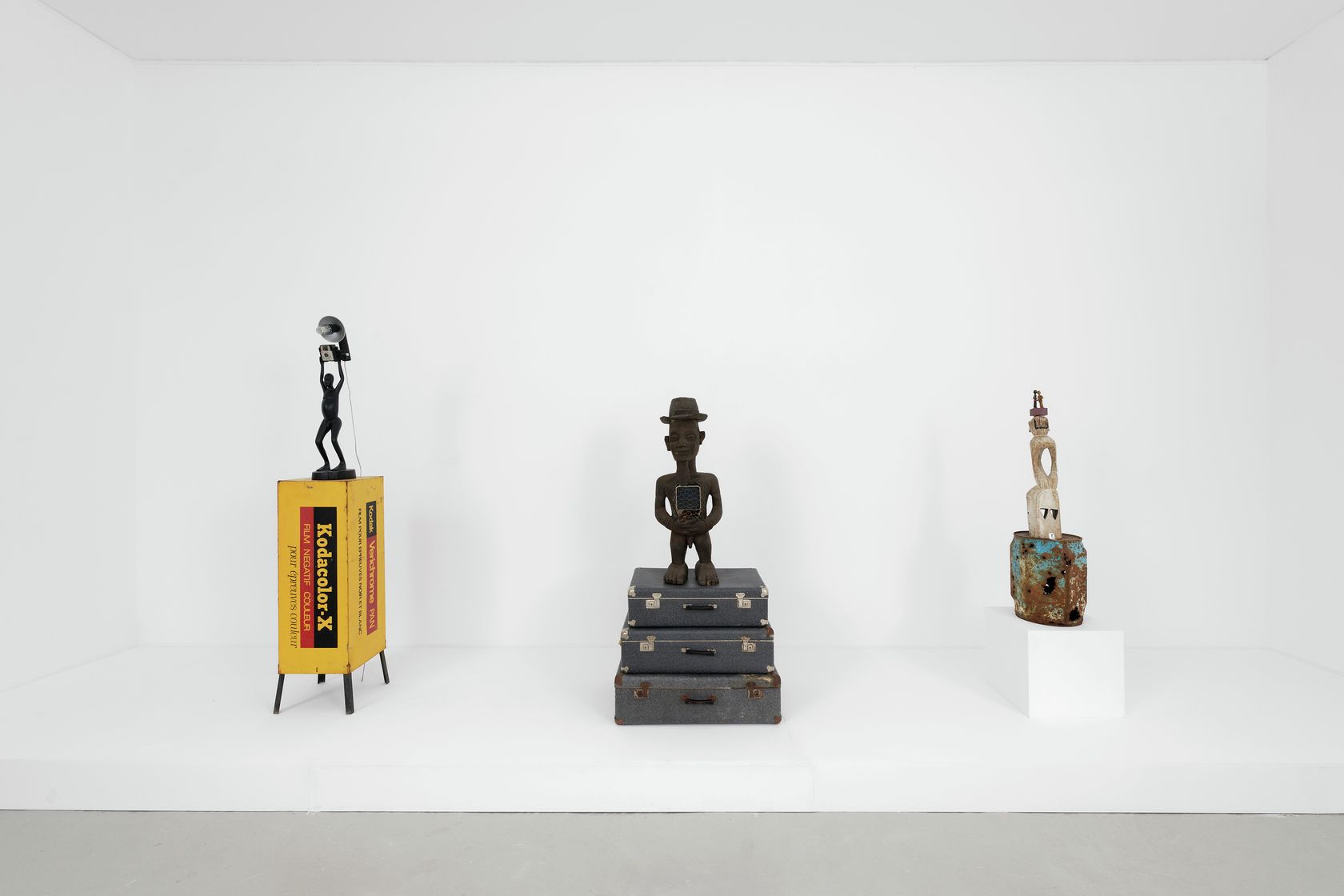
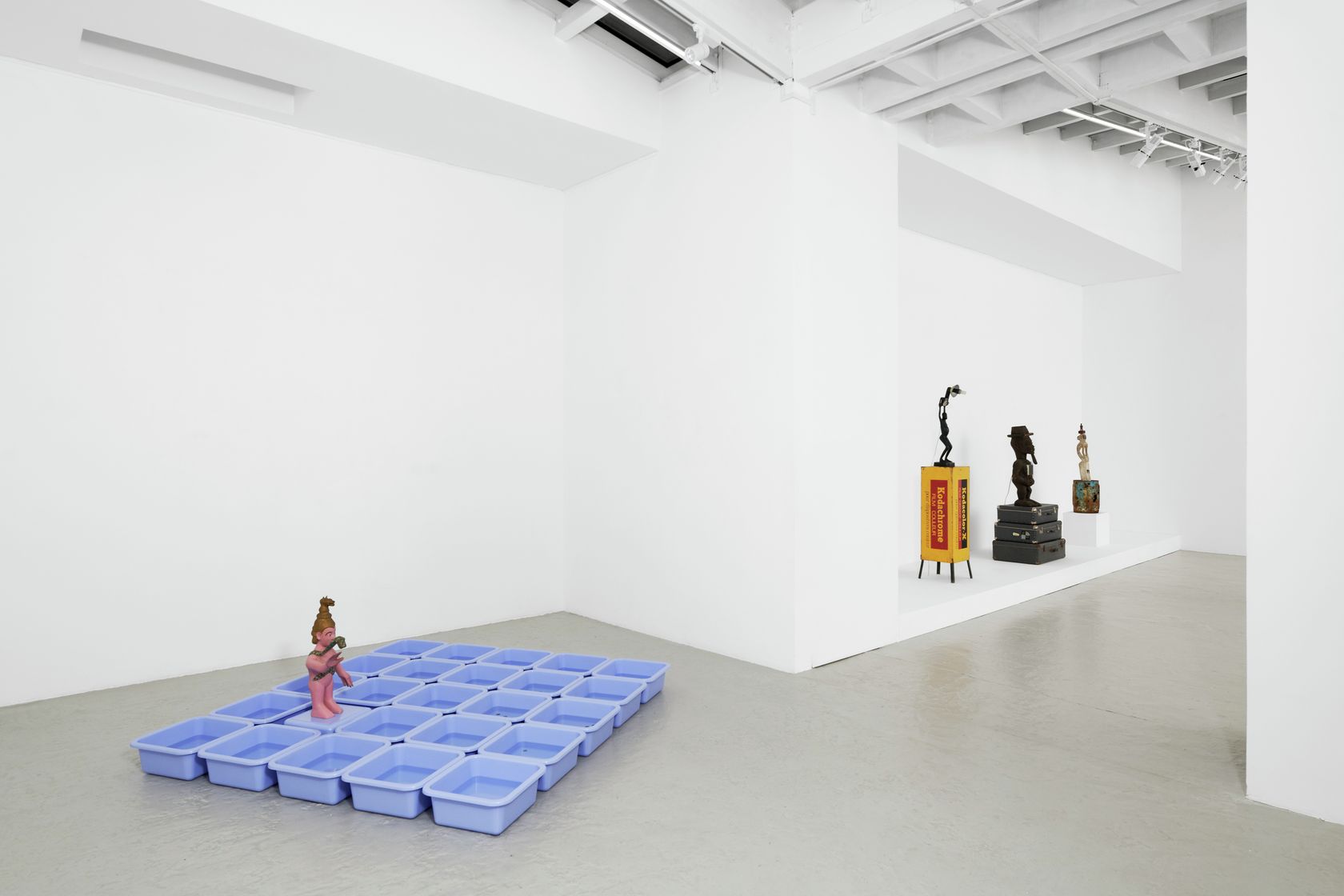
- Présence Panchounette
- Batéké radio réveil , 1985
- Wooden sculpture, fence and Sony clock radio
-
- 92 ×
- 36 ×
- 30 × cm
- 36 2/8 ×
- 14 1/8 ×
- 11 6/8 × inches
-
Bibliographie | Bibliography:
• MILLET, Catherine et SOULILLOU Jacques, "Présence Panchounette", Pleased to meet you, n°7, Paris, Semiose éditions, 2019, Repr. p. 63.
Description | Description:
Télescoper des objets de différentes origines et de différents registres dans un joyeux mélange de high and low culture est l’un des ressorts de l’œuvre de Présence Panchounette. Batéké radio réveil en est un parfait exemple : une statuette en bois exotique (qu’on pourrait croire des plateaux de Batéké, entre le Congo et le Gabon) est assemblée avec un radio-réveil Sony, typique des premiers objets électroniques portables des années 1970. L’objet traditionnel africain, de facture manuelle, est associé à un objet moderne produit industriellement. L’un n’échappe pas à la réévaluation de ses qualités au contact de l’autre, et une analyse critique des goûts de classe se pose inévitablement. Au surplus, lorsqu’il est branché, le radio-réveil émet des sons et octroie alors à la statuette un supplément d’âme et d’esprit.
Bringing objects of different origins and different registers into collision in a joyful mix of high and low culture is typical of Présence Panchounette’s modus operandi. Batéké radio réveil is a perfect example of this. A statue in exotic wood (that might well be from the Batéké plateau, situated between the Congo and Gabon) has been put together with a Sony radio alarm clock, typical of the early, portable electronic objects from the 1970s. Thus, a traditional, handmade African object is associated with a modern, industrially produced piece of goods and neither escapes the re-evaluation of its qualities in relation to the other, something which inevitably leads to a critical analysis of taste depending on social class. Moreover, once plugged in, the radio alarm emits sounds that lending the statuette a supplementary soul and spirit.
Expositions | Exhibitions:
• Section Africaine, Semiose, Paris, exhibition from November 20, 2021 to January 1, 2022
• Présence Panchounette is not dead, CIAM La Fabrique, Toulouse, exhibition from May 9 to June 26, 2019
• Présence Panchounette, MAC VAL, Vitry-sur-Seine, exhibition from July 13 to October 6, 2013
• Less is Less More is More, that's all !, CAPC, Bordeaux, exhibition from May 30 to September 14, 2008
• The Last, Galerie de Paris, 1990
• Soldes, Cabinet Lalanne, Bordeaux, 1988
• Art français du XXe siècle : 1975-1987, Musée national d’art contemporain, Séoul, exhibition from May 26 to June 25, 1988
• Banlieues Sud - Expressions d’Afrique, Musée des beaux-arts de Calais, Calais, exhibition from July 2 to September 29, 1987
• Banlieues Sud - Expressions d’Afrique, CRAC Midi-Pyrénées, Labège-Innopole, Castanet-Tolosan, exhibition from December 13, 1986 to January 30, 1987
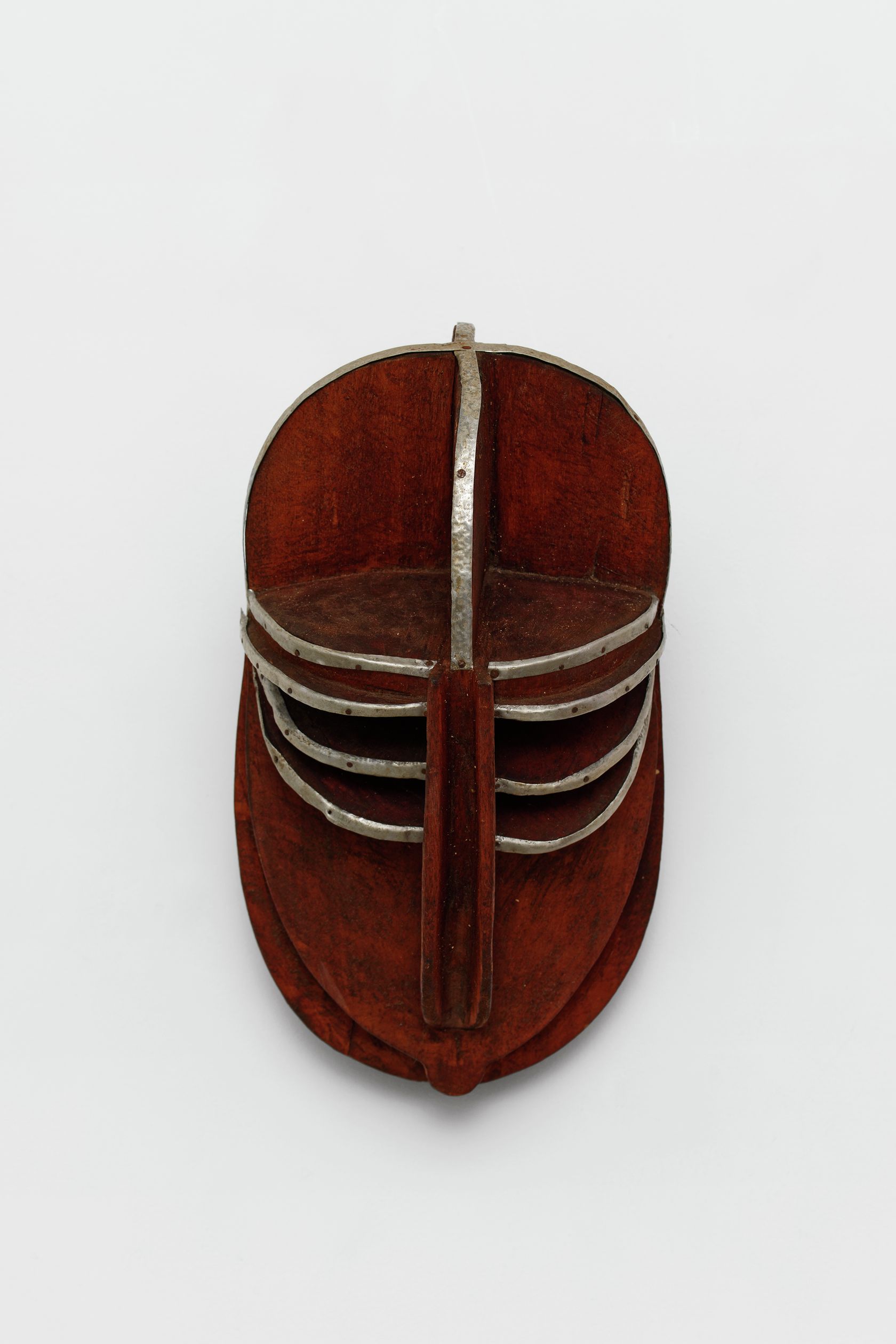
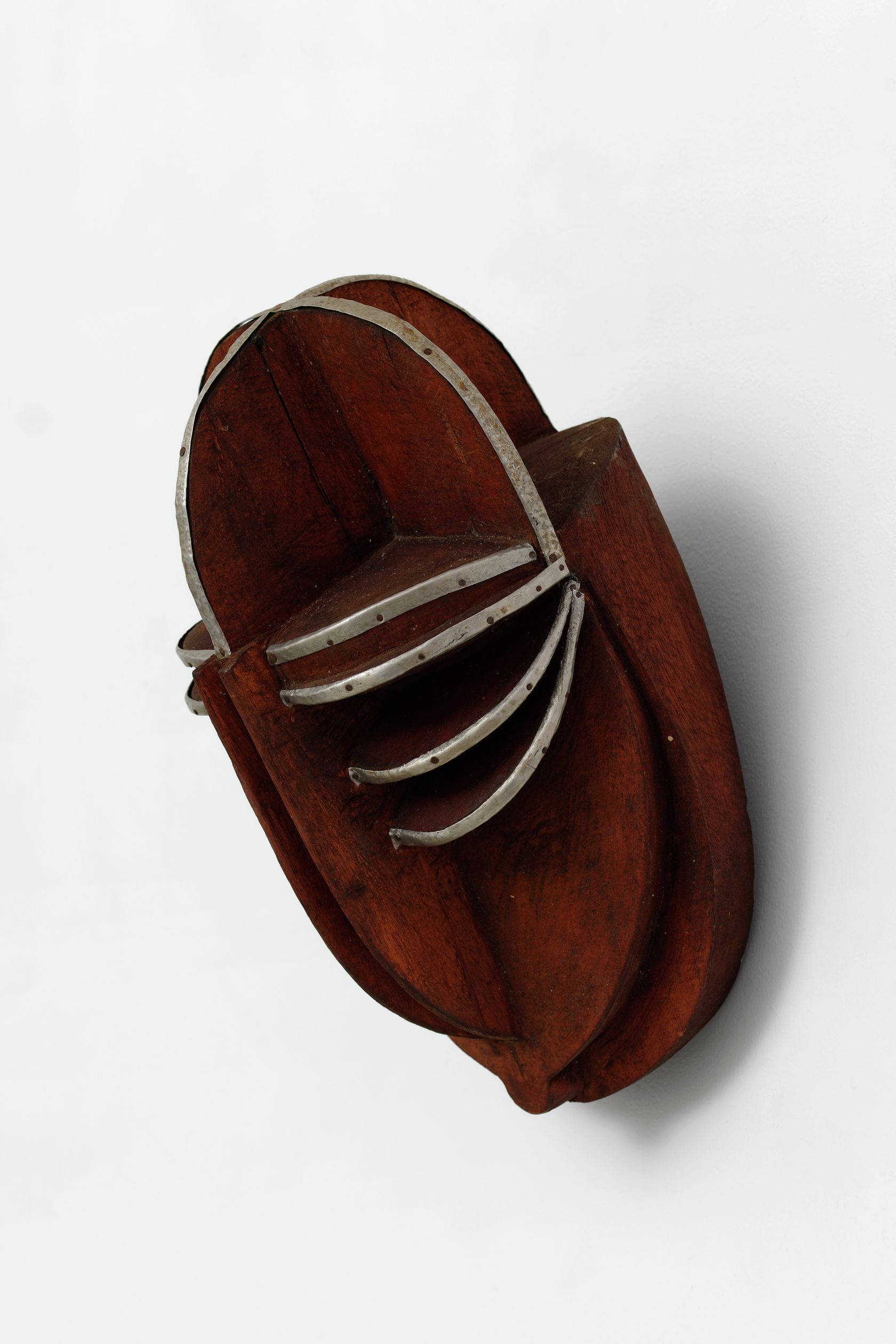
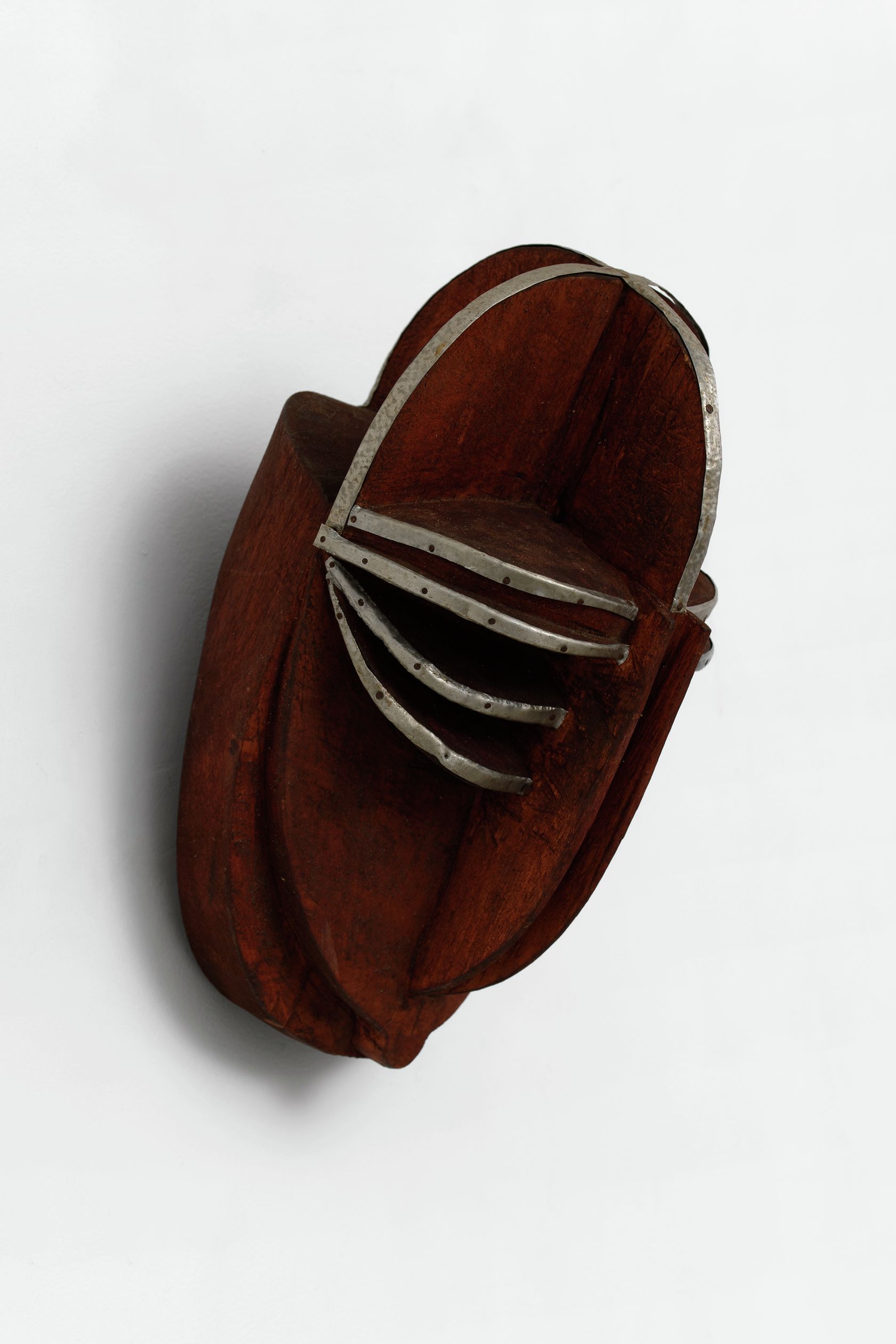
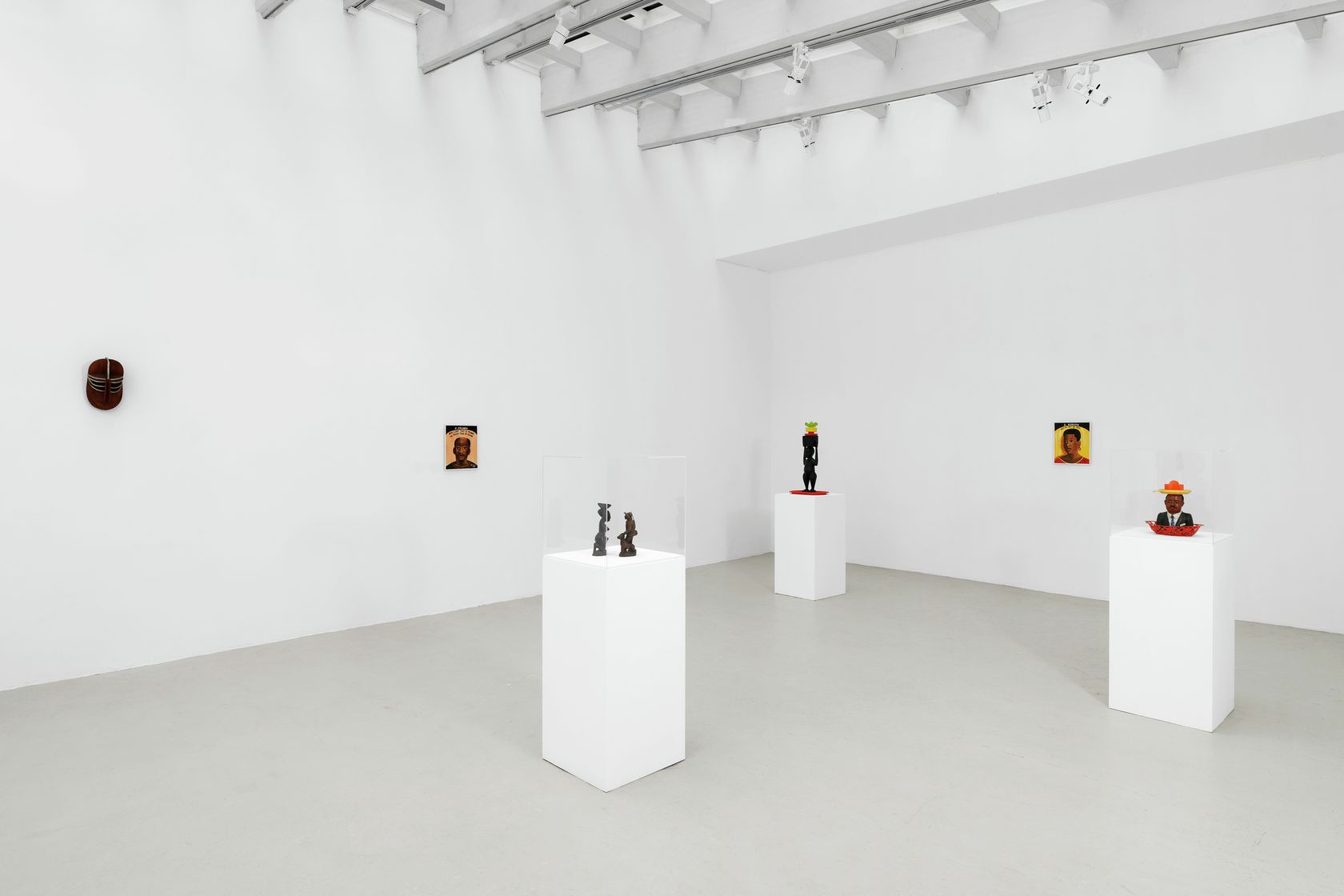

- Présence Panchounette
- Neo Pevsner ou Retour à l’envoyeur , 1985
- Exotic wood and iron (by a traditionnal African sculptor in Conakry, Guinea)
-
- 37 ×
- 20 × cm
- 14 5/8 ×
- 7 7/8 × inches
-
Description | Description:
Les masques Neo Pevsner sont une référence directe au célèbre Masque d'Antoine Pevsner, réalisé en celluloïd et en zinc en 1923 et conservé au Centre Pompidou. Pevsner s’était lui-même largement inspiré des masques Lulua du Congo, les objets d’art africains bénéficiant alors d’un très grand intérêt dans les milieux artistiques parisiens des années 1920. Les masques en bois exotique et ferraille de Présence Panchounette ont, eux, été commandés à un sculpteur traditionnel africain à Conakry (Guinée) en 1985. Pour résumer, nous avons donc un masque traditionnel africain, son interprétation par un artiste d’avant-garde européen, puis sa ré-interprétation par un sculpteur guinéen. Ces masques de Présence Panchounette sont emblématiques de leurs œuvres “africaines” qui opèrent des mouvements de ricochets entre continents : interprétation et traduction permettent une joyeuse créolisation à même de critiquer des projections trompeuses. La deuxième partie du titre, Retour à l’envoyeur, est, à ce titre, à la fois très explicite et railleur.
The Neo Pevsner masks refer directly to the famous Masque by Antoine Pevsner, made in 1923 of celluloid and zinc and today part of the Pompidou Center collection. Pevsner himself was heavily influenced by Congolese Lulua masks, as part of the many African art objects that captured the imagination of the Parisian art scene during the 1920s. These masks by Présence Panchounette, made of exotic wood and scrap metal, were commissioned in 1985 from a traditional African sculptor in Conakry (Guinea). To sum up, we have traditional African masks, interpreted by an avant-garde European artist, whose work has been reinterpreted by a Guinean sculptor. These masks by Présence Panchounette are typical of their “African” works, ricocheting between the two continents: the various stages of interpretation and translation result in a joyful creolization, quite capable of rebuffing any misleading projections. The second part of the title: Retour à l’envoyeur (Return to Sender), is in this respect both explicit and derisive.
Expositions | Exhibitions:
• Section Africaine, Semiose, Paris, exhibition from November 20, 2021 to January 1, 2022
• Présence Panchounette is not dead, CIAM La Fabrique, Toulouse, exhibition from May 9 to June 26, 2019
• Less is Less More is More, that's all !, CAPC, Bordeaux, exhibition from May 30 to September 14, 2008
• Gandy Gallery, Prague,1993
• Banlieues Sud - Expressions d’Afrique, CRAC Midi-Pyrénées, Labège-Innopole, Castanet-Tolosan, exhibition from December 13, 1986 to January 30, 1987
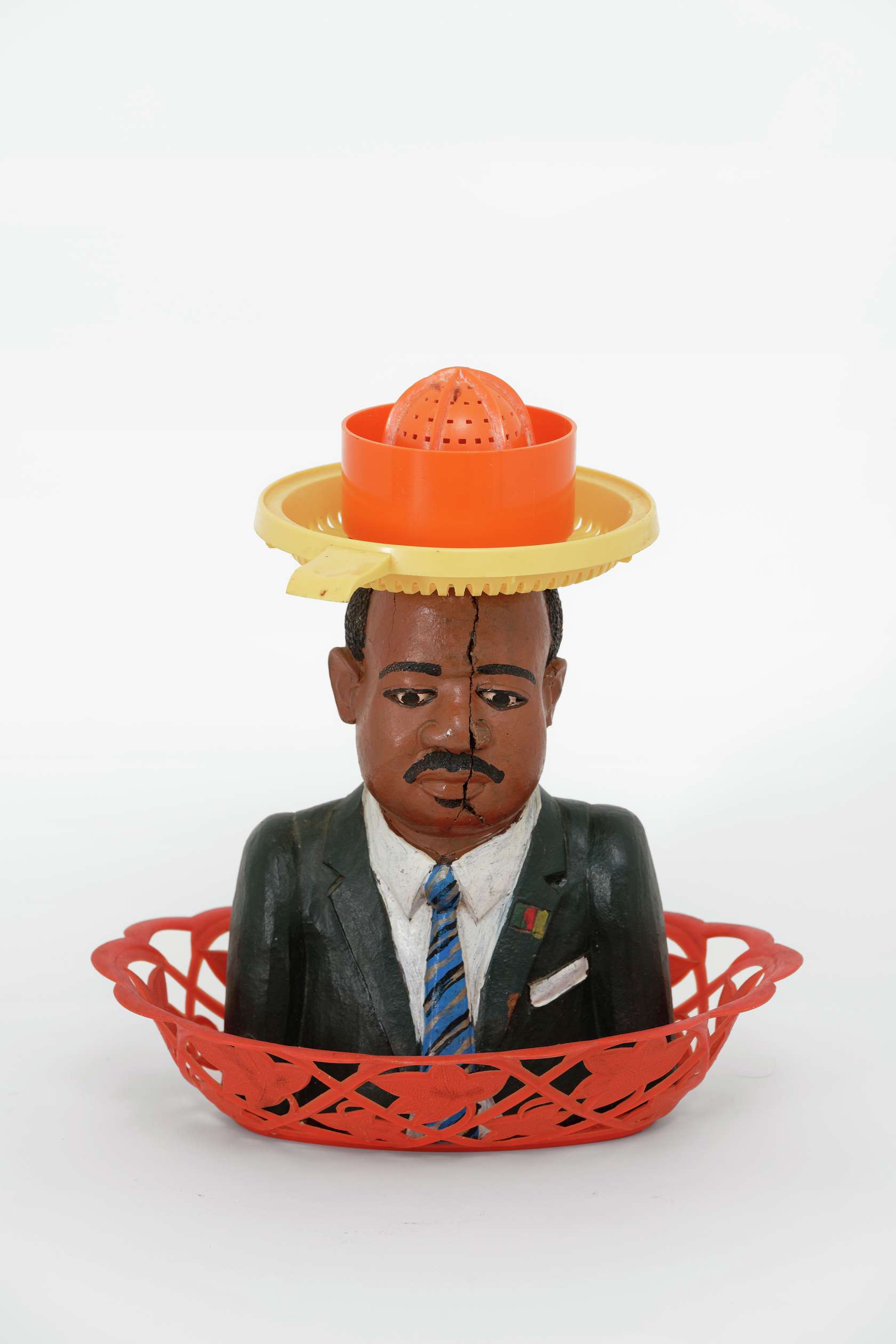
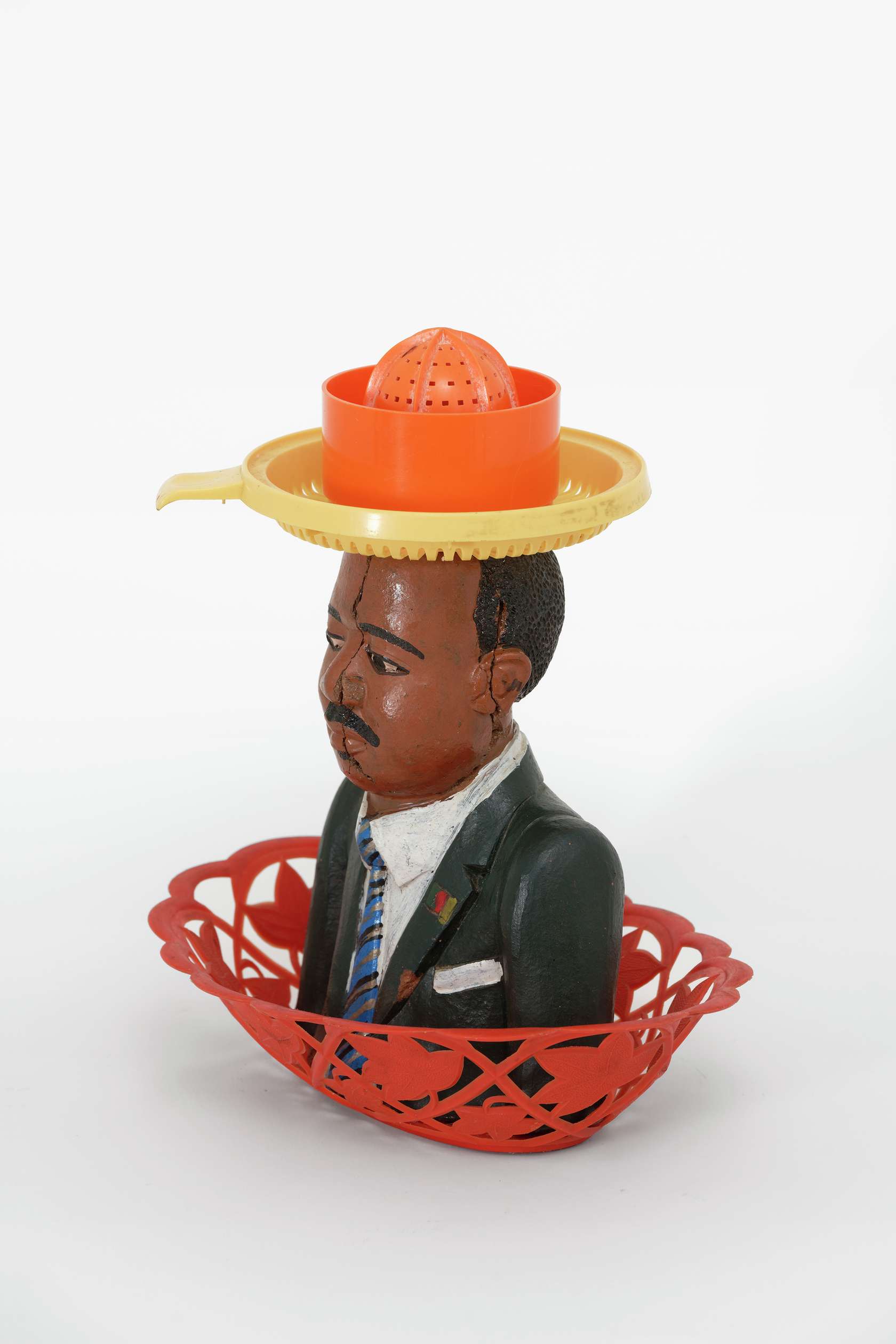
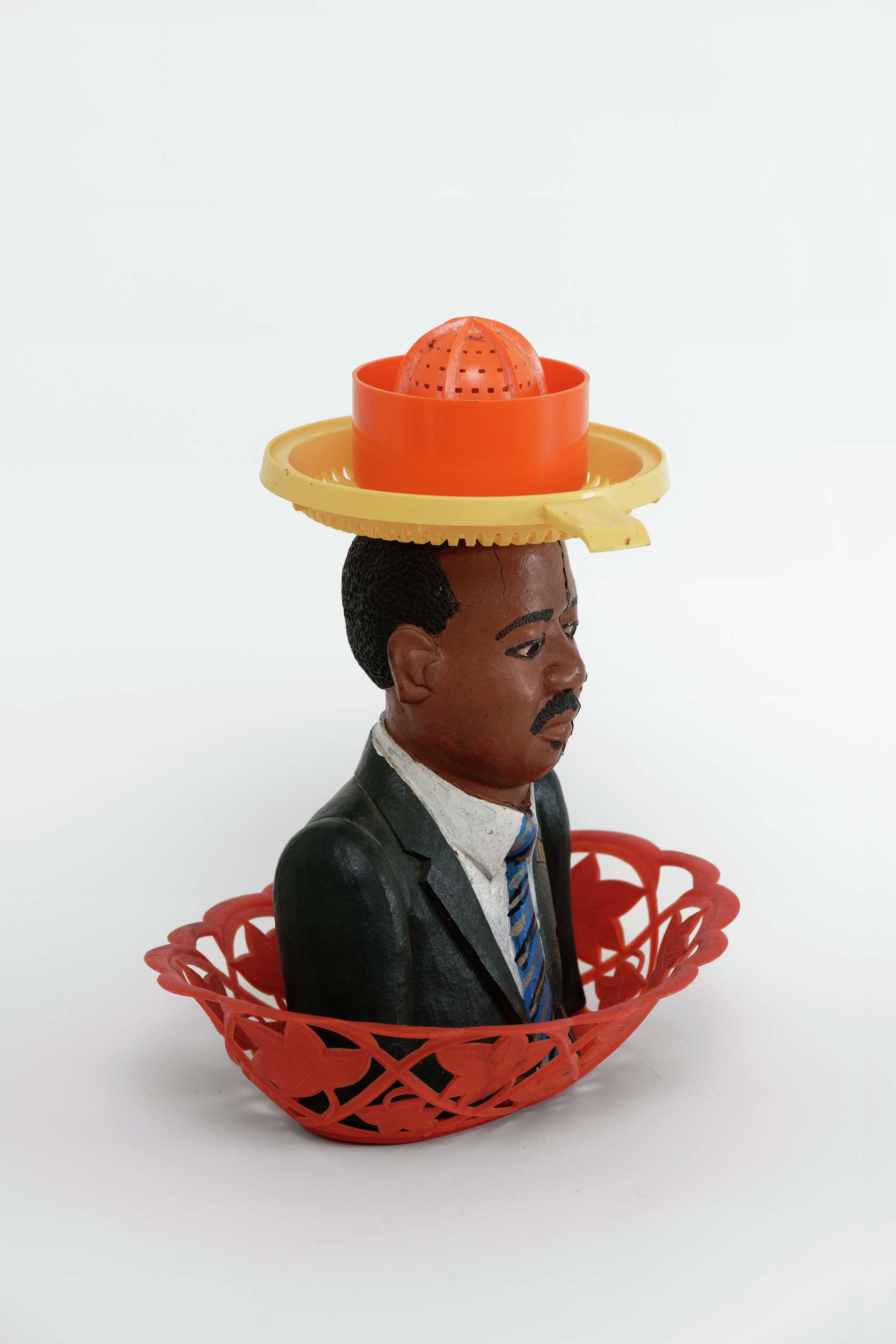
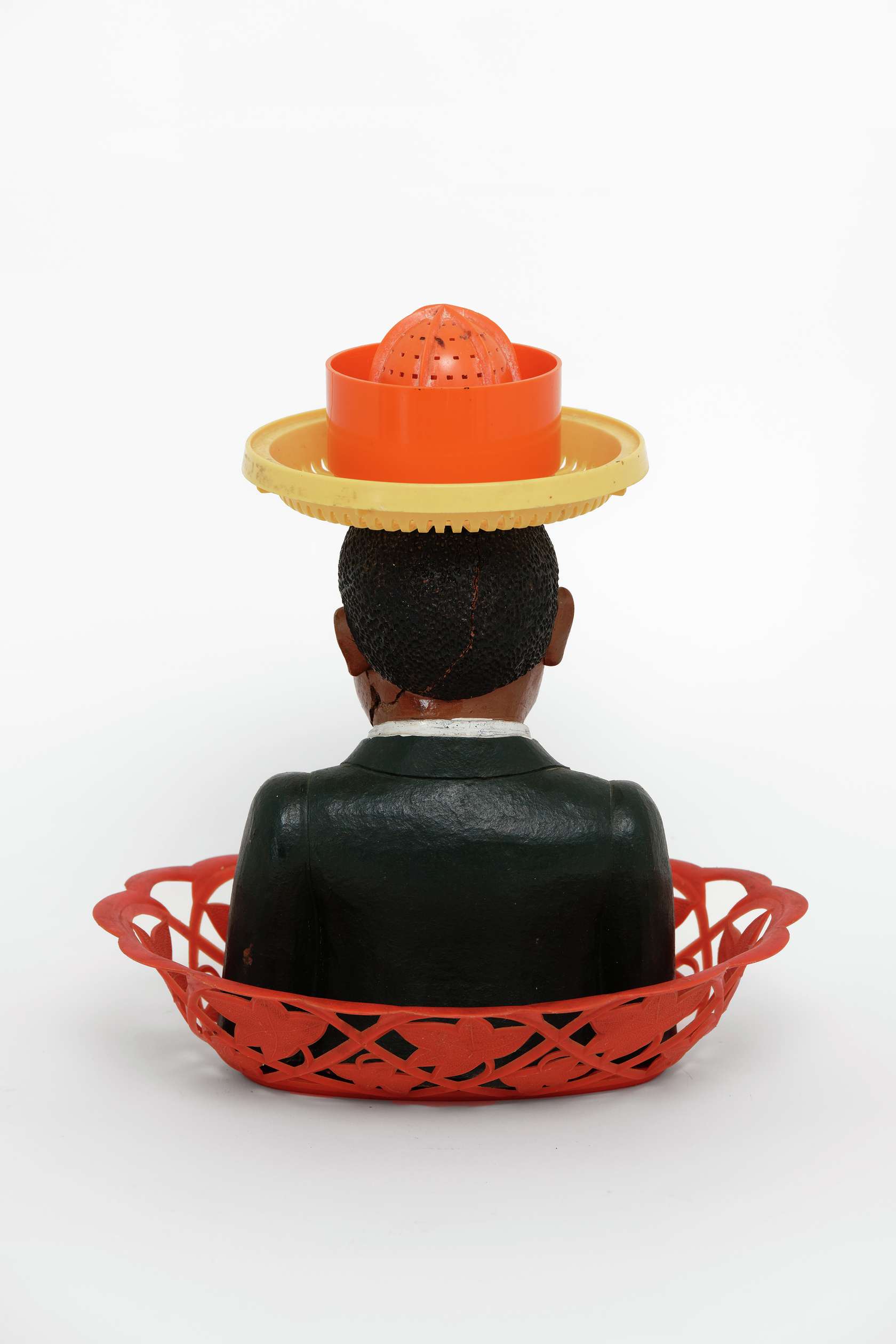
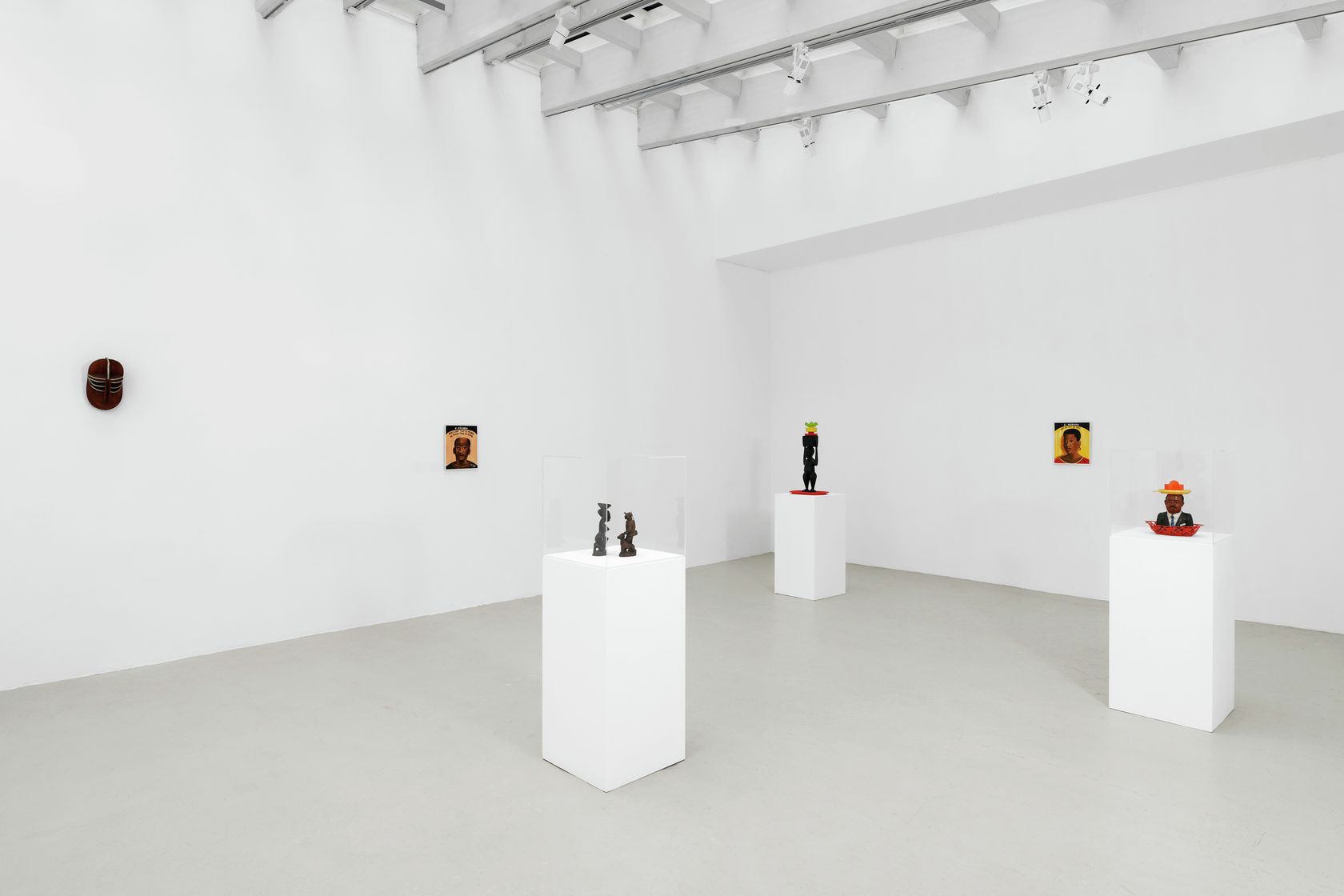
- Présence Panchounette
- Artiste pressé d'exposer , 1989
- Painted terracotta sculpture, lemon squeezer and plastic basket
-
- 29 ×
- 31 × cm
- 11 7/16 ×
- 12 3/16 × inches
-
Description | Description:
Cet assemblage d’objets de différente nature liés par un titre en forme de jeu de mot, est le prétexte à une boutade sur le milieu de l’art contemporain. “Artiste pressé d’exposer” est figuré par un presse-citron et joue sur l’homonymie du mot "presser". L’homonymie – comme d’autres figures de style : exagération, raccourci, équivalence, parodie – fait partie des figures récurrentes du vocabulaire de Présence Panchounette. Enfin, soulignons que cette œuvre est toujours d’actualité, puisqu’elle est constituée d’une statuette trouvée sur un marché représentant le président de la République du Cameroun, Paul Biya, qui se maintient en fonction depuis 1982.
This assembly of objects of distinctly different natures, held together by a title in the form of a play on words, is the pretext for a joke at the expense of the world of contemporary art. The title plays on the homonymy of the word “pressé”, which in French means both “in a hurry” and “squeezed”. Thus, in English the title would be Artist in a Hurry to Exhibit. Homonymy, alongside other stylistic devices such as exaggeration, ellipsis, parody etc., is an integral and recurring feature of Présence Panchounette’s artistic vocabulary. It’s important to note that this piece is still relevant today, as Paul Biya, represented by the bust originally found on a local market, is still the President of the Republic of Cameroon, an office he has held since 1982.
Bibliographie | Bibliography:
• DELAURY, Vincent, “L'Actualité des galerie, Présence Panchounette”, L'Oeil, n°749, Décembre, 2021, Repr. p. 110.
Expositions | Exhibitions:
• Section Africaine, Semiose, Paris, exhibition from November 20, 2021 to January 1, 2022
• Présence Panchounette is not dead, CIAM La Fabrique, Toulouse, exhibition from May 9 to June 26, 2019
• Less is Less More is More, that's all, CAPC, Bordeaux, exhibition from May 30 to September 14, 2008
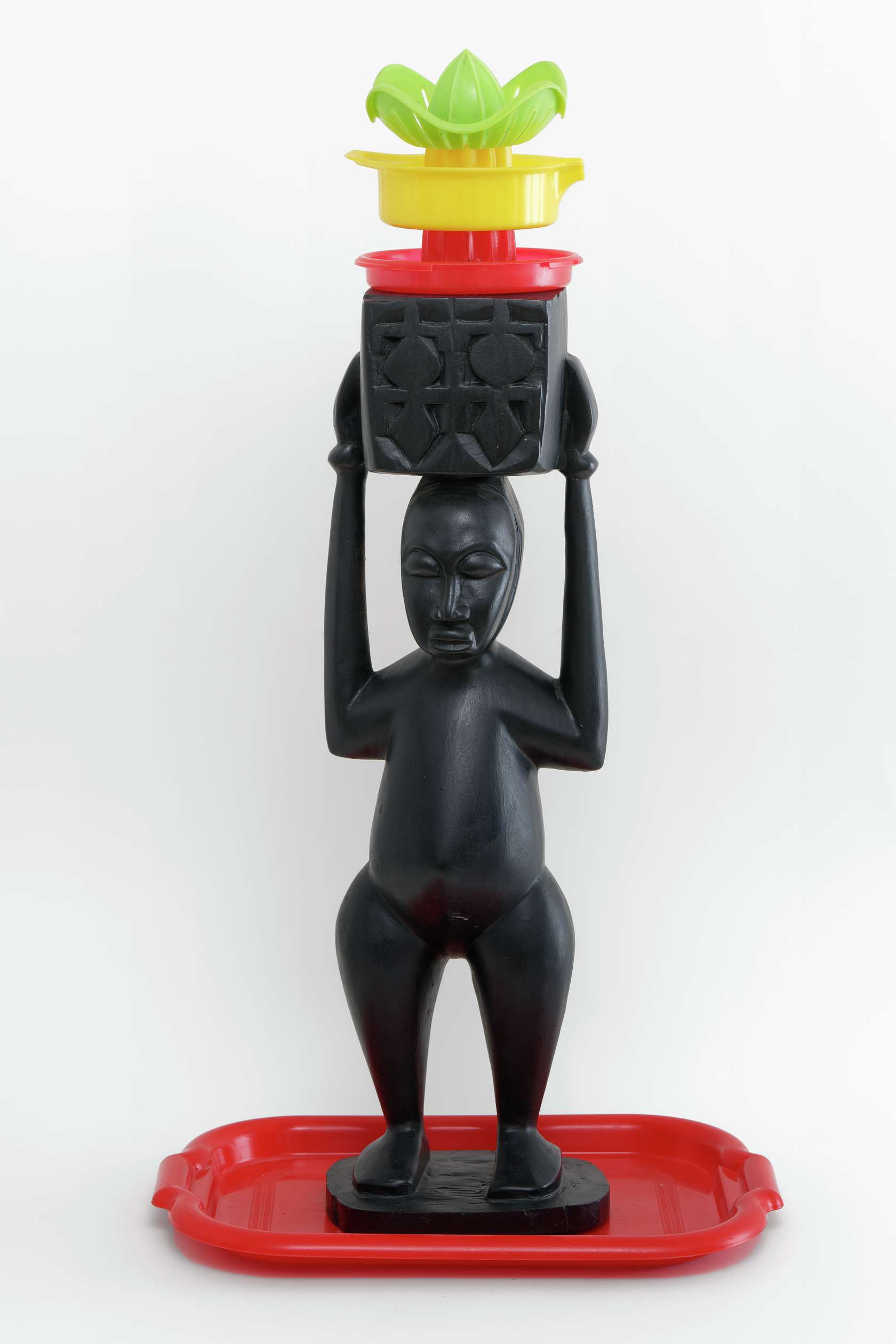
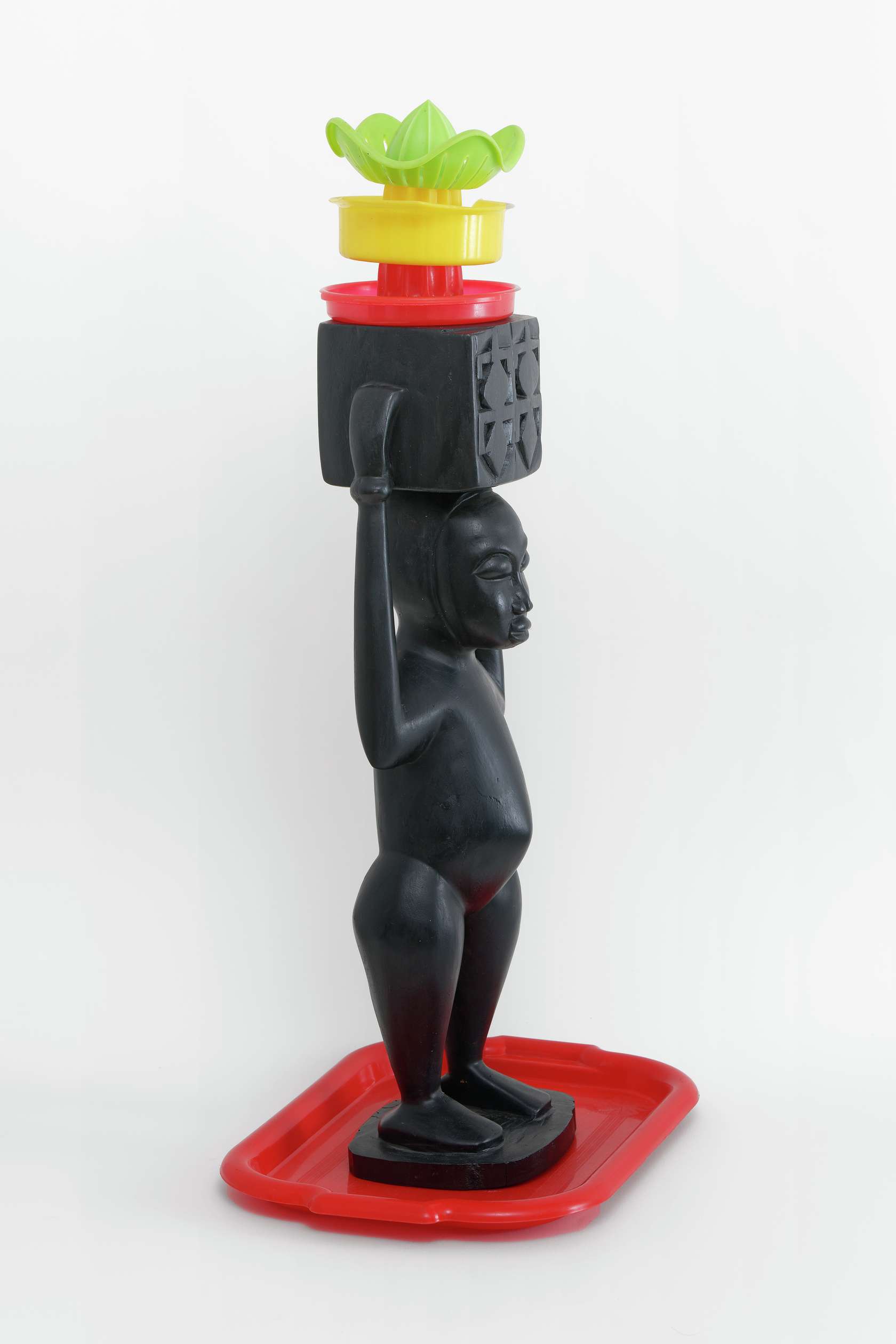
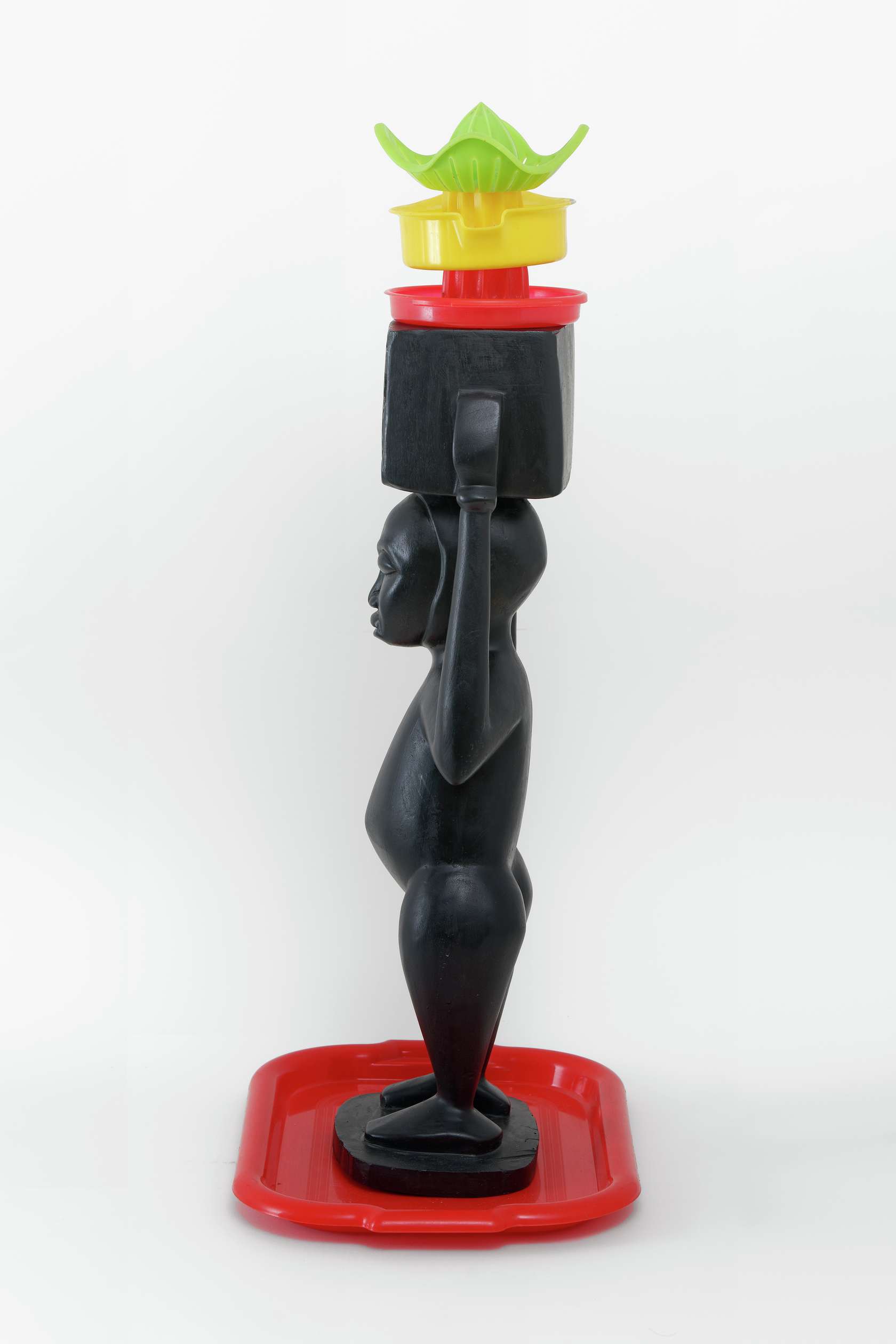
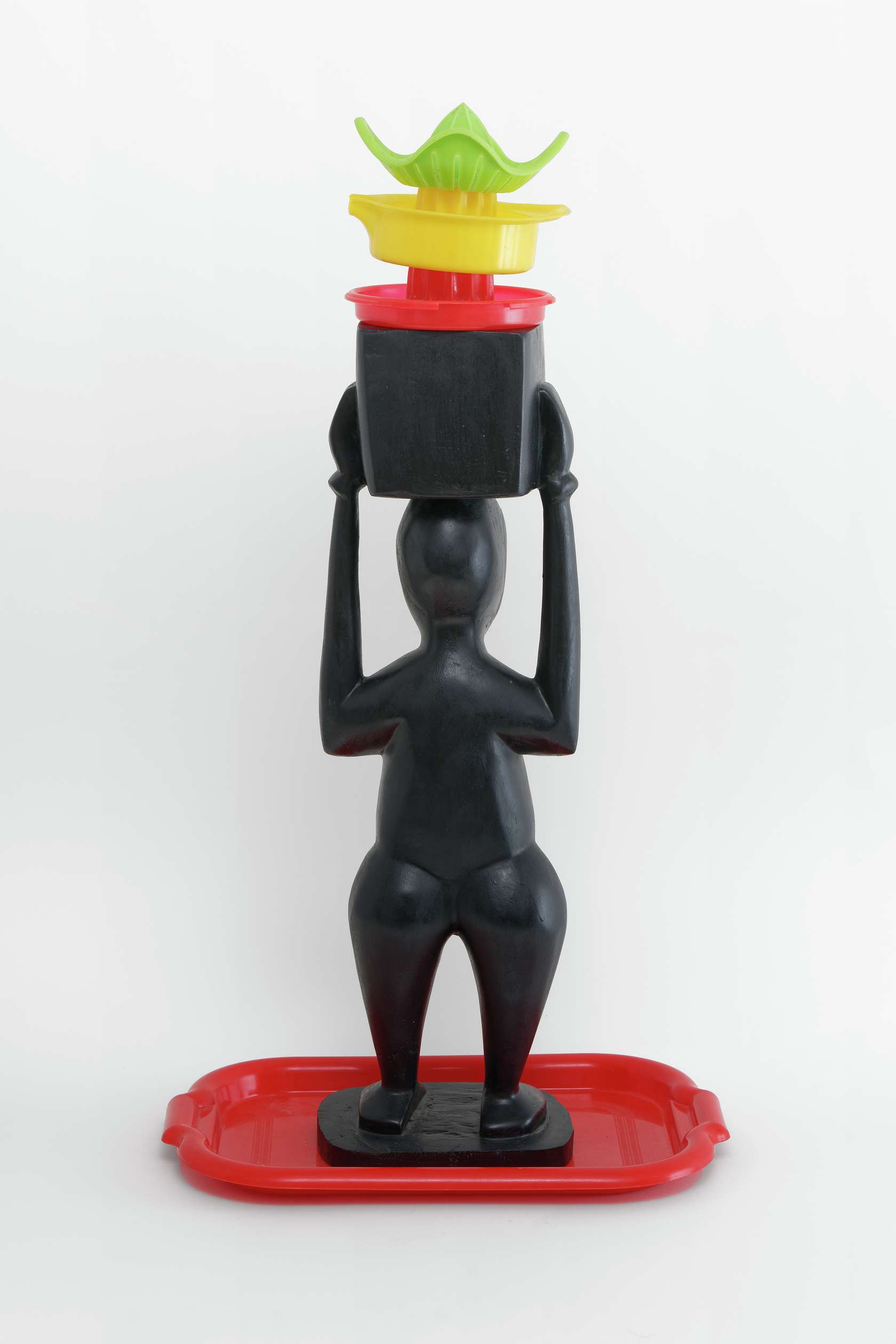
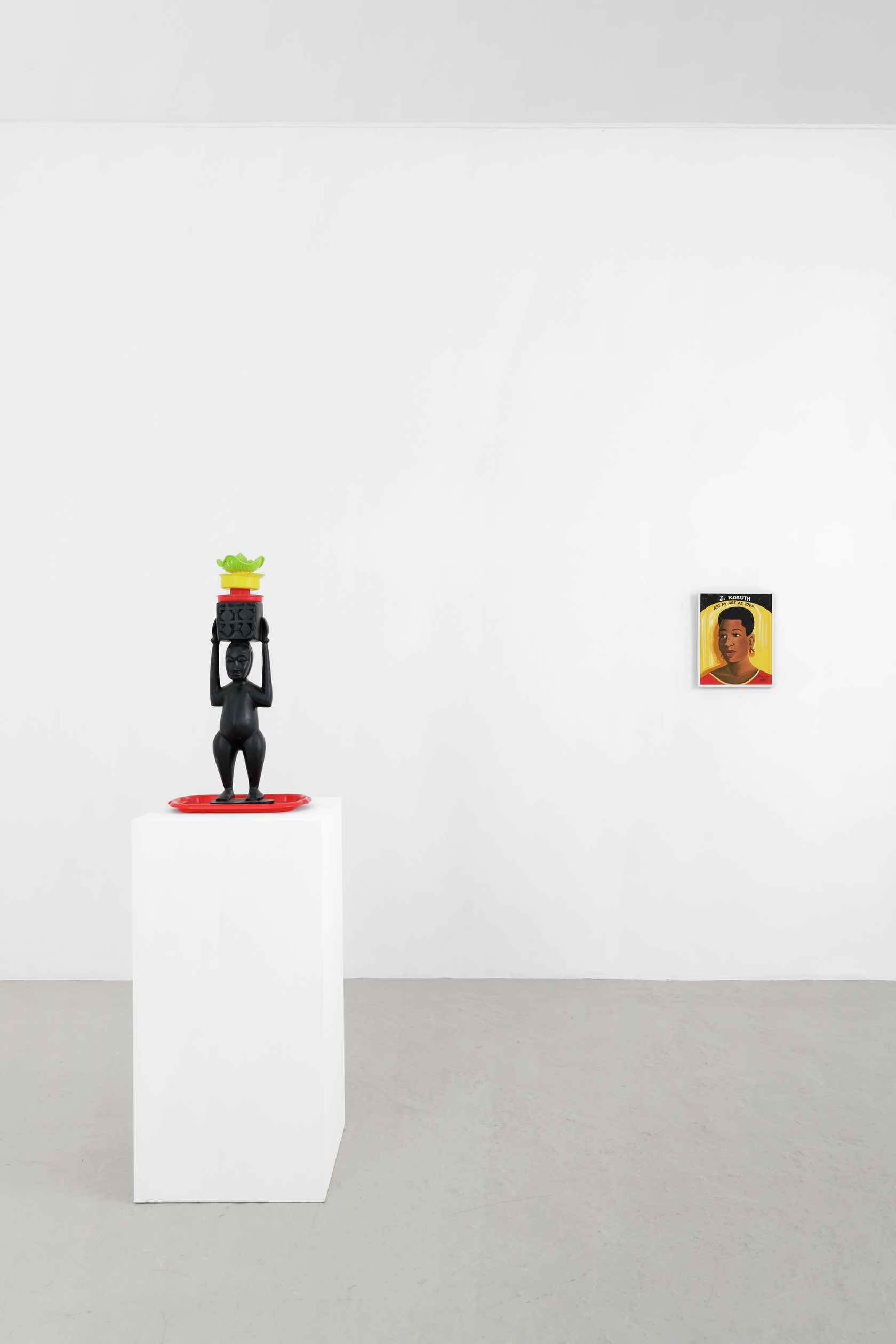
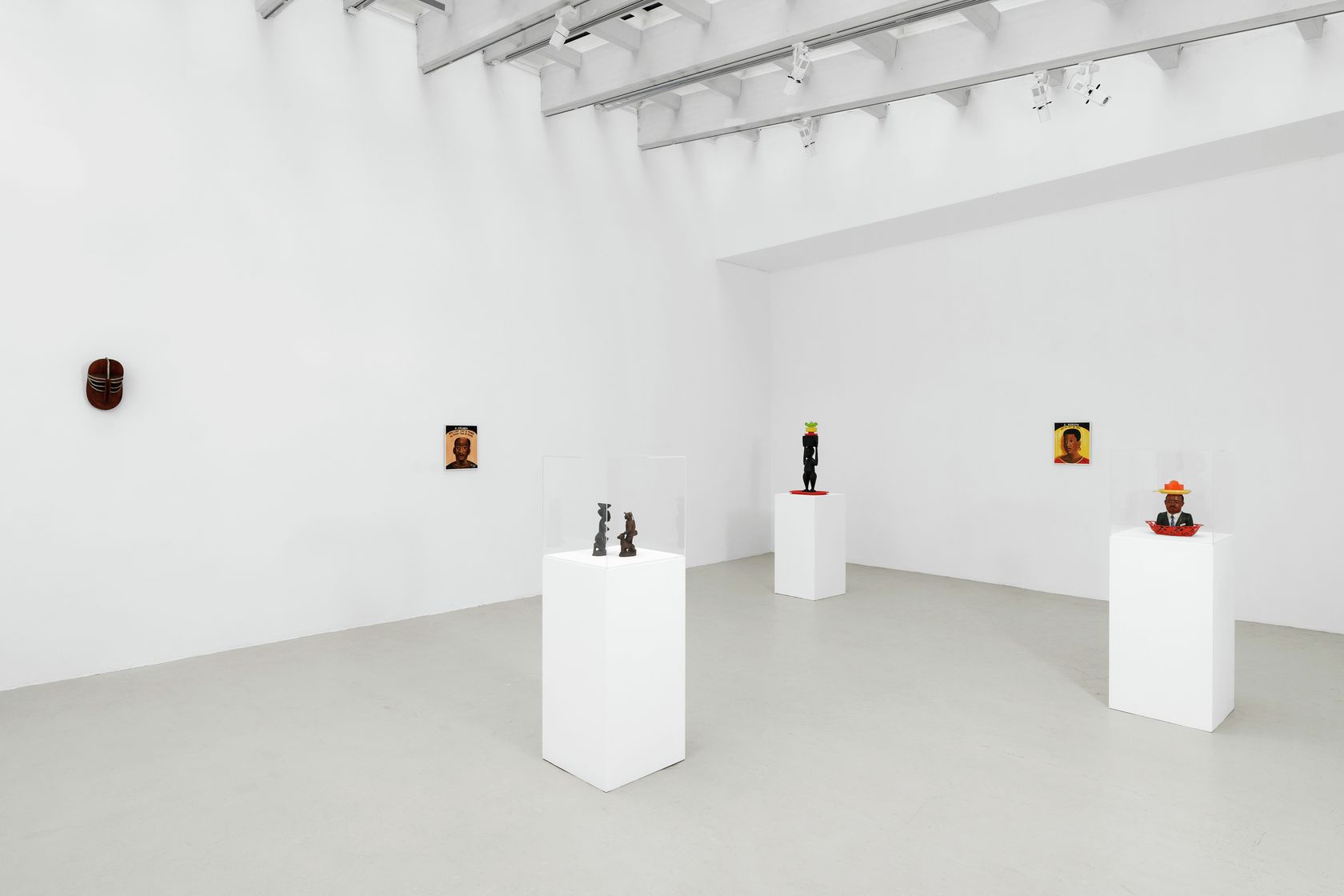
- Présence Panchounette
- Sénoufaux I , 1985
- Teak sculpture, glycero paint and plastic elements
-
- 60 ×
- 40 ×
- 20 × cm
- 23 5/8 ×
- 15 3/4 ×
- 7 7/8 × inches
-
Description | Description:
L’œuvre Sénoufaux I procède d’un assemblage d’éléments hétéroclites, interrogeant la nature et la valeur des éléments qui la constituent. D’un côté, une sculpture en teck repeinte, non signée, dont le style n'appartient à aucune tribu en particulier ; de l’autre des objets utilitaires en plastique de couleur vive, qui surmontent la sculpture ou lui servent de socle. Le tout forme une sorte de nouveau totem, faux à tous les étages, comme le souligne son titre Sénoufaux, mais vrai quant au jeu de mot avec le nom d’une ethnie bien réelle du nord de la Côte-d'Ivoire (Sénoufo).
Sénoufaux I is assembled from a number of heterogeneous objects and brings into question the nature and value of its various constituent elements. On one hand we have an unsigned, repainted teak sculpture, which does not fit in with the styles used by any particular tribe, and on the other hand, various utilitarian objects made of brightly colored plastic, which are carried by the figure and serve as its base. The whole results in a new form of totem, which is false on every level as its title Sénoufaux underlines (faux meaning false in French). Sénoufaux is also a play on words with the name of a very real ethnic group—the Senufo— from the north of the Ivory Coast.
Publications :
• DEBAILLEUX, Henri-François, “L'esprit de Présence Panchounette”, Le Journal des Arts, December 10th, 2021, Repr. p. 33.
Expositions | Exhibitions:
• Section Africaine, Semiose, Paris, exhibition from November 20, 2021 to January 1, 2022
• Présence Panchounette is not dead, CIAM La Fabrique, Toulouse, exhibition from May 9 to June 26, 2019
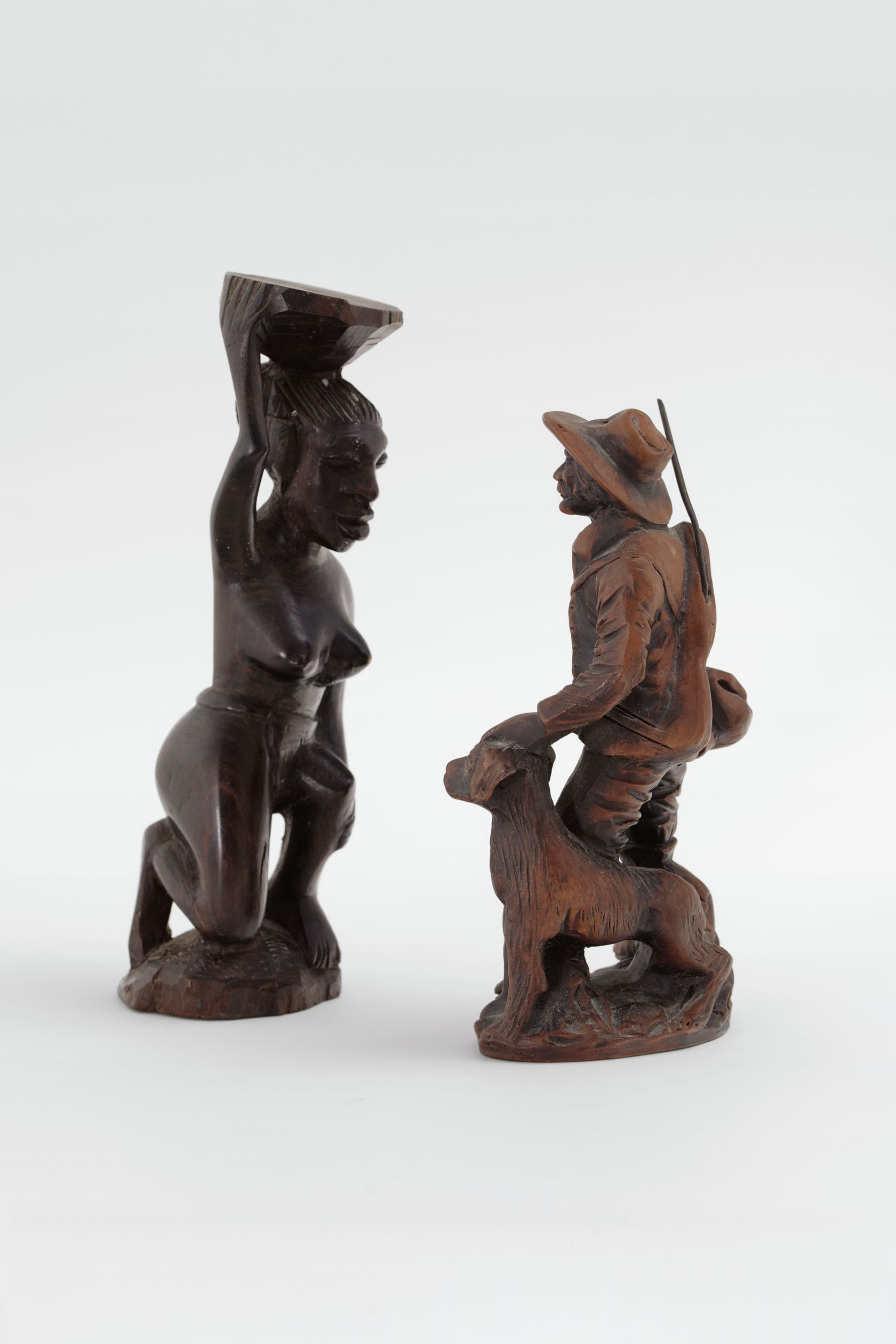
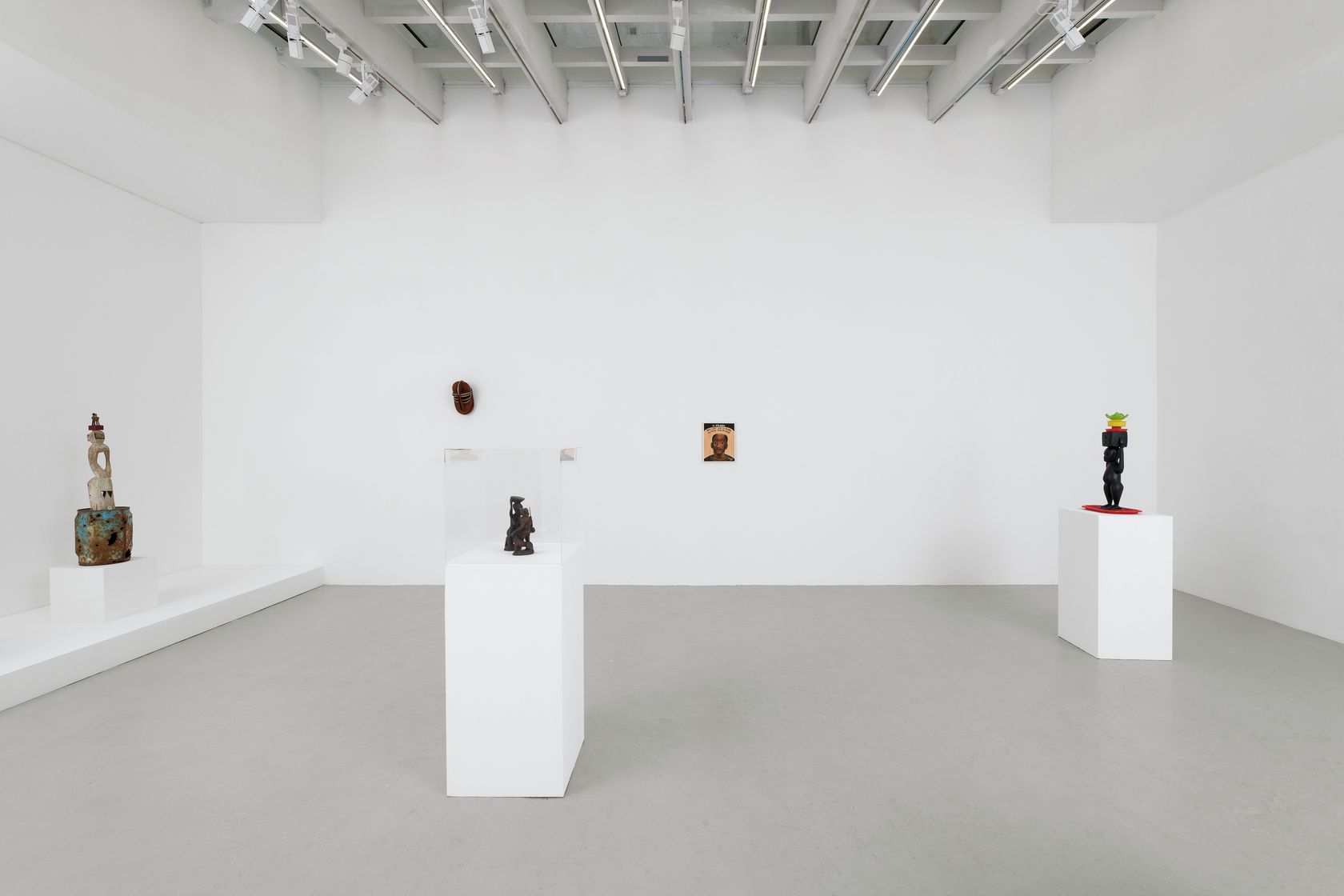
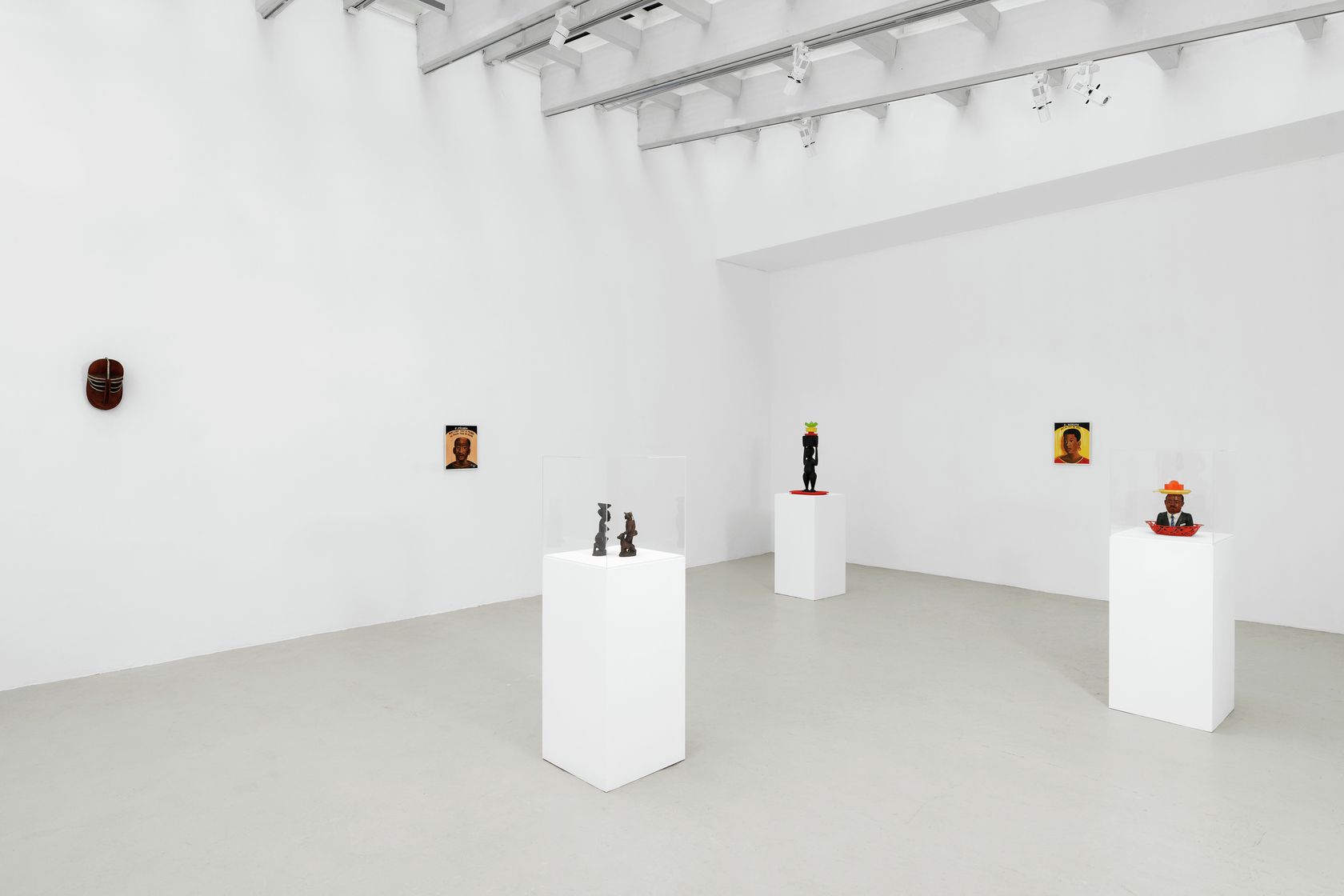
- Présence Panchounette
- Youki, laisse la dame! Tu vois bien qu'elle travaille. , 1985
- Assemblage of two statuettes
-
- 22 ×
- 26 ×
- 10 × cm
- 8 5/8 ×
- 10 2/8 ×
- 3 7/8 × inches
-
Bibliographie | Bibliography:
• CELEUX-LANVAL, Maïlys, “Présence Panchounette et les sept nains”, Beaux Arts Magazine, May 22nd, 2019, online.
• MILLET, Catherine, SOULILLOU, Jacques, “Présence Panchounette”, Pleased to meet you, n°7, Paris, Semiose éditions, 2019, Repr. p. 67.
Description | Description:
Comme souvent chez Présence Panchounette, Youki fonctionne par collage de deux objets trouvés, auquel le titre attribue un contexte narratif. Ici, c’est un dialogue qui explicite la scène entre les protagonistes, une phrase prononcée par le chasseur provençal à l’adresse de son chien : “Youki, laisse la dame ! Tu vois bien qu'elle travaille.” Les deux statuettes sont toutes les deux des objets-souvenirs bon marché reproduisant des topos iconographiques vernaculaires de leur région d’origine, santon provençal pour l’un, statuette africaine pour l’autre.
As is often the case with Présence Panchounette’s art, Youki is based on the combination of two found objects, to which the title lends a narrative context. In this case, a statement explains the encounter between the two characters, a phrase addressed to his dog by the Provençal hunter: “Youki, leave the lady alone! Can’t you see she’s working!”. The two statuettes are cheap souvenirs that reproduce local iconographic themes from their regions of origin: a Provençal santon (terracotta statuette representing village life in the south of France) on the one hand and an African statue on the other.
Expositions | Exhibitions:
• Section Africaine, Semiose, Paris, exhibition from November 20, 2021 to January 1, 2022
• Les nains aussi ont commencé petits, Semiose, Paris, exhibition from May 18 to June 15, 2019
Air Toubab is a composition made up of a painting—a pseudo-impressionist landscape showing village huts with a woman carrying a child on her back and a water jug on her head—and a small ebony sculpture of a plane, labelled with the words “Air Toubab” in white paint. From this clichéd scene of the type produced for tourists travelling in Africa and the simple signifier of a plane, Présence Panchounette uses associative symbolism (the white man flying over an idealized Africa) to settle its score with mass tourism and its ignorance of the realities “on the ground.”
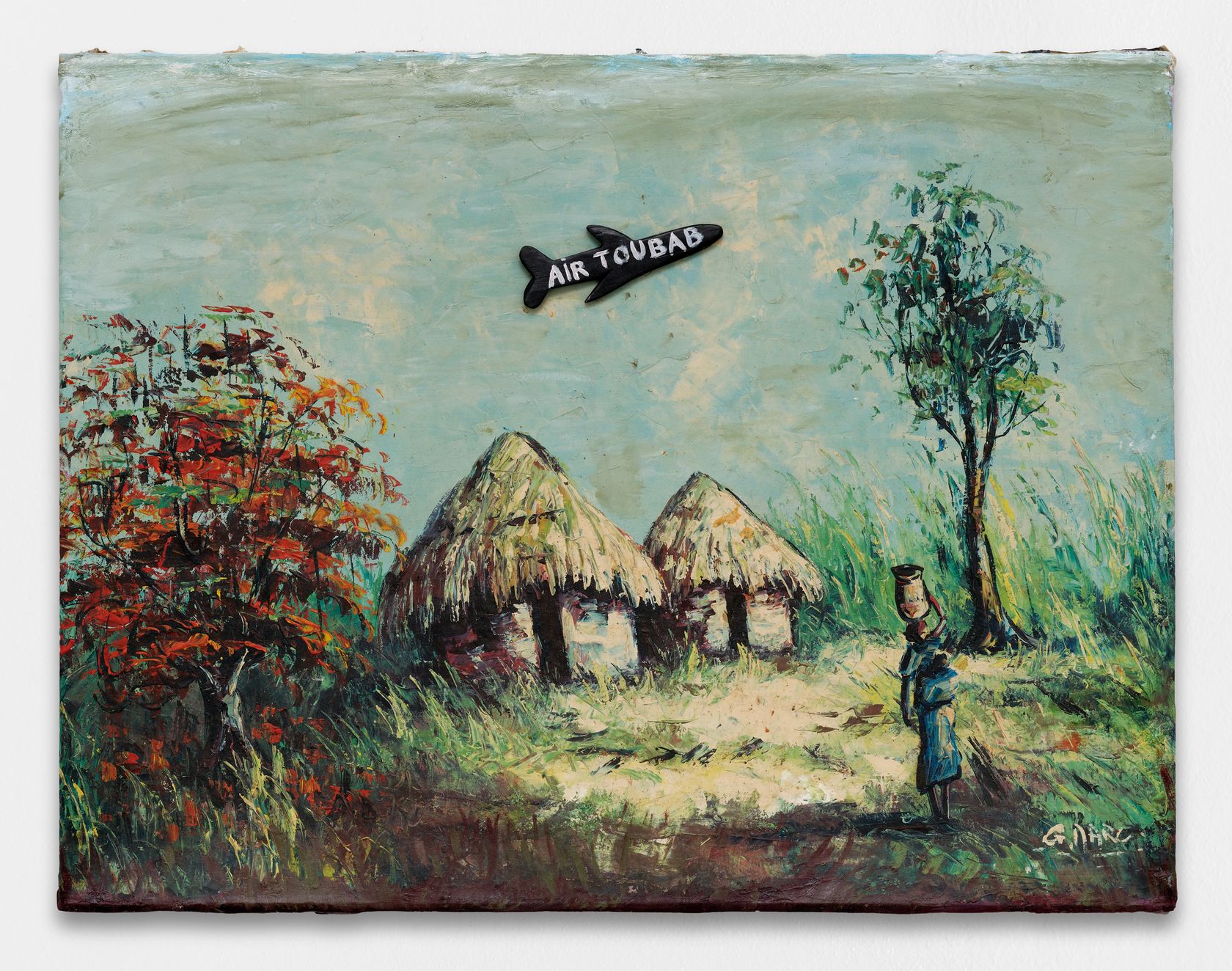
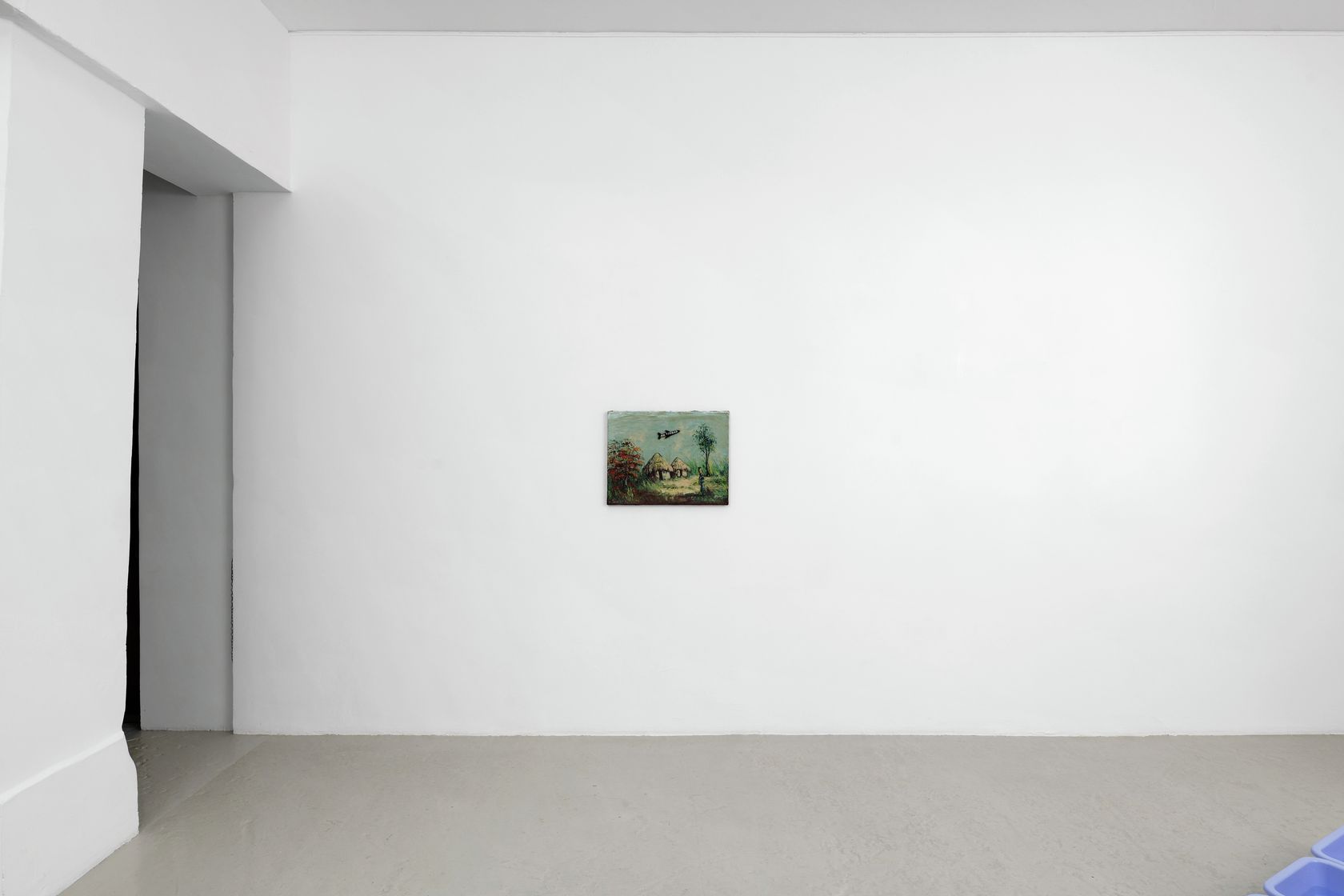
- Présence Panchounette
- Air toubab 2 , 1987
- Oil on canvas and acrylic on wood
-
- 50 ×
- 65 × cm
- 19 11/16 ×
- 25 9/16 × inches
-
Expositions | Exhibitions:
• Section Africaine, Semiose, Paris, exhibition from November 20, 2021 to January 1, 2022
• Présence Panchounette is not dead, CIAM La Fabrique, Toulouse, exhibition from May 9 to June 26, 2019
• Less is Less More is More, that's all !, CAPC, Bordeaux, exhibition from May 30 to September 14, 2008
Description | Description:
Air Toubab est un assemblage composé d’un tableau – un paysage faussement impressionniste représentant des cases et une femme portant l’enfant dans le dos et la cruche sur la tête – et d’un petit avion sculpté en bois d’ébène marqué d’un “Air Toubab” à la peinture blanche. À partir d’un poncif de la peinture pour touristes voyageant en Afrique et d’un signifiant aussi simple qu’un avion, Présence Panchounette procède par symbolisme associatif (“le blanc voyage en avion au-dessus d’une Afrique idéalisée”) et règle son compte au tourisme de masse aussi hors-sol qu’ignare.
Air Toubab is a composition made up of a painting—a pseudo-impressionist landscape showing village huts with a woman carrying a child on her back and a water jug on her head—and a small ebony sculpture of a plane, labelled with the words “Air Toubab” in white paint. From this clichéd scene of the type produced for tourists travelling in Africa and the simple signifier of a plane, Présence Panchounette uses associative symbolism (the white man flying over an idealized Africa) to settle its score with mass tourism and its ignorance of the realities “on the ground.”
“Above and beyond their legendary status, today Présence Panchounette allows us a glimpse of an “oeuvre” in due form. It can be observed close-up, yet with the necessary distance to enable the diffusion of any poetic or political bombs. There is little point in trying to distinguish between major and minor works from those, who long before museums or institutions, invited the minor arts to the table of the avant-garde, denouncing the systems of racial, economic or territorial domina-tion that dominate our cultural consumption. The words eclectic or parodic miss the essential point of Présence Panchounette’s oeuvre, which offers up a heretical vision with absolutely no regard for the rules of art.”
Morad Montazami
Even by today’s standards, Présence Panchounette undoubtedly remains the most elusive yet explosive collective of French artists of the second half of the
20th century, their activity covering the period between 1968—a year marked by all manner of subversion—and 1990, when Nelson Mandela was finally liberated in South Africa. This association of malicious wrongdoers boasts twenty-two years of relentless attacks against the academic nature of the avant-garde, then bourgeois elitism of the contemporary art scene and even against themselves—going as far as practicing self-sabotage to avoid any form of appropriation of their ideas or political ambiguity.
Between 1969 and 1990, the Présence Panchounette collective banzaï-attacked the art world with an onslaught of press releases, fliers, irreverent mailing and butthead deeds. Primally active in Bordeaux, the group spread its action on to the international art scene, whose aesthetic hypocrisies and ideological taboos it pinned down with jovial ferocity. Celebrating the “chounette spirit”, they promoted an apologia of the worst, riding on a real trivial pursuit, supporting the vulgar versus the seriousness of “modernity”. Présence Panchounette would stand out, fighting against the values and tastes championed by the most influential cultural circles of that time. But, bad omen, the bravado of the Bordeaux-based collective would also anticipate movements born in the Eighties, like Appropriation and Neoconceptual art, which, as such, would find their place gently and comely in the historical official bios or genealogies. Concerned with not smothering its verve in the pernicious Pandora trunk of compromise and mendacity, Présence Panchounette turned its back on honours and remained stone deaf to the attracting songs of institutional sirens, until it announced its disbanding in 1990.
In 2008, the CAPC in Bordeaux hosted the first comprehensive survey of Présence Panchounette's work, followed more recently by the retrospectives held at the Garage Cosmos in Brussels, the Lieu Commun and the CIAM La Fabrique in Toulouse. Their works have been shown at Musée national d’art moderne - Centre Pompidou, Musée d’Art Moderne de la Ville de Paris, Paris (FR), Power Station of Art, Shanghai (CN), Kunsthalle Darmstadt (DE), KANAL- Centre Pompidou (BE), MAMCO, Geneva (CH), CAPC, Bordeaux (FR). Their works are held in the collections of the Musée national d’art moderne - Centre Pompidou, Musée d’art moderne de la Ville de Paris, Fondation Cartier, Paris (FR), MAC VAL, Vitry-sur-Seine (FR) and numerous FRACs.
